
- Disclosures


How to Visit North Korea’s DMZ Border (Updated 2023)
A s controversial a place as North Korea is, it's swiftly gaining attention from the curious tourist eye. Our intrigue to see it was piqued during a visit to Seoul with friends. Having now taken the DMZ tour ourselves, this highly informative if not haunting experience is one we would highly recommend . So, if you've got guts and a desire to get a snippet into one of the most closed countries on earth, here's how to do it!
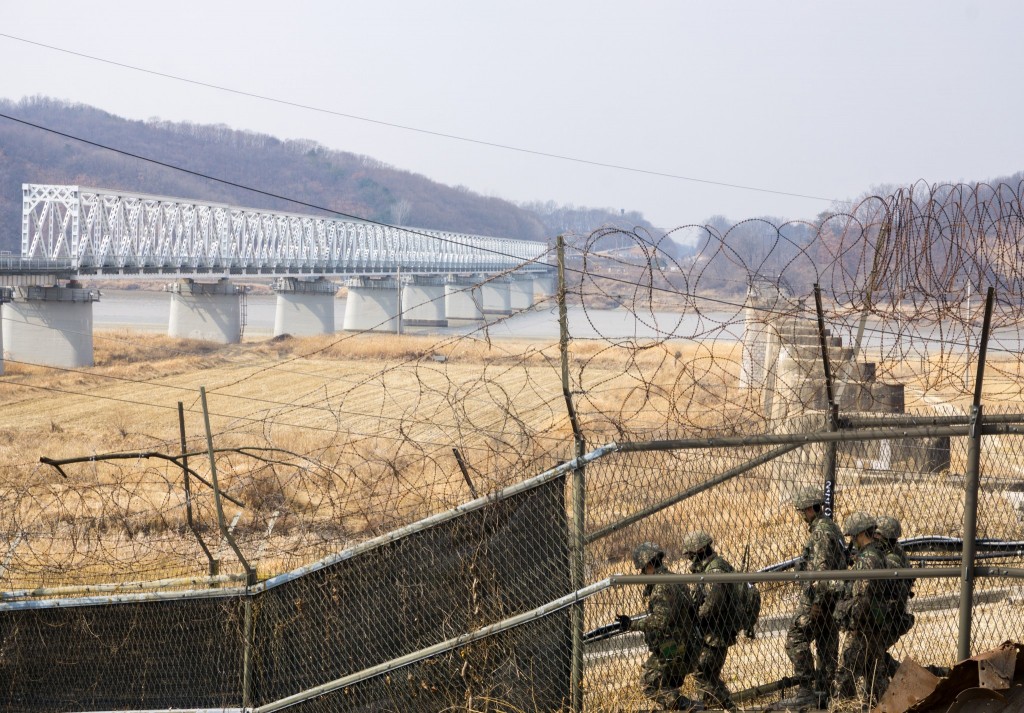
Getting there & where to stay
First, you need to get yourself to Seoul, which is the nearest major city to the DMZ border. South Korea is only reachable by flight, with most planes flying into Incheon International Airport. Use Skyscanner and search by entire month to see the cheapest dates to fly. Be sure to check our flight booking hacks here to get yourself the best price. And don't forget to book your airport transfer and a 4G Data SIM card before you land!
A fast way to get a big discount on your flight is to sign up for the Chase Sapphire Preferred credit card. This card offers a massive sign-up bonus of 60,000 bonus points (worth $750 ) after spending $4,000 in the first 3 months. United and Singapore Airlines are both partner airlines of this card, and both offer flights to Seoul, meaning you can convert your points to these airline loyalty programs, or just book directly through Chase Ultimate Rewards.
Seoul is a buzzing megacity with plenty of enticing accommodation options. There are plentiful AirBNBs and hotel selections, but be sure to reserve ahead in peak season. Some convenient neighbourhood options include Hongdae, Itaewon, Myeongdong, Gangnam, and Jamsil. Check TripAdvisor for more local tips and advice.
There is plenty to explore in Seoul itself, and a local guide can help ensure you catch the best of the best. Be sure to check out the Gyeongbok Palace & Temple , or grab the Seoul Pass , which grants free entry to 65 attractions and discounted entry to 101 more.
How to visit North Korea's DMZ Border:
Step 1. choose your points of interest.
There are several companies that operate DMZ tours. As much as I despise group tours, you can only visit the DMZ with a tour , as it has restricted civilian access and requires a mandatory military escort.
No two tours are the same, but you should choose one based on your budget, customer reviews, and points of interest that are included. Tours can be browsed with reviews, prices, and instant confirmation through Klook , GetYourGuide and Viator . The main highlights to select from are as follows:
The Joint Security Area (JSA)
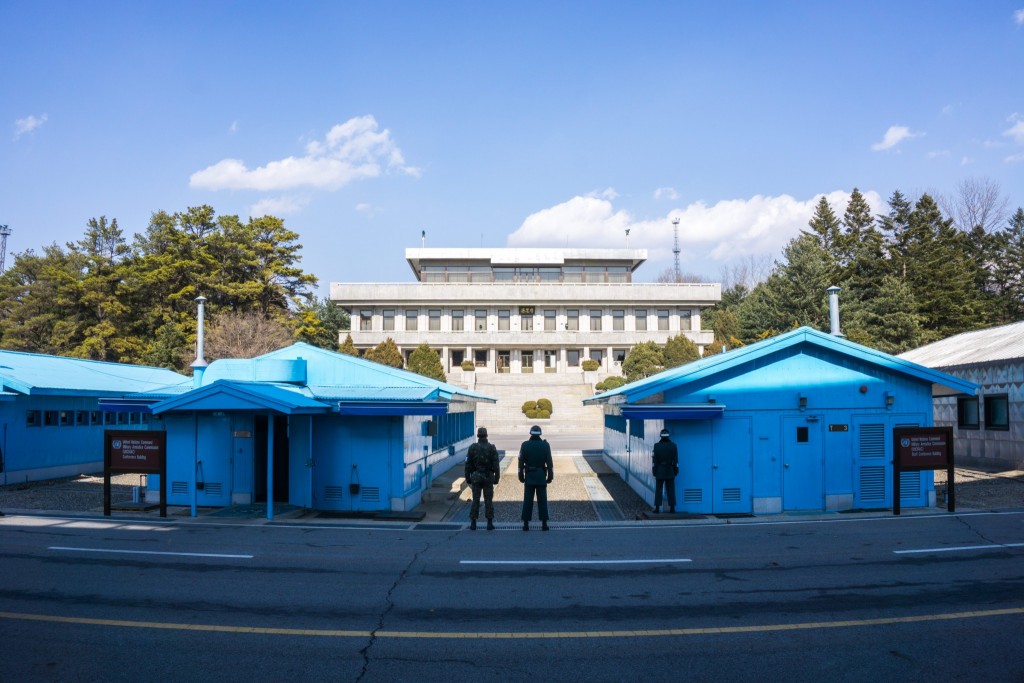
Located in Panmunjom, the JSA is the closest point a tourist can get to North Korea . At this spot, you'll have a chance to physically stand in North Korea itself and take a photo as proof (more on that below). This area is occupied by the South Korean and US military, and is complete with a gift shop selling original items from North Korea, including stamps, money, and wine (which in our experience tastes like nail polish remover and turpentine but hey, at least you can say you tried it).
NOTE: As of 2023, the JSA is still closed to visitors due to COVID, and is not included in any tours.
Odusan Unification Observatory
One can safely view day-to-day life in North Korea without setting foot in the country at Mt Odu Observatory. Binoculars (free of charge) provide ultra zoomed up views of North Korea opposite the Han river below. On our visit we were able to see civilians walking around on the other side.
Infiltration Tunnels
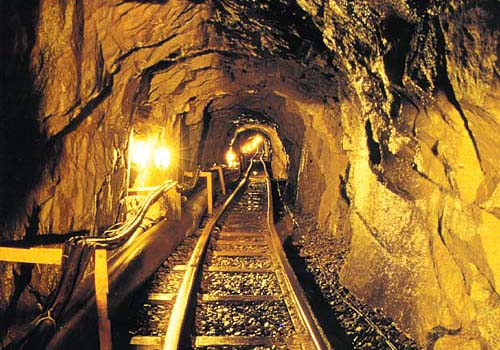
Scarily enough, around the time that the North and South were having peace talks, North Korea began digging underground tunnels to infiltrate the South. They were never completed, but were discovered in 1984. The longest tunnel is 1,082 metres. The 3rd tunnel is the closest to Seoul (only 44km away) and could move ~30,000 troops and artillery per hour.
Dora Observatory
This observatory offers binocular views of North Korea's fake town, Kijong-dong. The town was first built in the 1950's to lure South Koreans to defect and move across the border. From visual observations from the South, it has been uninhabited with windowless, incomplete buildings since its construction.
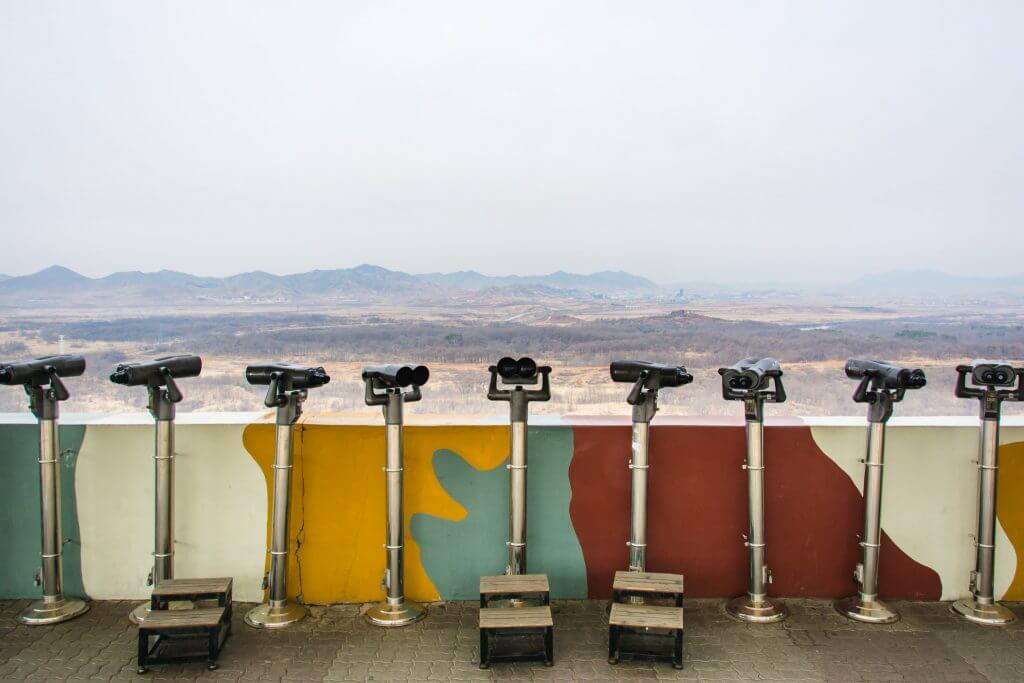
Dora Observatory is so named after Dorasan the mountain on which it sits. The nearest train station has a fully completed train line that runs to Pyongyang. Though the North cooperated in its completion, it was never used. It is hoped that when re-unification is reached, the train line will be used to connect the two Koreas.
Freedom Bridge
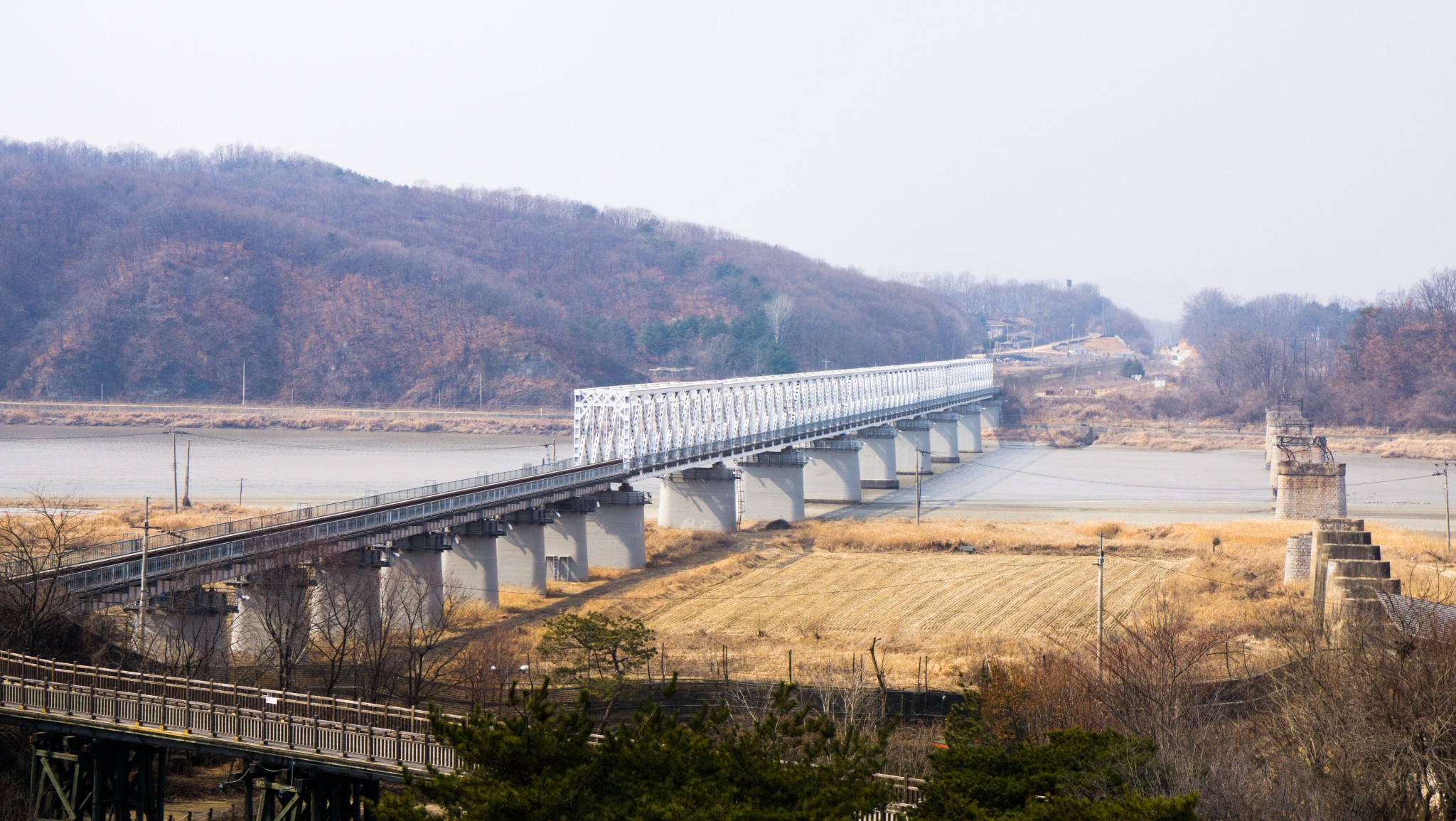
The Freedom Bridge connects North and South Korea, though a massive barricade blocks entry to the connecting point over the river. If the two sides are ever connected, this bridge could be used to enter and exit North Korea.
Step 2. Select a tour
Once you've decided on your must-see highlights (as listed above), you can select a tour.
There are traditional tour companies to choose from, which are listed at the end of this article along with prices and contact information, but it's much easier to book tours online with Klook , GetYourGuide and Viator . You pay in advance and get fast confirmation, so all you need to do is bring your voucher to the tour. There are reviews, photos, and videos that make choosing the right tour simple. The traditional companies require back and forth e-mail or phone communication when booking direct, so Klook , GetYourGuide and Viator are convenient ways to avoid all that hassle.
One of the most popular tours is this day tour on Klook , with more than 50,000 bookings. This is the tour most of our readers have chosen, and is the tour we would select today. Our trip was now several years ago, and at the time we took the Special Panmunjom Tour by Panmunjeom Travel Center which does not visit the tunnels but goes to Odu Observatory and the JSA. This tour offered the chance to speak with a North Korean refugee (defector). This allowed us to learn about how people escape the North, how they adapt to life afterwards, and what knowledge they have of the outside world living in North Korea.
Get $10 USD off your first Klook purchase with coupon code THRIFTY10 (minimum spend $120 USD, new users only)
Here are some of the top-rated tours that can be booked online:
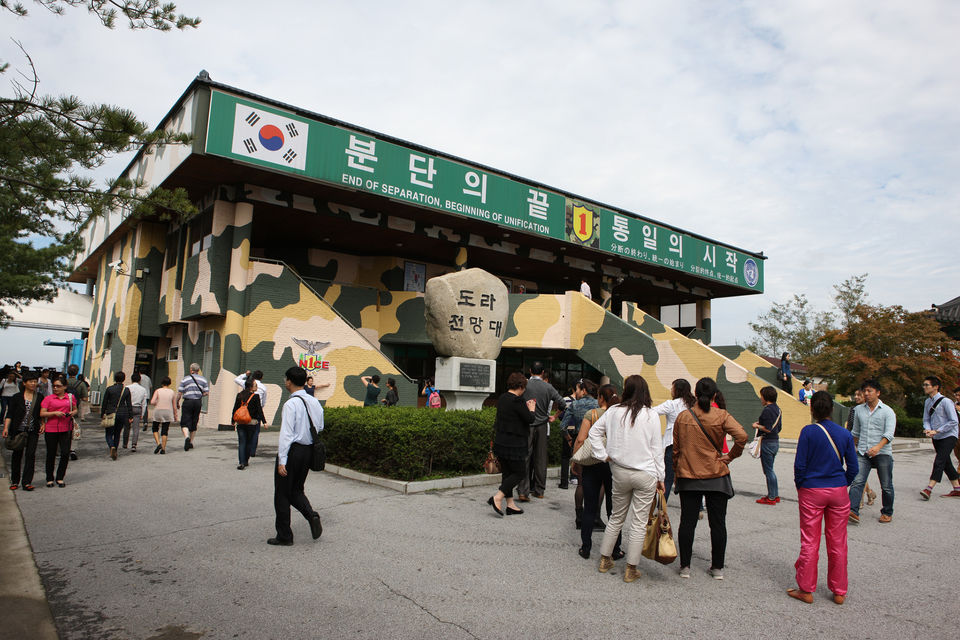
South Korea Demilitarized Zone Half-Day Tour (Bestseller)
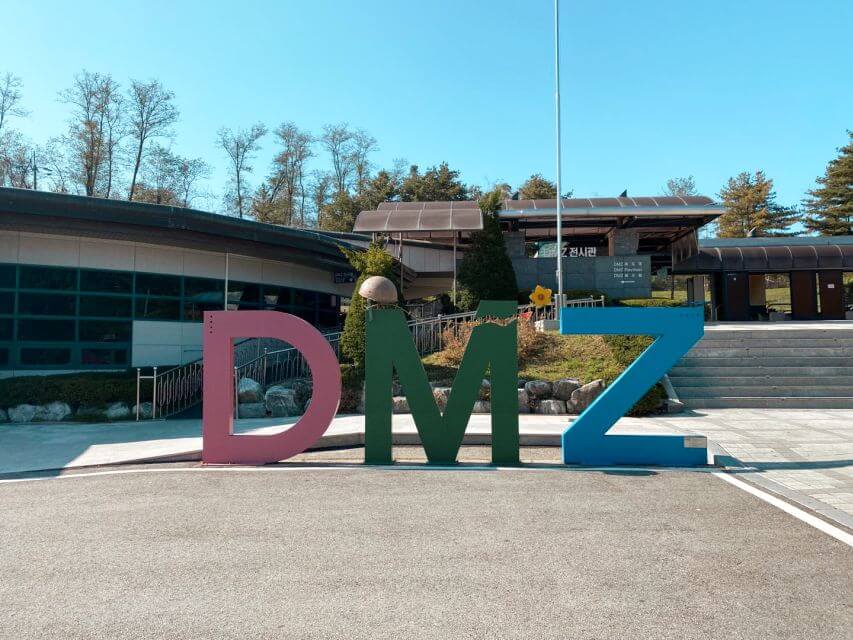
From Seoul: Half-Day Demilitarized Zone (DMZ) Tour
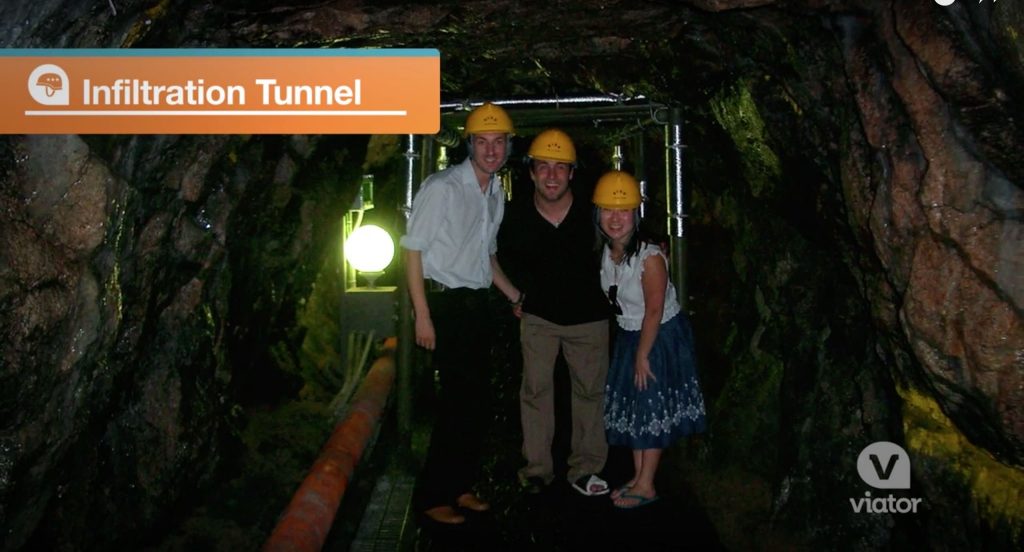
DMZ Past and Present: Korean Demilitarized Zone Tour from Seoul
Step 3. take ( lots of ) photos of north korea.
Much of the road towards the JSA border runs parallel to the Han River, which separates the two countries. It's nothing short of unique to be sitting in a bus with views of North Korea passing by out your window.
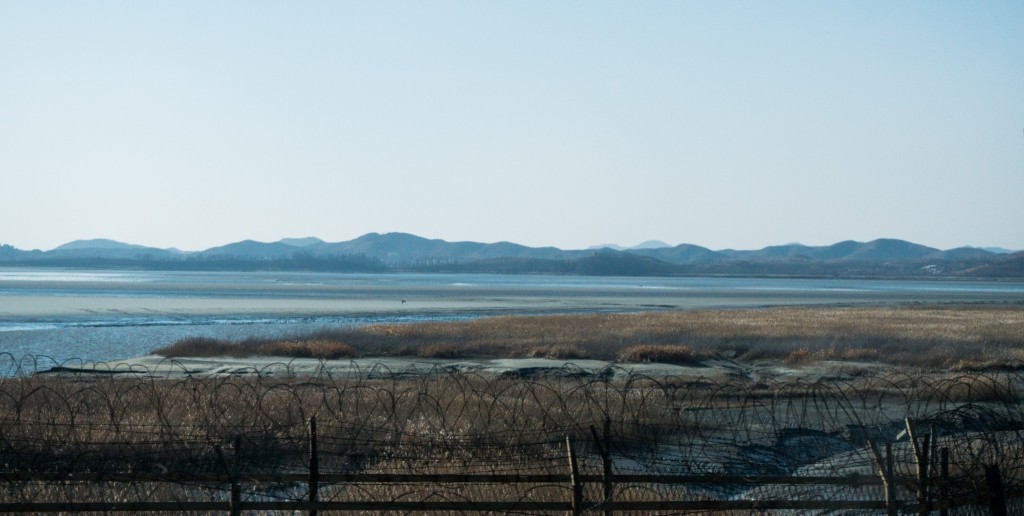
The binoculars at the Dora and Odu observatory provide ultra zoomed views of North Korea. One can even see North Korean civilians walking around on the other side, as we did during our visit at Odu . At Dora Observatory, North Korea's fake town, Kijong-dong, is viewed.
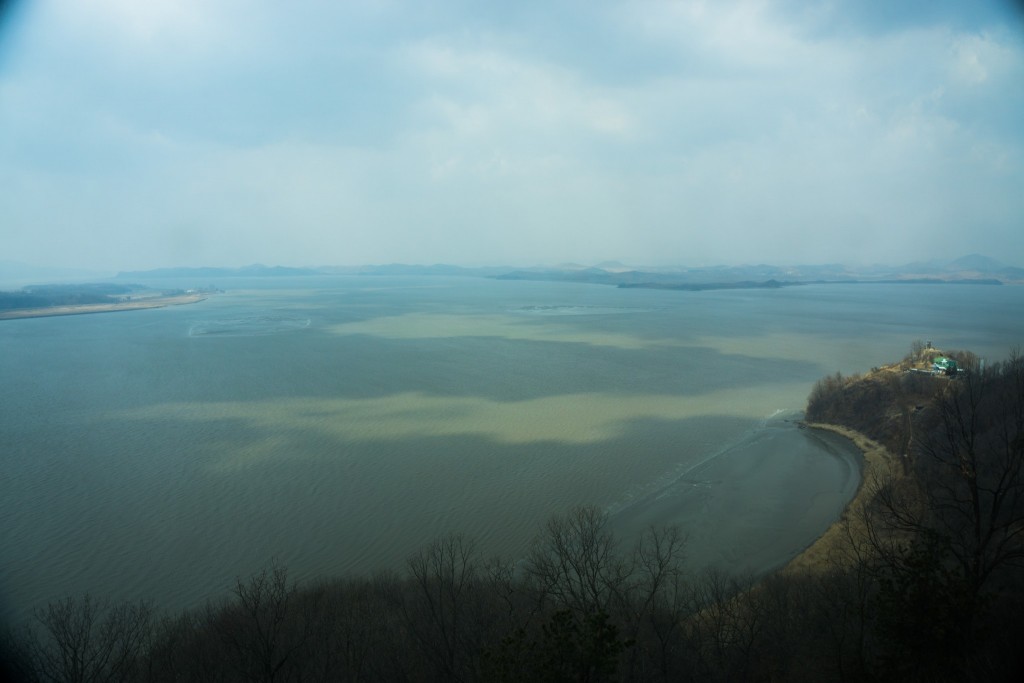
Step 4. Cross the border into North Korea
On a tension-free day at the JSA, one can legally take a step into North Korea. But how and why ?
The blue buildings pictured below are UN Command neutral zones. Midway, the inside of these blue buildings cross the North/South Korea border. Inside the building on the right (UNCMAC) is where meetings between the two countries are housed.
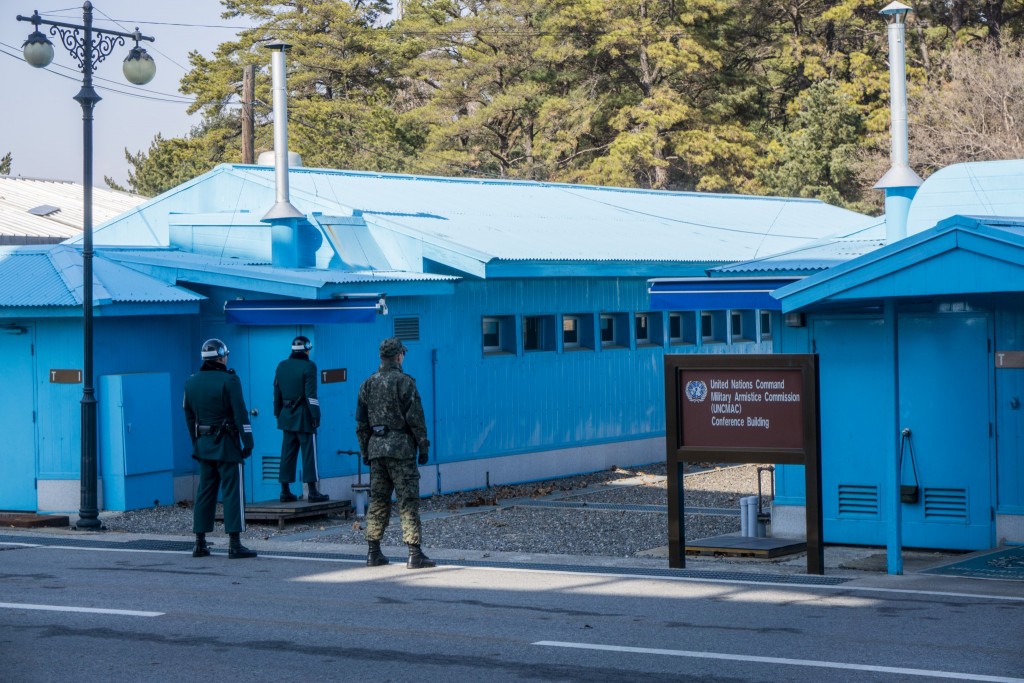
If you want photo evidence that you physically stood in North Korea, this can be done . You can pose with a South Korean soldier within North Korea at the back of the UNCMAC room. Be warned though (and you will be), if you cross through the door behind you, no one is responsible for your safety as you'll be alone and in North Korea.
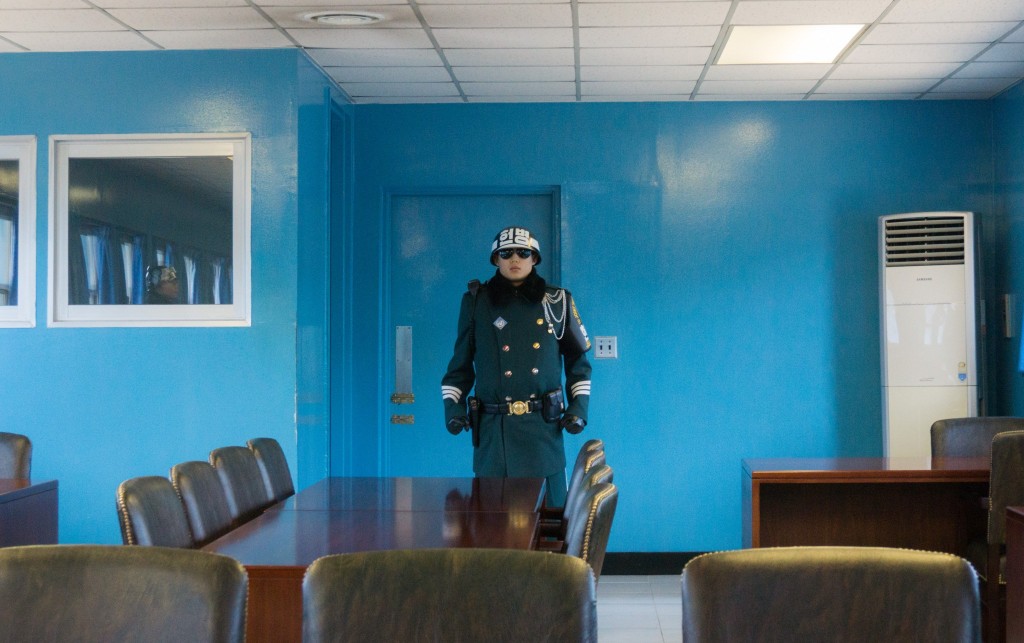
Important Points About DMZ Tours
- Many tours require reservation 2-5 days in advance , so check ahead.
- If visiting the JSA, you must sign a waiver agreeing that no one is responsible for accident, injury, or even death . Take comfort in the fact that these tours are done every day and you are accompanied by military escorts at the border!
- You must bring your passport for most tours , and it is checked by army personnel on arrival at the JSA.
- You must adhere to the specified dress code (e.g. no ripped jeans, sandals, or unkempt hair). These rules are strictly enforced as North Korean soldiers take photos and produce false propaganda that other countries are too poor to afford proper clothing.
- Tours can end unexpectedly at any time if tensions rise at the border . That means you are not be guaranteed to step into the UNCMAC at the JSA, nor is it certain you'll get a photo across the border.
In Summary…
Partaking in the DMZ tour allows yourself to gain much more depth on a humanitarian crisis that the world does not know enough about. If you have the chance to do this trip, I'd highly recommend it.
Tour Companies & Pricing
Alternatively, you can contact one of the tour companies below directly and book with them.
Panmunjeom Travel Center Website : www.panmunjomtour.com Telephone : +82-2-771-5593 (Korean, English, Japanese) Price : 80,000-77,000 won (~$60-$77 USD). All tours include lunch. Note : Tours offered in Korean, English, and Japanese. This is the only company that allows you to meet a North Korean defector/refugee, ask them questions, and better understand the human rights issues of North Korea.
VIP Travel Website: http://www.vviptravel.com/eng/ Telephone: 02-739-3501 ext. 4 Price: 55,000-135,000 won ($48 – $120 USD). Most tours include lunch. Notes: Tours offered in English, Japanese, Chinese. None of the tours include any forced shopping stops.
Koridoor Website : www.koridoor.co.kr Telephone : 02-6383-2570 ext. 2 Price : 43-89,000 won (~$41-$80 USD). Most tours include lunch. Notes : Tours offered in English.
JSA Tour Website : www.jsatour.com Telephone : +82-2-2266-3350 Price : 85,000-120,000 won (~$85-$120 USD). All tours include lunch. Notes : Tours offered in Korean, English, Japanese, and Chinese.
DMZ Spy Tour Website : www.dmzspytour.com Telephone : +82-10-3950-8350 Price: 88,000-114,000 won (~$88-$114 USD). Tours include lunch. Notes : Tours offered in Korean, English, Japanese, and Chinese.
International Culture Service Club Website : www.tourdmz.com Telephone : +82-2-755-0073 Price : 65,000-85,000 won (~$65-$85 USD). All tours include lunch. Notes : Tours offered in Korean, English and Japanese. This is the only company that does Saturday tours.
Seoul City Tour Website : www.seoulcitytour.net Telephone : +82-2-774-3345 Price: 40,000-125,000 won (~$40-$125 USD). Only some tours include lunch. Notes : Tours are offered in Korean, English, Japanese, and Chinese.
KTB Tour Website : www.go2korea.co.kr Telephone : +82-2-778-0150 Price : 65,000-130,000 won (~$65-$130 USD). All tours include lunch. Notes : Tours offered in Korean, English, Japanese, and Chinese.
DMZ & JSA Tour (Professional Guide Service / Celebrity's choice Agency) Website : www.cosmojin.com Telephone : +82-2-318-0345 (Korean, English, Japanese), +82-2-318-0425 (Chinese) Price : 46,000 won (~$46 USD) for half-day tour, 87,000 won (~$87 USD) for full day tour. Lunch included on full day tour. Notes : Tours offered in Korean, English, Japanese, Chinese.
Thrifty Nomads has partnered with CardRatings for our coverage of credit card products. Thrifty Nomads and CardRatings may receive a commission from card issuers. Opinions expressed here are author's alone. Responses are not provided or commissioned by the bank advertiser. Responses have not been reviewed, approved or otherwise endorsed by the bank advertiser. It is not the bank advertiser's responsibility to ensure all posts and/or questions are answered.
You guys are so brave! This makes me a bit nervous and I’m not sure I would be able to do it!
The link to the GetYourGuide tour you provided doesn’t work. Do you have an updated link by any chance? Thank you!
Leave a Reply Cancel reply
Your email address will not be published. Required fields are marked *
Jetpack has locked your site's login page.
Your IP address 199.167.138.122 has been flagged for potential security violations. You can unlock your login by sending yourself a special link via email. Learn More

How to choose the best DMZ Tour (2024 edition)
By: Author Sylvia
Posted on Last updated: January 22, 2024
Are you wondering what’s the best DMZ tour?
When we visited Korea for the first time, we absolutely wanted to visit the DMZ.
We did tremendous research about the best way to visit the DMZ and the best DMZ tour.
What we didn’t know at that time was that the inter-Korean summit would sabotage our plans.
Our DMZ tour was canceled because of the meeting between the North Korean leader Kim Jong-un and South Korea’s President Moon Jae-in.
Covid-19 threw a wrench in the works of our second trip to Korea, but in 2023, the moment finally arrived! We could again travel to Korea, and this time our visit to the DMZ, became a reality. Hooray!
The visit to the DMZ is slightly different after Covid than it used to be. We share all the latest details.
Here’s everything we learned from our extensive research and from our visit in 2023.
There is a really good chance that this post contains affiliate links. If you click one of them, we may receive a small commission (for which we are deeply grateful) at no extra cost to you.
In a hurry? Here you will find the most important information about the DMZ
The DMZ is an interesting place to visit and a perfect way to learn more about Korean history and the current situation of separation between North and South Korea.
- The cheapest way to visit the DMZ is with the DMZ peace train . (The train has stopped running due to COVID-19 and service has not yet resumed at this time. )
DMZ half or full-day trip
- DMZ half or full-day trip ( is slightly cheaper than the one above, but at the moment only runs on Saturday or Sunday )
- DMZ Tour with Optional North Korean Defector
- If you are traveling with a larger family or a group, you could consider a private tour with a guide
- After 2 years of being closed, the JSA is finally reopening. Note that JSA Tours are very popular and are quickly booked up. If you want to visit the JSA you should book your tour as soon as your travel plans are fixed. Read on to learn the difference between the DMZ and the JSA .
Table of Contents
What’s the DMZ
In order to completely understand what the DMZ is all about we will start with some history.
The complete Korean peninsula on which both North and South Korea are currently located was annexed by Japan in 1910. The Japanese treated Korea as a colony. The interests of the Koreans were completely subordinate to the interests of Japan.
Japan was defeated by the Allies at the end of the second world war in 1945. At that time the Soviet Union had occupied the Northern part of Korea and the United States took control of the Southern part of the Peninsula.
7 days in Korea, the perfect itinerary.
The intention of the two superpowers was to create a temporary separation between the 2 parts. Plans existed to create a united and independent Korea in 5 years but things turned out differently.
The Cold War ensured that there was no agreement to hold elections for the whole of Korea.
The differences in politics drove the 2 parts further apart instead of coming to each other.
In 1948 the independent Republic of Korea was established in the American zone. In the same year, the Communist Democratic Korean People’s Republic (North Korea) was founded in the north.
Two years later the Northern army invaded the South with the aim of uniting the two Koreas into one communist state. This was the start of a 3-year-long civil war that claimed more than 2 million victims.
Initially, the Northern army succeeded in overrunning 90% of the South but they were fought back by US-led reinforcements sent by the UN.
In their turn, they crossed the border and made plans to conquer the whole North, against the will of China that launched a counter-attack.

It took until July 27, 1953, before the Armistice Agreement was signed.
The two parties took long to negotiate where the new border should be but in the end, it was decided that the border remained more or less where it had been all the time.
The new border diagonally crosses the 38th latitude and was widened with the creation of a four-kilometer-wide weapons-free buffer zone between the states, known as the DMZ.
The war left its traces and further perpetuated the division of Korea leading to a permanent alliance between South Korea and the United States and the establishment of a US base in South Korea.
There has been a truce since then but o fficially the 2 countries are still at war with each other. We read about how you can literally feel the tension at the border where the armies of both countries are facing each other.
In other parts of South Korea, such as Busan , you do not notice much of the war except that foreign navigation systems, such as Google Maps, do not work because South Korea requires that all mapping data is stored locally. The government also enforces that military bases are removed from maps. Apparently, Google couldn’t promise to obey to all these rules.
In 2018 both countries have done a considerable effort to ease their relations. At the Korean summit in May 2018, they vowed to officially end the war within a year.
Since then several other meetings have taken place between both parties as well as a historic meeting between President Trump and Kim Jong-un in June. That was the first time that the sitting leaders of these countries spoke in person.
We are now well past this deadline and nothing has come of it. Relations between the two countries have even deteriorated again.
It would be great news if Korea would finally be reunited but at this point, it doesn’t seem like this will happen anytime soon.
Over time the DMZ will hopefully transition into a more amicable place but nothing has changed for the time being.
It may be one of the world’s most heavily militarized borders but it’s also one of the most visited tourist attractions in Korea. The DMZ welcomes more than 1.2 million foreign travelers each year, according to the Korea Tourism Organization.
Why visit the DMZ
The guided tours are very educational and some tours have a North Korean defector as a tour guide who can give you more insight into how life is on the other side of the border.
It is at this point one of the few still active remnants of the cold war and that makes it extra special.
Americans and South Koreans are not allowed to travel into North Korea, for them this will be the closest they can get to this isolated country. And despite the fact that other nationalities are allowed to travel to the country, there are not many who do it.
The DMZ is described as one of the most volatile regions in the world and it is a border post that has torn thousands of families apart and still holds them hostage in their “new” country.
It feels strange that at the same time it is one of the top tourist attractions in this country.
We wondered if we would not feel guilty that we as a tourist came to look at a place that is the source of so much misery for other people.
What convinced us is that we believe that, by showing this to people, hopefully, the following generations will learn from the mistakes of the past.
What is the difference between the DMZ and the JSA
With regard to the tours, there is a distinction between the DMZ and the JSA tours in Korea.
JSA refers to the Joint Security Area , this is as close as you can get to North Korea.
The JSA is what most people probably think about when they think about the Korean border. This is the area with the blue barracks that are used for all the negotiations between the North and the South.

This is an iconic picture of the JSA but things may be different today. One of the first things that North and South Korea agreed upon was to clear the JSA of all weapons and military. This disarmament was completed in October 2018.
The good news is that they also decided to preserve the JSA in its current state.
Later on, in this article, we discuss in more depth the different points of interest that DMZ and JSA DMZ tours cover.
Who can visit the DMZ?
Everybody can join the DMZ tours but at this point, certain restrictions are still in place regarding the JSA.
Since the JSA has been disarmed the expectation is that these restrictions will disappear in the near future.
Until that is a fact, these nationalities can visit the JSA but will need to provide a scan of their passport at the time of booking a tour. Albania – Afghanistan – Algeria – Azerbaijan – Bangladesh – Bahrain – Belarus – China – Cuba – Egypt – Estonia – Georgia – Hong Kong – Iran – Iraq – India – Indonesia – Jordan – Kazakhstan – Kuwait – Kyrgyzstan – Latvia – Lebanon – Libya – Lithuania – Malaysia – Morocco – Moldova – Nigeria – North Korea – Oman – Pakistan – Qatar – Russia – Saudi Arabia – Somalia – Sudan – Syria – Taiwan – Tajikistan – Turkmenistan – Tunisia – Ukraine – United Arab Emirates – Uzbekistan – Vietnam – Yemen Visitors with European, American, or Australian nationality do not have any restrictions when visiting the JSA.
Children must be accompanied by their parents for both the JSA as well as the DMZ tours.
Some tour companies require that children are at least 10 years old before they can participate in a JSA tour. If you’re planning on doing a DMZ or DMZ/JSA tour with small children we recommend that you check with the tour company.
Things to know when visiting the DMZ
Opening hours.
The DMZ tours don’t run on Mondays and Korean holidays ( except Korea’s New Year and Thanksgiving Day).
If the Korean holiday happens to be during a weekend, there is a chance that the DMZ tours will run anyway.
We cover an alternative DMZ tour that you can do if your only chance is to visit the DMZ would be a Monday. More about this tour later.
Things you should bring
A current valid passport is required for both the DMZ as well as JSA DMZ tour.
You have to take your passport with you.
Without your passport, you won’t be allowed to join the tour.
A dress code applies when visiting the JSA.
The dress code is expected to disappear now that the disarmament of the JSA is a fact but for the time being, we would advise you to stick to the dress code or to check with your tour operator to confirm what you will be wearing is OK.
This is the dress code:
- Skirts/dresses need to be at least knee length
- No sandals, flip-flops,s or slippers
- No t-shirts: must be collared shirts
- Civilian clothes preferred
- Jeans accepted with no holes (no ripped jeans)
- No tank tops
- No exercise clothes
- No clothing with militarily styled prints
- No stretch pants/tights
The reason that the dress code is in place has nothing to do with security as most would think.
The dress code came after it appeared that North Korea used photos of “sloppy” dressed foreigners to use them in their propaganda. The North Korean government used the photos to showcase the poor state of the other countries.
For this same reason, it is not allowed to wave to the North Korean guards. Images of foreigners waving to North Korean guards have been used in propaganda and have been framed as people who wanted to defect to the communist state.
Codes of conduct
There is still a strict code of conduct in place as we write this article. You mustn’t wave, point, or in any other way signal to the North Korean guards.
Photos are also not allowed everywhere. The guides will tell you what you can and cannot take pictures of. (eg. it is not allowed to take pictures inside the 3rd infiltration tunnel)
When you tour the JSA you must at all times stay with your guide and the military escorts and comply with all the instructions given by your guide and the military.
The disarmament will result in a more relaxed code of conduct in the future.
Most interesting points of interest
The most interesting sights are the Joint Security Area, the Freedom Bridge, the Infiltration Tunnels, and the Mount Odu Observatory.

The Joint Security Area (JSA)
Located in Panmunjom, the JSA is the closest point a tourist can get to North Korea without getting arrested or shot.
Here you’ll have a chance to physically stand in North Korea. It is also the only spot in the DMZ, where the South and North Korean soldiers face each other.
The JSA area is occupied by the South Korean and US military.
Bill Clinton repeatedly called this border post the scariest place on earth but it is touristy at the same time. There is even a gift shop selling original items from North Korea, including stamps, money, and wine.
A visit to the JSA zone usually starts in Camp Bonifas.
This is a United Nations Command military post that houses the United Nations Command Security Battalion of the Joint Security Area whose primary mission is to monitor and enforce the Korean Armistice Agreement of 1953.
Here you will normally also be given a 20-minute briefing by an American soldier explaining the rules and possible dangers.
There are quite a few rules you should follow so listen carefully. You cannot take any loose items with you, if you bring a coat you have to wear it all the time (you cannot hang it over your arm), you will also have to walk to the actual border in “formation” and have to set up in rows, etc.
At this point, you’ll also be signing a waiver that absolves South Korea, the UN, and the USA in case any incidents will arise. The waiver explicitly states that the visitor’s safety is not guaranteed in the event of unanticipated complications.
A standard formality because in recent years there have been no accidents and these tours are done on a regular basis.

This document also provides more information about photo privileges, specifically when and where you’re allowed to take pictures.
Once everybody has signed the waiver a tour bus brings you to the freedom house.
Here two South Korean soldiers of a special unit stand guard facing soldiers from North Korea. Often there is only one soldier on the side of North Korea.
The JSA is the only part of the DMZ where North and South Korean soldiers are face-to-face. They stare at each other all day long and have been for several years.
A little later you can enter the conference room. This is the actual conference room where the armistice agreement was signed. In this room, you will get the chance to cross the border. The border cuts the conference room in 2 so when you cross the room to the opposite side you’re effectively in North Korean territory.
This concludes your visit to the actual JSA zone, next you get a short tour along a lookout point towards North Korea from where you can see the Propaganda Village.
This is a well-tended village just along the North Korean border that is supposedly housing 200 families, several schools, and a hospital.
Tourists seldom see any movement in the village and it is believed that North Korea only built the town for propaganda purposes. Hence the name South Koreans gave to the town.
You will also visit the location of the Korean ax murder incident. Two American soldiers were killed here by North Koreans while cutting a tree.
Another highlight is the bridge of no return.
This is the bridge where prisoners between the two countries were exchanged after the Korean War.
The name originates from the final ultimatum that was given to prisoners of war brought to the bridge for repatriation: they could either remain in the country of their captivity or cross the bridge to return to their homeland.
However, once they chose to cross the bridge, they would never be allowed to return, even if they later changed their minds.
After 2 years of being closed, the JSA is finally reopening.
Note that JSA Tours are very popular and book out quickly. We therefore recommend that you book as early as possible so that you can choose your desired date.
Check prices and availability: DMZ-JSA Tour

Imjingak Park and the Freedom Bridge
Imjingak Park has an important sentimental and symbolic meaning. This park commemorates families who are separated because of the split between North and South.
The remnants of the Freedom Bridge can be seen from the park. This bridge was long 1 of only 2 bridges that crossed the Imjin River.
It had long served peaceful purposes but its position close to the Korean border made it of crucial importance during the Korean War.
The bridge was destroyed early in the war, making the Imjingang bridge alongside it the only connection to supply the Southern troops fighting in the Northern territory with supplies.
After the peace treaty was signed this bridge was also used to exchange the sick and wounded prisoners.

The Third Tunnel of Aggression
The Third Tunnel of Aggression is one of four known tunnels under the border between North and South Korea.
The tunnels have been dug to make a surprise attack from North Korea on South Korea.
North Korea denies this and claims the tunnels are part of a network of tunnels belonging to a coal mine. This is highly unlikely as coal has never been found in the area.
The Third Tunnel of Aggression is located 44 kilometers from Seoul and was discovered in 1978. It runs underneath the Demilitarized Zone.
The incomplete tunnel is 1,635 meters long, with a height and width of 2 meters. It is estimated that the tunnel would be able to accommodate more than 30,000 soldiers with light weapons per hour.
Today the tunnel has become an all-inclusive tourist attraction, with a DMZ video hall, representative sculptures, gift shops, and more.

The tunnel is located 73 meters below the surface and is accessed through a steep tunnel. It makes for quite a tough climb. For a supplement, you can use the monorail pictured above to enter and exit the tunnel. Check in advance with the tour organizer if he can arrange this if you want to use the monorail.
You can walk a part of the tunnel until the MDL (military demarcation line). The tunnel may feel quite cramped and if you’re claustrophobic you want to skip it.
Pictures are not allowed in the tunnel.

The Dora Observatory
The Dora Observatory is the northernmost Observatory. It is situated on top of Mount Dora.
Here you can catch a rare glimpse of the reclusive North Korean state without setting foot in the country.
You will see the Kijong-dong Propaganda village and, on a clear day, you can see as far as the real city of Kaesong situated about 8km from the DMZ.

Kaesong is the only city that actually changed hands after the Armistice agreement was signed. It used to be under the control of South Korea but is now ruled by the North.
The Kaesong Industrial region that borders the city is because of its proximity to the border a special administrative region where both people from the North and the South are allowed to work.
You can also see the Dorasan train station , a station located only 650 meters from the Korean border.
The railway line used to continue into North Korea all the way to the capital city of Pyongyang.
The tracks are still there and one hopes that in the near future the trains will again operate in between the two current capitals.

The Dorasan Train station
In 2000 North and South Korea made plans for a rail line that connected both capitals.
The line was completed in 2003 but it took until 2007 before the first freight trains started to run across the border. Not for long unfortunately because already in December 2008 North Korea decided unilaterally to again hermetically close the border.
The Dorasan Train station is currently hugely oversized. The DMZ train is the only train that serves the station with exactly one arrival and one departure daily.
But, with a large customs & immigration area, the station is completely ready for the day that the trains will again continue further North. The original intention was to enable passenger transport in the long term. Let’s hope that this will become a reality in the future.
At this point, Dorasan station is more a symbol of the hope for a reunion between South and North Korea than it is an actual functioning train station.
How to visit the DMZ
The DMZ area is located 60 km from Seoul and can be visited with the DMZ train or a private guided or group tour.
The DMZ peace train
DMZ peace train service has not yet resumed post-COVID-19.
The cheapest way to visit the DMZ is with the DMZ peace train .
The DMZ peace train runs from Seoul to Dorasan station from Tuesdays to Sundays. Just before the train reaches Dorasan station it crosses the Imjingang bridge which gives you a good view of the remnants of the Freedom bridge.
Once arriving at Dorasan station, you can hop on a bus to visit the DMZ. The bus will take you to the Dorasan peace park, the Dora observatory and you will visit the Third Tunnel of Aggression.
Pros and cons
- The cheapest way to visit the DMZ. You will have to take cash to pay separately for the bus tour (if you don’t join the bus tour the only other option is to hang around for 5 hours at the train station) as well as for your lunch.
- This tour might be for you if you don’t like group tours. It gives you slightly more freedom although you still will have to join the bus once you arrive at Dorasan station.
- No English is spoken on the bus tour.
- This tour takes a whole day. If you are short on time you better opt for an organized half-day DMZ tour allowing you to explore the rest of Seoul during the remaining afternoon
- You cannot visit the JSA.
- No hotel pick up, you will need to get to the train station on your own expense
Although we’re not fans of organized group tours ourselves we have opted for an organized tour to visit the DMZ and we were happy with our choice afterward.
The first reason is that you have to join a tour anyway if you want to see the sights such as the infiltration tunnel that are located inside the DMZ. Otherwise, you can only visit Imjingak park.
The second reason is that many of the sights, including in Imjingak park, don’t say that much unless you hear the story from the guide.
We haven’t been able to visit the JSA yet, that will be for our next trip. If you want to visit it you also need to book a tour with a guide.
Finally, there isn’t a huge price difference between what you would pay if you went to the DMZ on your own and took a tour there or booked an organized tour from the start.
That’s why our advice would be to have a look at the organized tours before you opt for the train.
“The scariest place on Earth” – Former US President, Bill Clinton, during his visit to the DMZ in 1993.
The best DMZ tours from Seoul
The most comfortable way to visit the DMZ is with an organized DMZ tour from Seoul.
We recommend using GetYourGuide to book your DMZ tour in Korea. One of the advantages of GetYourGuide is that most tours have a flexible cancellation policy. Normally you can cancel up to 24hours before the tour to get a full refund.
Here is an overview of all the tours on GetYourGuide.
You have a choice between half-day and full-day DMZ tours.
All DMZ tours will head to Imjingak Peace Park first where they will buy tickets to enter the DMZ area. Depending on how busy it is, your group will have to wait there until it’s your turn to visit the DMZ region.
Your guide will tell you some stories about the most important things at Imjingak when you arrive.

You can use your free time at Imjingak to see several monuments and other elements that tell stories about the Korean War. One of them is this steam locomotive riddled with bullets. This was the last train to cross the border. It was destroyed by US soldiers so that it could not be used by North Korean troops.
Once it is your turn to visit the sights inside the DMZ area, the Dora Observatory, and the Infiltration tunnel, you will board a bus and visit those things in groups.
Know that the end times of all tours are only indicative. Only a limited number of people are allowed in the DMZ area at a time. Therefore, there is a real chance that your group will have to wait and that your tour will be delayed. We recommend not booking any other activities on the day of your DMZ visit.
Make sure to book your DMZ tour from Seoul well in advance to avoid disappointments, especially JSA tours tend to sell out well in advance.
Which Dmz Korea tour is the best one? Here’s a list of the most recommended and popular tours.
To create this list we looked at the itineraries and the reviews.
This tour visits the DMZ and JSA in 1 day. It is the most complete and popular DMZ tour.
Tours to the JSA zone have only just resumed and availability is currently difficult to find.
Check prices and availability: JSA tour on Viator

- Visit the freedom bridge near Imjingpark and the old steam train
- Learn more about the Korean war by visiting the 3rd infiltration tunnel and the DMZ Exhibition Hall
- See North Korea from the Dora observatory
- Visit the Dora station
They offer both half-day and full-day tours. You can join the half-day tour in the morning or in the afternoon. The morning tour starts at 8 am, the afternoon tour at 11 am.
If you opt for a full-day tour, you will also visit the War Memorial of Korea.
Pickup is included ( see the tour for the exact pickup locations)
- Those who are not interested in the JSA or who are short on time will find that the half-day DMZ tours offer a great alternative. You will see all the highlights of the DMZ and still have a half-day to discover Seoul.
- If you want to visit the War Memorial of Korea, you should opt for the full day tour.
Check prices and availability: DMZ half or full day trip

DMZ half and full-day tour
- Explore the extraordinary Demilitarized Zone that separates North and South Korea
- Get a rare glimpse of North Korea from the Ganghwa Peace Observatory
- Stop by at the Veterans Memorial Park and learn more about the Korean War
- Watch the statues and monuments at Imjingak Park
- See the Bridge of Freedom
There are both half and full-day tours.
Both tours will take you to all the highlights of the DMZ.
In addition, the full-day tour includes an authentic Korean-style lunch (Bibimbap) and a real shooting experience back in Seoul.
Due to COVID-19 measures, the places visited will be Imjingak Park, Bridge of Freedom, 3rd Infiltration Tunnel, Dora Observatory, and Dorasan Station.
Note that at the moment this tour only runs on Saturday and Sunday.
- If you aren’t interested in the JSA or short on time will find that the half-day DMZ tours offer a great alternative.
- The Ganghwa Peace Observatory is a great alternative for those that are looking to visit a less touristic area of the DMZ.
- If you add up all the costs of the train excursion, the difference between these half-day excursions is negligible.
Check prices and availability: DMZ half and full day

DMZ Tour with a North Korean Defector
- Listen to enlightening commentary from a professional guide and a real North Korean defector
- Ask questions about real North Korean life and hear about the past and present of North Korea
- Enjoy a comprehensive tour of the Korean Demilitarized Zone ( tour of DMZ) and learn about both South and North Korea’s history
- Explore all the must-see spots in the DMZ in one tour
- Catch a rare glimpse of the reclusive North Korean territory
Tours
With this DMZ tour, you visit the must-see spots in the DMZ zone and you have the possibility to ask questions to a North Korean defector about life in North Korea.
You can opt for a tour with or without hotel pick-up.
This tour is similar to the half-day DMZ tour we listed above but you will be accompanied by a guide and a North Korean defector.
This is our top recommended tour if you want to learn more about North Korea.
There’s no better way to learn more about North Korea than to speak to somebody who lived there for several years.
Check prices and availability: Tour with Optional North Korean Defector

Private DMZ Peace Tour: 3rd Invasion Tunnel(Monorail) and Suspension Bridge
If you are traveling with a larger family or a group, consider a private tour with a guide.
This tour visits all the important stops such as the freedom bridge and the Mangbaedan altar, the third tunnel, Dora Observatory, and more.
You will also have the option to visit Gamaksan Chulleong Bridge or Majang Lake.
The Gamaksan Chulleong Bridge is with length of 150 meters one of the longest suspension bridges in Korea. This bridge was a fierce battlefield during the Korean War.
Majang Lake is the lake where the Allied Forces fought a fierce battle during the Korean War.
Check prices and availability: Private DMZ Tour
A journey to South Korea is not complete without a visit to the DMZ. It may feel strange to travel to a very controversial border post as a tourist but it is the best way to learn about the rich albeit sad history of the 2 Korean countries.
If you like this article, pin it

September 7 - October 1 2024
The north korea mega tour | kaesong to mount paektu & beyond, 24 or 25 nights in north korea + beijing-pyongyang travel time.
An epic life-changing journey and the longest North Korea tour of the year! Travel from Pyongyang to Kaesong, Mount Paektu and far beyond! From 3995 EUR per person
Please apply by 15th August, 2024 .
The North Korea Mega Tour | Kaesong to Mount Paektu & Beyond
Koryo Tours' annual Mega Tour every September is the ultimate journey to North Korea, and our longest and most comprehensive tour to North Korea.
We'll travel from Pyongyang , and to the most visited sites of the country to stunning Mt Paektu , Mt Chilbo , and Mt Kumgang as well as the rarely-visited industrial cities of Chongjin , Hamhung , and Wonsan , plus much more!
The trip covers thousands of kilometres from the capital Pyongyang to the country's far north, south, east, and west by bus and internal flights. On the way, we’ll stop by all the must-see tourist attractions - from massive political structures and monuments to pristine mountains, forests, and beaches to the socialist industry and agriculture that are the backbone of the DPRK economy.
We'll also be in Pyongyang for National Day, a major North Korean holiday, and see how North Koreans celebrate the 76th anniversary of the foundation of the DPRK (North Korea). Get to know one of the least-understood countries in the world and its people as it stands at a crossroads in its relations with its long-time adversaries: South Korea and the United States.
The best way to get to know and understand North Korea is to spend time in the country and meet and interact with local North Koreans through activities, sports, games, and serendipitous encounters.
A new addition to this tour is the possibility of extending your stay in the DPRK for two more nights to visit the Rason Special Economic Zone to see North Korea to its fullest like nobody before. This trip offers a unique chance for an overview of much of the country.
Take it from us; we've been travelling to North Korea for more than 30 years! Join us for this unforgettable trip of a lifetime.
Looking for something shorter? You can also book just the first 9-nights or second 14-nights of this tour. See our National Day Long Tour and Unseen North Korea tours, respectively.
Scroll down for an overview of our Mega Tour North Korea National Day Tour package highlights, tour itinerary, transport options , DPRK tourist visa information, and extra add-ons.
Koryo Tours International Tours
Mongolia | Turkmenistan | Kazakhstan | Bhutan | Russia | Tajikistan
Front Image credit: Christian Petersen-Clausen
- Pyongyang for DPRK National Day on September 9
- Full tour of the Pyongyang Metro to rarely-visited stations
- Four of the Eight Views of Korea (Mt. Kumgang, Pujon Highlands, Pyongyang, and Mt. Paektu) and Four of the Five Mountains of Korea (Mt. Paektu, Mt. Kumgang, Mt. Myohyang, and Mt. Kuwol)
Briefing Day
September 6 | friday.
*Pre-Tour Briefing | We require all travellers to attend a pre-tour briefing that covers regulations, etiquette, safety, and practicalities for travel in North Korea. The briefing lasts approximately one hour followed by a question and answer session. Please be punctual for the briefing. You can come early, meet your fellow travellers, and pay any outstanding tour fees. A proper briefing is an essential part of travel to North Korea. For this tour, we will hold two briefings. One in the morning for those departing by train this afternoon and the other in the afternoon for those departing by flight the next day.
- Recommended latest arrival in Beijing.
- 10:00 | Briefing for those departing by train.
- 16:00 | Briefing for those departing by flight.
- 17:26 | Train travellers depart Beijing Station by Chinese domestic sleeper train to Dandong , the Chinese city on the border with North Korea. Please arrange independent travel to the train station and arrive at least an hour and a half early for the train departure.
Overnight | Hotel in Beijing not included in the tour for those taking the flight the next day. Contact us for recommendations near our office! Those travelling by train will spend the night on the train.
September 7 | Saturday
- Train transfer at Dandong Station from overnight sleeper train to Dandong-Pyongyang local. Our local representative in Dandong will assist with the transfer. Train crosses the China-North Korea border followed by North Korean customs and immigration.
- Flight departure from Beijing Capital International Airport (PEK) Terminal 2 on Air Koryo flight JS152 at 13:05. A 1.5-hour flight with basic lunch ( vegetarian option is subject to availability). Check-in starts 3 hours prior to departure.
- Flight arrival to Pyongyang's Sunan International Airport (FNJ) at 16:05. DPRK immigration and customs, meet your Korean guides and transfer to the city.
- Train arrival to Pyongyang Railway Station at 18:45.
- Walk on Future Scientists' Street | An evening stroll through one of Pyongyang's newest neighbourhoods.
Overnight: Yanggakdo International Hotel, Pyongyang | Home away from home for most (but not all!) foreign visitors to Pyongyang, this 47-story hotel is located on an island in the middle of the Taedong River and offers great views of the city. Comfortable rooms and comprehensive leisure facilities: swimming pool, spa, billiards, bowling, gift shops, tea houses, beer brewed on-site, and a Chinese-run casino.
September 8 | Sunday
Pyongyang City Tour AM
- Kumsusan Palace of the Sun | Mausoleum of the DPRK leadership where President Kim Il Sung and Leader Kim Jong Il lie in state and the most solemn location on the itinerary. Please note formal dress is required. Men require collared shirt with tie, dark non-jean pants, and dark shoes. Women require covered shoulders, knee-length dress or pants, and closed toed shoes. The visit will take most of the morning and visitors are asked to bow a number of times inside. This is a state-administered site and visits are subject to local conditions. Cancellations are rare but possible.
- Revolutionary Martyrs’ Cemetery | Hilltop cemetery with dozens of bronze busts of those who took part in the liberation of Korea from Japanese colonial rule. It is customary to present flowers here.
- Foreign Languages Bookshop | Store selling Korean publications translated into English, German, French, Russian, Chinese, and Spanish. Also pick up DVDs, postcards, and small works of art.
- Kim Il Sung Square | Pyongyang’s central square lined with government ministries, museum and The Grand People’s Study House, Korea’s national library. See the centre of it all!
- Okryugwan | A meal at Pyongyang’s most famous restaurant. Housed in a huge traditional building on the banks of the Taedong River. Okryugwan specialises in Pyongyang Cold Noodles.
- Grand People's Study House | National library and public correspondence university with Neo-traditional Korean and great views of the city.
- Tower of the Juche Idea | Iconic tower dedicated to the DPRK’s guiding philosophy on the Taedong River. Take the elevator to the top for 5 EUR for great views of the city.
- Monument to the Party Foundation | Iconic structure featuring the hammer, sickle, writing brush which make up the emblem of the Worker’s Party of Korea and represent workers, farmers, and intellectuals.
- Golden Lane Bowling Centre | Where Pyongyang locals go for their ten-pin fix ( 2.5 EUR per person per game ). Also has billiards and arcade games. Non-bowlers can head next door to the Kumrung Leisure Centre for an airgun shooting range ( approximately 6 EUR per 20 round cartridge ) and some of the best coffee in Pyongyang.
- Taedonggang Seafood Restaurant | Dinner tonight will be at the Taedonggang Seafood Restaurant (10 EUR per person).
Overnight: Yanggakdo International Hotel, Pyongyang
September 9 | Monday
National Day, the 76th anniversary of the foundation of the DPRK (North Korea) AM
- Mansudae Fountain Park | The historic centre of Pyongyang popular with local citizens after school and on weekends. Flanked by examples of ancient, socialist, and modern architecture.
- Mansudae Grand Monument | Enormous bronze statues of President Kim Il Sung and Leader Kim Jong Il overlooking downtown Pyongyang. A presentation of flowers and bow by the group is customary here (5 EUR). Here we will also see the Chollima, or ‘thousand ri [400 mile] horse’ – a symbol of speed- commemorating the quick rebuilding of the country in the 1950’s following the Korean War.
- FULL Pyongyang Metro Tour | One of the deepest metro systems in the world with stunning artwork reflecting the name of each station. Ride both lines and stop off at smaller stations, rarely visited by tourists.
- Arch of Triumph | Massive archway made for the 70th anniversary of President Kim Il Sung in 1982 and commemorating the liberation of Korea from Japanese colonial rule. Larger than its counterpart in Paris.
- Moranbong Park | We’ll take a stroll and have picnic lunch in Pyongyang’s central park popular with locals for picnics, dances, and sports. The park is filled with historic pavilions, walls, and monuments- modern and ancient, a few of which are among the traditional ‘Eight Great Sights of Pyongyang’.
- Tram Ride | A ride through Pyongyang on one of the city’s trams from Kwangbok Street. A Koryo exclusive!
- Mass Dance | We'll watch as hundreds of locals, many in brightly coloured national dress, join together in a beautiful choreographed dance in the heart of the city (and maybe even join in ourselves!)
Pyongyang Circus (or other available performance) | We will leave time this afternoon to try and catch a local performance — either of the Pyongyang Circus, theatre, or a revolutionary opera. Schedules are typically announced only a few weeks before the trip. If no performances are available, we will find an alternative activity in the city. Tickets to be paid on the spot (from 5-25 EUR) depending on the available performance.
Dinner and sunset boat cruise along the Taedong River | We will take a cruise on the Taedong River while having dinner with live music performance and waiting for the fireworks.
Overnight: Yanggakdo International Hotel, Pyongyang
September 10 | Tuesday
- Victorious Fatherland Liberation War Museum and USS Pueblo | We’ll tour this world-class museum led by a local museum guides. Renovated in 2012 and its exhibits of Korean War from the DPRK perspective containing artifacts, documents, photos, and lifelike dioramas. The exterior grounds house the War Victory Monument and displays of Korean People’s Army Hero Equipment and captures equipment from the US military, including the spyship USS Pueblo . Central to the understanding of the country today and highlight of the trip.
- Mangyongdae Native House | Birthplace of and childhood home of President Kim Il Sung. A traditional Korean house in beautiful natural surroundings.
- Kwangbok Department Store | Exchange for Korean currency and shop with the citizens of Pyongyang! Try the snack stand on the first floor for some of Pyongyang’s best local eats.
- Mt Ryonggak | Enjoy a picnic lunch in this park on the outskirts of Pyongyang and popular with locals. Stretch your legs after lunch witha short hike to the top of Mt Ryonggak itself.
- Drive west along the ‘Youth Hero Highway’ to Nampo (45 minutes to 1-hour drive), the port city of Pyongyang at the mouth of the Taedong River on the West Sea.
- Chongsam-ri Co-operative Farm | The DPRK’s most famous and iconic model farm. Visited hundreds of times by Kim Il Sung, the place where the ‘Chongsam-ri Method’ was developed (they will explain on-site). See how the farming system works, visit a farmhouse, the local shop, kindergarten and see the fields and greenhouses.
- Tae’an Glass Factory | Factory producing glass and glass products for the domestic market. Watch the glass-making process from smelting to sheet-cutting and even try to break a sheet of strengthened glass.
- Pi Island | A local beach next to West Sea Barrage. Go for a swim or join the locals for a karaoke.
- Nampo Clam BBQ | Nampo's famous clam BBQ - cooked in petrol and washed down with Korea's national drink, Soju.
Overnight: Ryonggang Hot Spa Hotel , Nampo | Compound with holiday houses and a main building for dinner and entertainment. Bring a torch! Spa bath in every room with mineral water from the Sindok Spring- the most famous mineral spa in the DPRK. Billiards, karaoke, and ping pong.
September 11 | Wednesday
- West Sea Barrage | An 8 km concrete, steel, and earthen barrage constructed between the Taedong River estuary and the West Sea for land reclamation, irrigation, flood prevention, and power generation. It also acts as a ship lock and fish ladder. One of the DPRK’s greatest engineering feats.
- Mt. Kuwol | A scenic mountain area on the West Coast of Korea. We’ll pass through this region on a full-day drive between Nampo and Kaesong after crossing over the West Seat Barrage in the morning.
- Woljong Temple | Buddhist temple established in the middle of the 9th century and later rebuilt at the start of the Ri Dynasty.
- Sinchon Town and Museum of US War Crimes ( *Currently closed for foreign visitors ) | Museum dedicated to ‘crimes committed by the US imperialists’. Located on the site of a civilian massacre, the museum has an array of harrowing exhibits, displays, and panoramas on the haunting events that took place in this region during the war. Not for the faint at heart and sensitivity is called for here. Please note that this location was closed to foreign visitors in 2018 following the DPRK-US Summit Meeting. If the situation changes, we will visit this site.
- Sariwon Folk Village and City View | Mock-up of a traditional Korean town which includes a history museum, food street, and pavilions. There is a small tavern selling Makkoli , traditional rice wine. Climb a nearby hill for a view of Sariwon City and the surrounding plains.
- Unjong Livestock Farm and Mask Dance | See the facilites of this livestock farm and then be treated to a traditional Korean mask dance.
- Continue south to Kaesong , historic capital of the medieval Koryo Dynasty (918-1392 AD). Once located in South Korea, the city changed hands during the Korean War. It is now located just north of the DMZ.
- Traditional Korean Royal Meal with Kayagum Performance | Also known as pansanggi, the meal is made up of different dishes served in small brass bowls. The more dishes, the more distinguished the guest!
Overnight: Minsok Folk Hotel , Kaesong | Traditional style hotel where guests sleep on heated floors in Korean style. Housed in beautiful courtyards of Kaesong’s old city, structures date back to the Ri Dynasty. Basic bathroom facilities. Hot water not guaranteed and erratic electricity supply – please bring a torch.
September 12 | Thursday
Historic Kaesong and Panmunjom (*Please note that due to the current political situation and recent chenges, it is our understanding that visits to Panmunjom and the JSA as well as to the Concrete Wall is not possible at least until further notice. If that is the case at the time of our vist we will visit UNESCO World Heritage Sites in Kaesong as well a ginseng factory .)
- Old City Walk and South Gate | A stroll from the hotel through Kaesong’s historic district lined with homes dating back to the Ri Dynasty from the city’s historic South Gate.
- Panmunjom Truce Village ( *Currently suspended ) | Located in the middle of the 4 km wide Demilitarised Zone, Panmunjom is the site of the signing of the 1953 armistice at the end of the Korean War. This is the only location where visitors can directly view soldiers from both sides and the demarcation line dividing Korea. On some days it is possible to enter the hut straddling both Koreas and there cross temporarily into the south.
- Sonjuk Bridge | Small stone bridge built in 1290, which in 1392 was the site of the assassination of the last loyal Koryo Dynasty minister Jong Mong Ju by a son of Ri Song Gye (founder of the next, and final, dynasty). This bloody act extinguished the Koryo which had ruled over Korea for 474 years and is said to have left a permanent mark on the bridge that can be seen to this day.
- Kaesong Koryo Museum & Stamp Shop | A former Confucian education school, now a museum on the Koryo Dynasty exhibiting historical objects, statues, pagodas, and porcelain from the time. One of Kaesong’s many UNESCO World Heritage Site.
- Pakyon Waterfall | Light walking with a picnic lunch in a relaxing wooded area. Local people commonly visit here for picnics and sometimes swimming in the series of pools above the falls.
- Gwanum Temple | Located a 30-minute hike, above Pakyon Waterfalls, the temple dates back more than a thousand years and is dedicated to the Buddhist Bodhisattva of Mercy. There is an ornate marble Bodhisattva statue the nearby cave. The current building dates back to the Ri Dynasty and has an interesting tale associated with its construction.
- Tomb of King Wanggon | Resting place of the founder of the Koryo Dynasty, who died in 943. The tomb is largely reconstructed after looting by the Japanese occupiers and general disrepair. A UNESCO World Heritage Site.
- Concrete Wall and view of DMZ ( *Currently suspended ) | View of a complex fortification system erected on the southern boundary of the DMZ accompanied by a military guide. The wall is seen as evidence of intent to permanently divide the nation. A 45 minute drive each way from Kaesong through scenic countryside.
- Janam Hill | Statues of the DPRK leadership on a hill overlooking Kaesong city and historic pavilion used for archery demonstrations in days of yore.
Overnight: Minsok Folk Hotel, Kaesong
September 13 | Friday
Haeju, and onto Pyongsong
- Drive to the rarely visited town of Haeju (approx. 2 hrs drive, very dependent on road conditions but a guaranteed adventure) , the provincial seat of South Hwanghae Province and a port city on the West Sea.
- Picnic lunch at Sokdam Ravine | Made up of 9 valleys spread over a large area the Sokdam scenic area is a worthy place to visit for the views alone. Sokdam ravine means the scenic spot which was seated on the 9 ravines with mountains, rocks and streams.
- Haeju Central Square and Statues
- Puyong Pavilion | The largest pavilion in the whole DPRK and the only one in Korea built on footstalls in water, originally built in 1500.
- Koryo Fortress | A major military base in its day, this fortress is situated above the magnificent Suyang Waterfall.
- Drive to Pyongsong , the capital of South Pyongan Province. A 4-hour drive.
September 14 | Saturday
Pyongsong and Mt Myohyang
- Kim Jong Suk Higher Middle School | One of the DPRK’s top middle schools for gifted students, tourists are encouraged to help teach an English class!
- Paeksong Revolutionary Site | Location of Kim Il Sung University during the Korean War. Tour the renovated buildings and learn about life there during the war.
- Drive to Mt Myohyang via Anju a mid-sized industrial city located on the road and rail line north of Pyongyang on the Chongchon River. During the Korean War, major battles were fought near here between North Korean-Chinese forces and UN-South Korean forces. Coal is mined nearby. Rarely visited by foreigners.
- Pae ksang Pavilion and Anju City Walls | The greatest pavilion in Kwanso (Pyong’an Province) which overlooks the Chongchon River. Rebuilt after destruction in the Korean War.
- Manpok Valley Hike | Various options for hikes of a range of distances/difficulties. Passing waterfalls, hermitages, interesting rocks, lovely wooded areas, and viewing points.
Overnight: Huichon Hotel , Chagang Province | Basic but clean hotel located 30 minutes north of Mt. Myohyang. Very good local food much different from the lowlands, on-site sauna, and limited electricity.
September 15 | Sunday
Mt Myohyang and Return to Pyongyang AM
- International Friendship Exhibition | A semi-subterranean exhibition hall displaying gifts of all kinds given to the DPRK leaders by foreign states, leaders, and organizations. The exhibition is a fascinating look into material culture in the second half of the 20th century. Highlights include a plane given by the Soviet Union, basketball signed by Michael Jordan from the US State Department, and vodka given by Dennis Rodman. The visit takes most of the morning. Presentable dress required .
- Pohyon Buddhist Temple | A peaceful temple dating back to 1042 CE with stone pagoda and repository of print blocks and historic text of the Tripitaka Koreana , Buddhist scriptures first produced to invoke divine assistance from foreign invasions during the Koryo Dynasty.
- Lunch at local hotel.
- Drive back to Pyongyang ( 2.5-3 hours ) with a stop at Ryongmun Caves | A subterranean complex of limestone caves and grottoes. Led by an experienced local guide, you will see weirdly (and suggestively) shaped rocks and stalactites/stalagmites and hear a wealth of stories and legends about each - some not appropriate for young audiences.
- Mansugyo Beer Bar | A traditional standing bar serving seven type of beer (1 EUR a pint) . Popular with locals after work and on weekends!
September 16 | Monday
Slow day in Pyongyang. This morning we'll allow everyone to sleep in for some much-needed rest. For those who want to can go and learn a bit about Korean history.
- Chongnyon (Youth) Hotel, Pyongyang | Spend the morning relaxing by the outdoor pool of this hotel.
- Hamburger Restaurant | Lunch will be at one of Pyongyang's hamburger restaurants to give you some variety.
- National Gift Exhibition Hall | One of North Korea’s two gift exhibition halls, this one houses all of the gifts given to North Korea’s leaders from Koreans in North Korea, South Korea and from all over the Korean Diaspora, including items gifted by many well known Koreans.
- Korean Central History Museum | Located on Kim Il Sung Square, this is North Korea's national museum dedicated to the history of the Korean peninsula.
- Helmut Sacher Coffee Shop | Relaxing afternoon stop at this coffee shop tucked away near Kim Il Sung Square. Good coffee here, cost around 3-5 EUR per cup.
September 17 | Tuesday
Drive to Hamhung, the DPRK's second largest city and centre of heavy industry, stopping at sights along the way.
- Hamhung | Drive east across the width of the peninsula before heading north to Hamhung (6-7 hour drive), the second-largest city of the DPRK and major centre of industry.
- Tomb of King Tongmyong | Largest of the UNESCO listed Koguryo Tombs spread through the area, this is the beautiful tomb complex of the founder of the Koguryo Dynasty two thousand years ago. Statues, a Buddhist Monastery, and lovely wall paintings make this a fascinating visit for history buffs.
- Sinpyong Lake Rest Stop | Known as ‘Little Kumgang’ this scenic lakeside rest stop, a great opportunity to stretch your legs.
- Ulim Waterfall | Hidden amongst the mountains on the road to Wonsan, ‘Echo’ Waterfall is a scenic stopover to enjoy lunch, stretch your legs, or go for a dip in the pool beneath.
- Hamhung Grand Theatre and Central Square | Exterior view of the DPRK’s largest theatre on the city’s central square.
- Home of Ri Song Gye | Home of the first king of the Ri Dynasty (1392-1910) who extinguished the Koryo Dynasty, only to be then ousted by his own son. A traditional hall and pavilion and associated naughty stories of the former king’s retirement years – some not appropriate for the youth!
Overnight: Majon Beach Guesthouse , Hamhung | A beachside holiday compound with basic but comfortable chalets. Rooms have heated floors but no running water. Bring a torch! There is a main building with restaurant, bar, billiards, table-tennis, bookshop, and Korean karaoke.
September 18 | Wednesday
From Hamhung to the truly rarely visited Pujon Highlands (and back!)
- Hungnam Fertiliser Factory | Massive chemical-industrial plant producing various kinds of fertilisers. Tour of the plant control room, production facilities, and packing plant - just don’t light up next to the Ammonium Nitrate!
- Pujon Highlands | A scenic drive through the highlands above Hamhung, traditionally considered as one of the ‘Eight Great Sights of Korea’. Home to the Pujon Stone River , a multi-kilometre river of boulders running down the side a mountain and the Okryonsan Revolutionary Site – a base for anti-Japanese guerillas during the colonial period. This region was the sight of some of the most brutal fighting of the Korean War in the middle of the unusually cold winter of 1950. Notice how the local architecture differs from the lowlands beneath.
Overnight: Majon Beach Guesthouse, Hamhung
September 19 | Thursday
Drive to Wonsan, a major port city on North Korea's east coast.
- Tonghung Revolutionary Site | Hillside park with statues of the DPRK leadership overlooking Hamhung city centre and the Songchon River. A presentation of flowers is customary.
- Drive south to Wonsan , a major port city on the East Sea, stopping at scenic spots along the way. A 2.5-3 hour drive.
- Wonsan Agricultural University | The DPRK’s premier agricultural university set among beautiful hillside scenery. Tour the grounds and the neo-Romanesque teaching hall, originally built by Germans living in the area in the early 20th century.
- Songdowon International Schoolchildren’s Camp | A classic socialist summer camp where Korean and international children can spend two weeks learning socialist values and teamwork. Tour the recently renovated dormitories, aquarium, birdhouse, gymnasium, and more!
- Wonsan City Centre and Docks | Central square and ship terminal in downtown Wonsan.
- Kangwon Province Art Gallery | Small art exhibition selling artwork by local artists.
- Jangdok Island and Lighthouse | Take a stroll on the breakwater to a small island in the middle of Wonsan harbour ( 1 EUR/USD entry fee ).
Overnight: Tongmyong Hotel , Wonsan | Waterfront hotel with stunning seaside views of Wonsan Harbor. Limited hours of hot water, bar, billiards, ping-pong, barber shop, beauty salon, dry-sauna, and indoor seawater swimming pool.
September 20 | Friday
Mt. Kumgang
- Mt. Kumgang | Drive along the East Sea to see the ‘Diamond Mountain’ noted in East Asian history and famous in Korean legend. Home of some of Korea’s most spectacular natural landscapes and best hiking. A 2.5-hour drive.
- Samil Lagoon | A charming green-water coastal lagoon lined by pine forests. Named for the ‘three-day’ stay ( sam-il ) of a king in days-gone-by to take in the full beauty of the area
- Hiking at Kuryong Waterfall | An 8 km (round-trip) hike to a scenic waterfall through forests, along mountain streams and by emerald pools. A beautiful place to sit, relax and spend a few hours in nature. Feel like a rewarding challenge? Extend your hike by tackling Sangpaldam Peak.
Overnight: Kumgangsan Hotel , Mt. Kumgang | A comfortable hotel with good hot water supply and clean rooms. Top floor bar and karaoke, outdoor balcony barbeque, billiards, gift shops, and small sauna facilities.
September 21 | Saturday
Back to Wonsan
- Drive back north to Wonsan . A 2.5-3 hr drive.
- Kosan Fruit Farm | Situated on a flat land in the midst of mountains this fruit farm has been growing apples since the 1920s. The farm was completely renovated in 2008 and currently midway through mechanizing old process. Also grows pear and peach, and has an iron fence factory, pig farm, and other smaller factories.
- Former Wonsan Railway Station Revolutionary Site | Preserved Japanese colonial era train station, waiting room, guesthouse, and the train which future President Kim Il Sung rode to Pyongyang during the liberation of the country in 1945.
- Time to relax and swim on the beautiful beaches of Wonsan!
Overnight: Tongmyong Hotel, Wonsan
September 22 | Sunday
Drive back to Pyongyang with stops along the way
- Drive to Pyongyang (approx 4 hours drive) with a stop at Masik Pass Ski Resort , the DPRK’s largest ski resort. Opened in 2013, Masik Pass features nine main runs, two beginner slopes, and a lodge with full amenities.
- City Walk in Central Pyongyang.
- Changgwangwon Health Complex | Huge health complex and leisure facility with Olympic-sized pool, barber shops, beauty salons, massage, and saunas. Leave feeling ten years younger, locals say! Tickets for activities purchased on the spot.
- Local Beer Bar | For this beer bar visit we'll be heading to somewhere very special - a true local beer bar in Pyongyang that is off-limits to foreigners. The perfect way to finish our tour and toast our local Korean hosts!
- Dinner at Duck BBQ Restaurant | Famous restaurant in south Pyongyang specialises in duck meat barbecue on a grill.
Overnight | Koryo Hotel , Pyongyang. Pyongyang’s premier hotel, built in 1985, and located in the heart of downtown, near Pyongyang Station. The go-to for visiting delegations, both foreign and domestic. Shops, bookstores, cafes, a revolving restaurant, beer brewed on-site.
September 23 | Monday
Hoechang AM
- Drive to Hoechang , a 3 hour drive.
- Cemetery for the Martyrs of the Chinese People’s Volunteer Army | Built in the 1950s (renovated in 2010) and opened by Zhou Enlai. Scenic Chinese hillside cemetery with domed tombs of 134 Chinese soldiers. Including a bust and tomb of Mao Anying; the Chairman’s son.
- Songhung Revolutionary Site | Drive past the giant zinc factory to the wartime base of the Volunteer Army. Caves and tunnels, buildings from the period used by the soldiers and by Kim Il Sung when he visited to thank them for assistance.
- Return to Pyongyang via Konji-ri Revolutionary Site , one of the preserved wartime headquarters of the North Korean leadership from the Korean War.
Overnight: Koryo Hotel, Pyongyang
September 24 | Tuesday
Flight to Mt. Paektu!
- Charter flight to Samjiyon Town , the gateway to Mt. Paektu located in the far north of the country. A 1-hour flight.
- Mt. Paektu crater rim and Lake Chon | Ascend to the highest point in all of Korea (on foot, or by funicular railway) for amazing views of the highest crater lake in the world, sitting in the caldera of the volcano. A breathtaking and remote place of stunning and unique scenery – unforgettable in fact. From the top one can either walk down or cable car (weather permitting) to the lake itself to sample the crystal-clear waters. Basic facilities on site with a picnic lunch to maximise the time here.
- Mt. Paektu Secret Camp | The guerilla headquarters of General Kim Il Sung during the anti-Japanese struggle set in a hidden alpine valley lined by towering peaks and said to be the birthplace of leader Kim Jong Il. See the reconstructed camp telling of how the guerillas lived year in and year out.
- Samjiyon Grand Monument | Group of bronze statues, including one of President Kim Il Sung, and stone monuments next to a scenic alpine lake. One of three ‘grand monuments’ in the country.
- Rimyongsu Waterfall | A scenic waterfall which never freezes due despite chilling alpine winters. The waterfall also provides hydroelectric power to neighbouring villages.
Overnight: Pegaebong Hotel , Samjiyon | The only option in this area. Located on the edge of Samjiyon Town. A well-maintained place offering hospitable service, a range of potato-based dishes (spuds are the main crop in this area) as well as billiards and a very nice garden area.
September 25 | Wednesday
Charter flight to North Hamgyong Province and Mount Chilbo
- We will catch our charter flight onwards to Orang Airport in North Hamgyong Province. A 1-hour flight.
- Upon arrival at Mount Chilbo , we will start our tour of the mountain range. The ‘Seven Treasures’ mountain is one of the DPRK’s most remote and scenic areas with a vast array of strangely shaped peaks and unique geologic formations. This primordial landscape is home to many colourful (and suggestive) legends and offers a contrast to the densely populated cities and agricultural areas seen in much the rest of the country.
Overnight: Homestay Village , Mount Chilbo | The only place in the DPRK where foreigners can stay with local families in either a Korean-style or European-style home. Each home has a bedroom and washroom for guests.
September 26 | Thursday
Mount Chilbo
- Hiking to Kangson Gate | A morning hike to Kangson Gate, a rock archway overlooking the sea.
- Local games, boating, and picnic at homestay village | Brush up on your Korean (or body-language) for an evening spent with your local family. It is also possible to play volleyball against or wrestle the village team. Fees for boating, swimming (shower or swimsuit rental), a la carte BBQ (mushroom and fish), and cooking class to be paid on the spot. Estimated 100-300 RMB depending on the activities you choose.
Overnight: Homestay Village, Mount Chilbo
September 27 | Friday
Mount Chilbo to Chongjin
- We’ll leave Mount Chilbo by way of the scenic coastal road (weather permitting) that leads to Kyongsong and Chongjin the DPRK’s third largest city, provincial seat of North Hamgyong Province, and Korea’s ‘city of steel’ - home to the massive Kim Chaek Iron Works.
- So Ryang Hwa Waterfall | A picturesque waterfall along the scenic coastal road from Mt. Chilbo north to Kyongsong.
- Mugae Lagoon | About an hour north from the So Ryang Hwa waterfall is Mugae Lagoon, another pleasant rest stop where the guides can tell some interesting legends about the events that caused the lake to be created. The slogan along the road reads ‘Even though the road is difficult, we go along with a smile’ – good advice for travelling in North Hamgyong Province!
- Chongjin Trolley Bus | We’ll take a ride down Chongjin’s main drag on one of the city’s trolleybuses.
- Chongjin Central Square | Central Square of Chongjin city with statues of the DPRK leadership. A presentation of flowers is customary ( 2-3 EUR ).
- North Hamgyong Province Revolutionary Museum | Museum depicting the revolutionary struggles of the region.
- North Hamgyong Province E-Library | A library, study, and computer centre for the province, located just off Chongjin Central Square.
- North Hamgyong Province Art Gallery | Studio exhibiting and selling art from the region at comparatively good prices.
- Chongjin Foreign Languages School | One of the best school in the country to learn foreign languages (English, Chinese, and Russian). Join one of the English classes!
Overnight: Chongjin Foreigners’ Lodging , Chongjin | The former foreign expert apartments of Kim Chaek Steelworks, similar in design to local apartments. Basic rooms but great food and service.
September 28 | Saturday
Chongjin and drive to Hoeryong
- Gomalsan Revolutionary Site | Birds-eye view of Chongjin and memorial site honouring the Soviet troops who helped liberate this area.
- Mushroom Factory | See how a North Korean factory works, and learn about the production process of different mushrooms. You can even taste the products if you're lucky.
- Drive to Hoeryong the birthplace of Kim Jong Il's mother Kim Jong Suk. A city on the Sino-Korean border opened for tourists in 2012. A 2-2.5 hours drive.
- Central Square and Statue of Mother Kim Jong Suk | Bronze statue of ‘The Mother of Korea’ in central Hoeryong. A presentation of flowers (2-4 EUR) is customary here.
- Native House of Kim Jong Suk | Traditional Korean home of Kim Jong Suk set among a peaceful apricot orchard.
- Hoeryong Revolutionary Museum | Museum depicting the revolutionary struggles of the region. Particularly interesting for its giant mural depicting the ‘ Three Generals of Mt. Paekdu ’ during the anti-Japanese revolutionary struggle. The painting was made by artists from the Mansudae Art Studio in Pyongyang and smaller replicas of it can be found throughout the country.
- Hoeryong Schoolchildren's Palace | Center of extracurricular activities in the arts, music, and sports for local children.
Overnight: Hoeryong Hotel , Hoeryong | A basic hotel featuring large rooms with air conditioning but no hot water, a separate sauna/shower block, small shop and bar and large banquet hall.
September 29 | Sunday
Kyongsong and domestic flight back to Pyongyang OR overland crossing over the internal Korean border to Rason Special Economic Zone
- Drive to Kyongsong once one of the primary cities in Hamgyong Province, from which ‘Kyong’ derives, now eclipsed by neighbor Chongjin. Kyongsong is renowned for its hot spas which provide needed relaxation after days on the road and outdoor activities at Mt. Chilbo. A 2.5-3 hours drive.
- Jipsam Revolutionary Site | Seven Generals revolutionary site is worth visiting for the view of the sea and the nearby fishing village alone. Of course as befits any North Korean revolutionary site there is a granite monument with Korean text detailing the revolutionary events that occurred here (the guides will explain) and you can also see some old tools used to haul boats ashore. But the highlight is having a walk out along a rocky path along the coast, stand out on the pavilions and have a look out to the sea.
- Kyongsong Revolutionary Site | Japanese colonial-era house once used by the DPRK leadership and telling of their exploits in the region.
After lunch our group will split up. You have the choice of flying back with your Korean guides to Pyongyang to catch the flight or train back to Beijing the next day. Or you can stay two more nights with your Tour Leader (we will have new guides joining us from Rason) in the DPRK to visit Rason Special Economic Zone to see North Korea to its fullest like nobody did before.
Option 1 | Flight back to Pyongyang
- Flight departure from Orang Airport on domestic Air Koryo Flight JS4102 at 15:00 with scheduled arrival in Pyongyang at 16:00.
- War Heroes' Cemetery | Large gun, flag, and bayonet monument surrounded by rows of tombstones commemorating individual heroes of the Korean War.
- Farewell dinner at Arirang Restaurant | One of Pyongyang's best restaurant in the center of the city.
Overnight | Koryo Hotel, Pyongyang
OR Option 2 | Rason Special Economic Zone
- Although the Rason zone is part of the DPRK it is administered in a different way, so there is a kind of internal customs to pass.
- Statues of the DPRK’s Leaders | Situated on a hill behind the hotel and offering a great view over the city and bay.
- Golden Triangle Bank | Here we will learn about the different economic system of Rason, change money into local won (yes, it is legal, not to be taken out of the country though, you are supposed to spend it), and see actual banking going on, the only place you get to witness this in the DPRK!
- After dinner, have a walk through the Hae’an Park at the seaside. In good weather locals will gather here.
- Czech Beer Bar | Opened with foreign investment. Slake your thirst with a range of made-on-site brews before dinner and overnight in this part of the DPRK.
Overnight: Namsan Hotel , Rajin | Centrally located and locally famous. Right in the heart of Rajin city.
September 30 | Monday
Departure Day from Pyongyang and Return to Beijing by flight or train OR Rason/SEZ AM
Option 1 | Departure Day from Pyongyang
Flight departure from Pyongyang on Air Koryo Flight JS251 at 10:00 with scheduled arrival at Beijing Capital Airport (PEK) Terminal 2 at 11:30. OR
Train departure by train to Beijing at 10:25 with transfer in Dandong. The scheduled arrival is to Beijing Station on Tuesday, October 1 at 08:40. For this tour the default option is hard sleeper (six beds per berth).
Tour Ends for Option 1.
Option 2 | Rason Special Economic Zone
- Drive from Rajin to the nationally-famous Pipha Island Area , a scenic spot known to all North Koreans for its beauty.
- Salmon and Trout Farm | This is a seafood producing area after all – learn how they operate such places here.
- Imperial Hotel | Built with investment from Hong Kong this houses the first casino in the DPRK. Chinese tourists flock here for gambling and you can have a flutter yourself too, or enjoy a coffee and a look around this unexpected place!
- Pipha Island itself | A narrow road links it to the mainland. From here you can take an optional boat ride to see some seals who populate some rocks nearby, relax at the waterfront, or try some local seafood.
- Foreign Language School | Here local children learn English, Chinese, and other languages. Step in and help out with some lessons!
- Sonryang Hana Shoe Factory | Interesting small factory founded by a oversees Korean making various types of shoes (basketball, football, snow boots and many more). Many different designs. The logo of the brand is the Korean letter 'thiut (ㅌ)' referring to 'reunification'.
- Rajin Port | Here you will see what kind of industry is going on; fishing, shipping goods in and out, and look out for some very non-Korean people; one of the three piers is operated by Russians who live on site!
- Haeyang Revolutionary Site | A 20 minute drive from Rajin City this set of two houses are still occupied but are notable for having visited by Kim Il Sung, who gave 'on the spot guidance' about the lives of fisher folk. There is a nice view of the sea here.
- Rajin City Market | The only local market open to tourists in the whole country. Spread out through several buildings find consumer goods, stationary, food, drinks, building material, bicycles, and everything else a person in Rason would need. You can buy things too if you like – spend local money or RMB. Worth it just for the people-watching opportunity as it can get very busy here indeed!
Overnight: Namsan Hotel, Rajin
October 1 | Tuesday
Rason to Yanji – 2 different worlds!
- Drive to the nearby city of Sonbong , the smaller of the sister cities in this zone.
- Stop for photos in the centre of town | Here there is a theatre, some monuments and mosaics, and an immortality tower too.
- Sonbong Revolutionary Site | Associated with the end of Japanese rule over Korea. The guides will explain the whole story.
- Drive on to Tumangang Town , right up on the Russian and Chinese borders, enjoy a packed lunch in this area.
- Visit the Russia-DPRK Friendship House | Exhibit of photos of visits by key figures from the neighbouring countries.
- 3 Countries Border Viewpoint | A picturesque pavilion offering views into China and Russia. From here you can see how the river divides the nations and also hear about a historical naval battle that a famed Korean admiral directed from this very hilltop.
- Next up is our final drive in the DPRK where we head across the northern part of the Rason zone and end up at Wonjong Bridge - the frontier between the DPRK and the PRC. We pass through customs here on the Korean side, take a short ride or walk across the bridge and then we are back in China, just like that!
- Drive to Yanji | We will get picked up after we enter China. We have a 3 hour drive (with scenic stops) to the Chinese city of Yanji, the capital of the Yanbian Korean Autonomous Region . We'll end up here for dinner, drinks to celebrate the end of this adventure, and an overnight stay to bring our tour to a close. Congratulations to you for being with us on this amazing journey!
- Our tour sadly ends tonight and we all bid each other a fond farewell ! How you depart from here is up to you – there are trains, planes, buses, etc. Koryo Tours can assist in planning onward travel in this region, back to Beijing, or onward elsewhere (Yanji may seem remote, but actually you can get to a lot of fascinating places from here without too much difficulty) – drop us a line with how you plan to finish this trip and we’ll help you out!
Overnight | Yanji Hotel, Yanji
Transport (Mega Tour) | Train and Flights to North Korea (High-season)
This tour offers two choices to end your tour in Korea. You have the choice of flying back to Pyongyang from the North East to catch the flight or train back to Beijing the next day. Or you can stay two more nights in the DPRK to visit Rason Special Economic Zone to see North Korea to its fullest like nobody did before. The default option for this tour is to enter the DPRK by train from Beijing in a hard-sleeper carriage (6 bunks per compartment). The train journey takes 24 hours with a transfer at the city of Dandong. One-way or round-trip flights are also available from Beijing. The flight takes around 90 minutes. For an extra 265 EUR you can upgrade to a one-way flight. A round-trip ticket costs an additional 435 EUR. We recommend flight entry with a train return for the best overall experience on your trip.
Upgrade to your own room
All hotel rooms on our all-inclusive group tours feature twin beds, and will be shared. If you'd like a room to yourself then you can upgrade for an extra 40 EUR per night.
Insurance (24 to 27 nights)
We're unable to take you on one of our tours if you do not have medical insurance that covers the destination in question. Issues of isolation and infrastructure where we go mean it would be irresponsible of us to do so. We can provide this if you do not have it — or you can use your own.

Return by plane not train
This tour enters the DPRK by plane. But the default setting upon your return is the 24-hour international train from Pyongyang to Beijing. For an extra 80 EUR you can opt for the plane back instead. The flight takes around 90 minutes.
What is / is not included?
- Train Beijing – Pyongyang – Beijing with transfer at Dandong
- All meals on the tour apart from the meals on the train
- Hotel accommodation in the DPRK
- Two local Korean guides, and a driver per group
- A Koryo Tours tour leader
- All transportation in the DPRK
NOT INCLUDED
- DPRK visa fee 60 EUR
- Optional Air Koryo flights (one-way: 265 EUR; return: 435 EUR)
- Optional single room supplement of 40 EUR per night
- Tips for the local Korean guides and driver (approx 10-15 EUR per day)
- The lift up the Juche Tower (optional) 5 EUR and other optional activities
- Meals include a complimentary beer and water, but you will need to purchase extra drinks if needed
- Spending money for souvenirs
- SINUIJU EXTENSION: RMB 50 for the bus across the bridge to Dandong to be paid on the spot to the local guides
Groups will be in the experienced hands of two or three local Korean guides and an experienced Koryo Tours tour leader .
Please note that when on tour your day-to-day itinerary may differ to what is advertised above. Your tour leader will ensure, however, that everything available at the time is covered, and replacement options are provided where needed. We will also add in extras when there is time (such as a visit to a local bar or amusement park). We visit the DPRK regularly so know all the best places to go, and how to make the most of your days there to guarantee the experience of a lifetime.
After the tour, we will send out a list of all participants' emails so you can keep in touch, swap photos etc. If you do not wish to be on this list then please let us know.
I also want to see:
- Group Tours
- Private Tours
- Specialist Tours
- Special Events
You have successfully joined our subscriber list.
- Pyongyang Marathon
- Turkmenistan
- Cultural Engagement
- Country profile
- Terms & conditions
- Why choose Koryo
[email protected] | + 86 10 6416 7544 Room A409, Jucai Building. No. 76 Caoyuan Hutong. Dongcheng District, Beijing, 100027, PR China
中国北京市东城区草园胡同76号聚才大厦A 座409 室, 邮编:100027 Download contact card
Not registered yet? Register now
Trouble logging in? Reset password
* All fields are mandatory
Got an account already? Let me log in

Borders Of Adventure
Leading Culture and Adventure Travel Blog by Becki Enright. Looking at the world with a different angle to change perceptions of misunderstood places, for the best in travel.
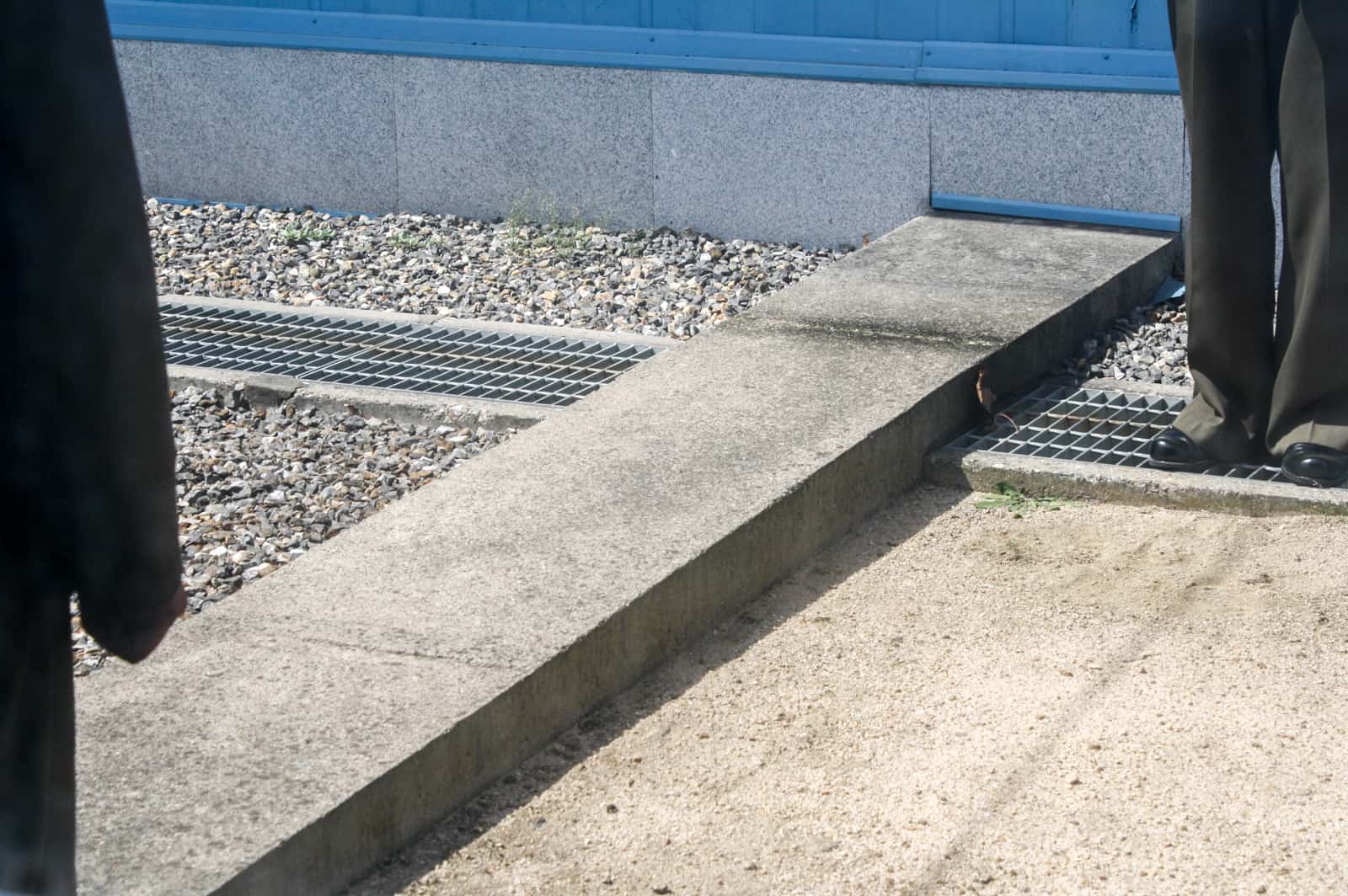
Misunderstood Destinations , North Korea , South Korea
Visit the DMZ in North Korea and South Korea – The Story From Both Sides
Disclaimer: This post contains affiliate links to handpicked partners, including tours, gear and booking sites. If you click through or buy something via one of them, I may receive a small commission. This is at no extra cost to you and allows this site to keep running.
To visit the DMZ from North Korea is tense and from South Korea, less so. What is it like to tour the DMZ and JSA and witness the world’s most heavily armed border?
I remember the first time I saw what visiting the DMZ in Korea was all about. I was 15 years old and watched Michael Palin go there on one of his travel series called Full Circle. He stood in a bland-looking room, spoke of the history of the Korean War, told us how he had to basically sign his life away on a piece of paper.
He then crossed an area of the room where there was a line marking on the floor. “Here I’m in North Korea,” he said, before moving his feet just a few inches and adding, “Now I’m in South Korea.”
I marvelled at the location of the DMZ, thinking about how you can stand in two countries at the same time, compounded by the horror that a divided Korea had such an intimidating, military-armed border. Would a trip to the world’s most heavily fortified border, dubbed “the scariest place on Earth” by former US President, Bill Clinton, during his visit in 1993, put a person’s life at risk in case of any outbreaks of gunfire, fighting, and attacks?
Rather, the DMZ Demilitarized Zone that slices Korea in two is something important to try and comprehend. Why does the DMZ exist? Is it a scary place? Why has the DMZ become a tourist attraction? Here’s what you need to know before you go.
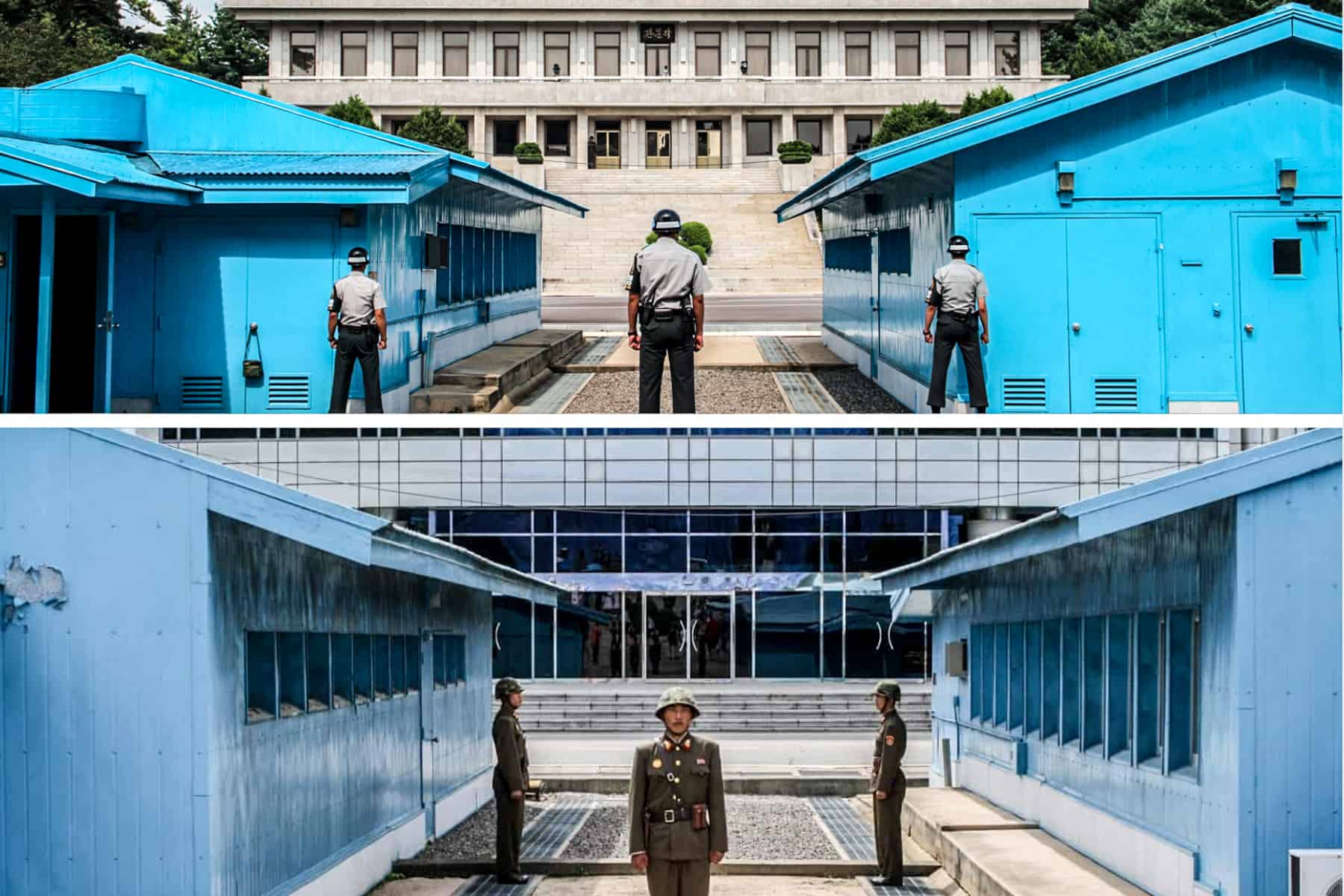
What is the DMZ Demilitarized Zone?
What part of the dmz do i see as a tourist, how to visit the dmz in north korea and south korea, the dmz in north korea (dprk), the dmz in south korea (republic), the reality when you tour the dmz, should a visiting the dmz be on your korea itinerary, dmz tour north korea, dmz tour south korea, planning to visit the dmz in korea save for later. .
The DMZ is a four-kilometre wide belt stretching 250 km, cutting the Korean peninsula almost in half at the 38 th parallel , and was put in place in 1953 as a ceasefire to the Korean War.
The Chinese and North Koreans pulled back 2km north and the UN forces 2km to the south, creating a ‘No Man’s Land’. Tanks, heavy artillery and mines exist on the Northern and Southern Limit Lines that are lined with barbed wire fences, but not within the DMZ itself, as was part of the armistice agreement.
Running through the middle of the 4km belt of ‘No Man’s Land’ is the Military Demarcation Line (the ‘actual’ border) and here sits Panmunjom – the “truce village”.
Within the neutral Panmunjom is the Joint Security Area (JSA). This is where negotiations between both sides took place and where today, democracy and communism now stand face-to-face in animosity. The Joint Security Area is the only section of the Korean DMZ where North and South Korean forces stand face-to-face.

The DMZ Military Demarcation Line at Panmunjom, Korea.
When you travel to the Korean DMZ on a tour, you will visit the JSA. Here, you enter the Military Armistice Commission Conference Room – the only place where anyone can freely ‘cross’ the Demarcation Line.
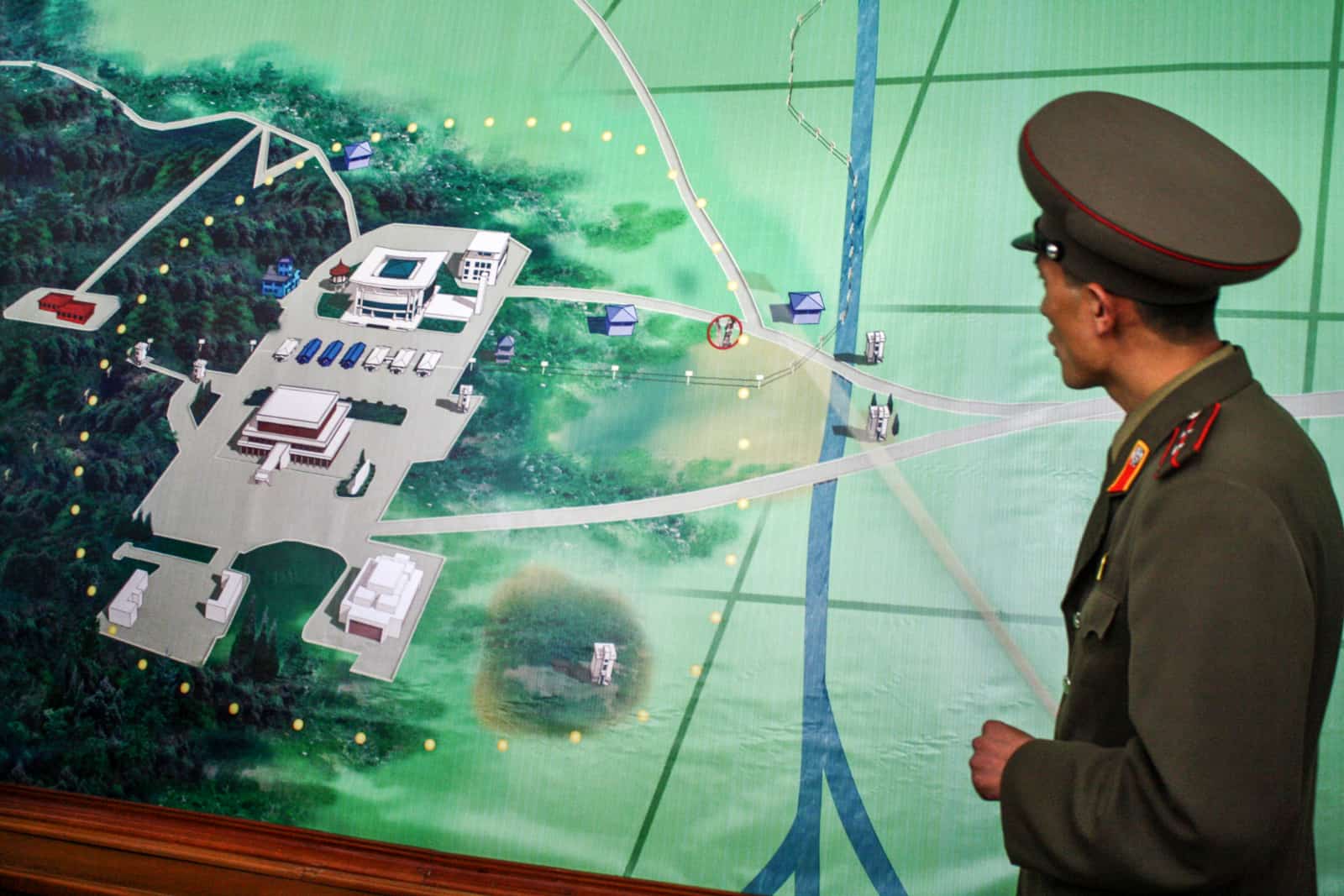
An explanation of the DMZ and JSA area by a North Korean guard.
I have seen the DMZ from both sides of Korea.
For me, it’s how I wanted to see and understand it – from the TWO viewing points in Panmunjom. I stood on the North Korean side in November 2012, and in South Korea a year later.
However, despite the viewing lines being only meters away from each other and the room you enter being the same one, they were both very different experiences.

North Korean Guards at the DMZ DPRK Side
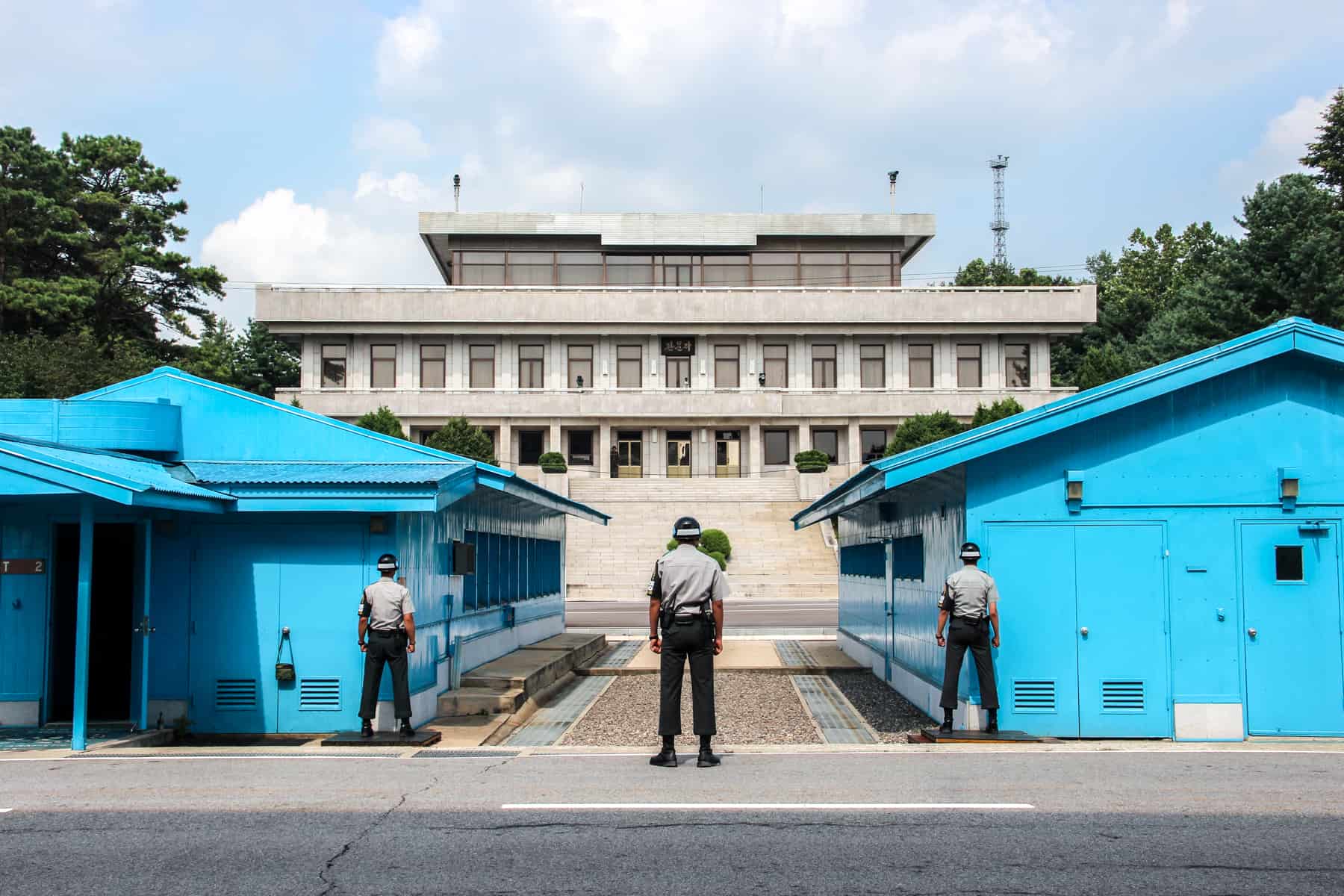
South Korean Guards at the DMZ facing the North Korean side
Visiting the DMZ from North Korea was filled with adrenalin and a little fear. Not only were we in the world’s most closed country, but we were also on the world’s most dangerous border between two countries still technically at war.
To say we were on our guard here, despite being in the safety of a group, is an understatement. It took us around three hours to reach Panmunjom from the Capital of Pyongyang, where we all waited at a busy check-in area (complete with souvenir shops) as we watched our North Korean guides have their passports swiped firmly out of their hands.
It was time to get on the coach and drive the short way to the JSA, driving through a long road lined with large square boulders that would fall and block the road should any sign of attack be imminent (the same tactic exists on the South Korean side).
It felt tense, yet we were calmed upon arrival by the opportunity to look through historical artefacts, documents, and historical boards in a building designated as a North Korea museum – propaganda and all. It was, in fact, where the Korean Armistice Agreement was signed.
Our North Korean military guide was an approachable man, and not half as scary as I imagined him to be. He spoke the North Korean version of events, yet it wasn’t as propaganda heavy as other situations we had found ourselves in. It felt far more serious here, being so close to the ‘opposition’.
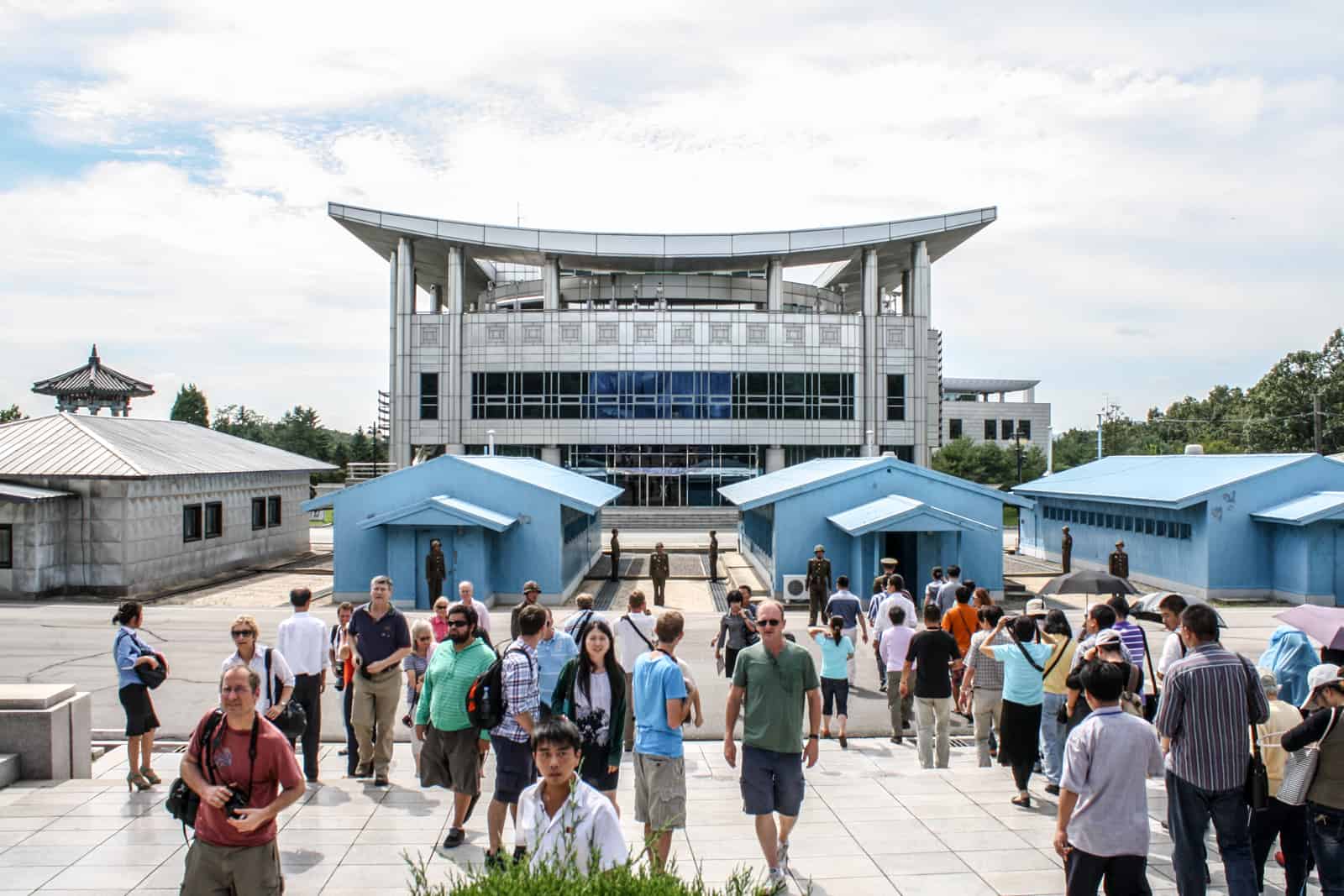
A DMZ JSA tour from North Korea.
Taking us through to the viewing platform, through an imposing, beige building, we all stood on the steps of the building looking out over to the building on the South Korean side. It was surprisingly calm, yet it felt incredibly eerie. No South Korean soldiers were present, just North Korean soldiers keeping guard.
There wasn’t the grand face-off we hear about in the media. I guess this is toned down during visits, with designated times given to both sides for tourist arrivals.
Only when we are gone, do they stand literally face-to-face with one another.
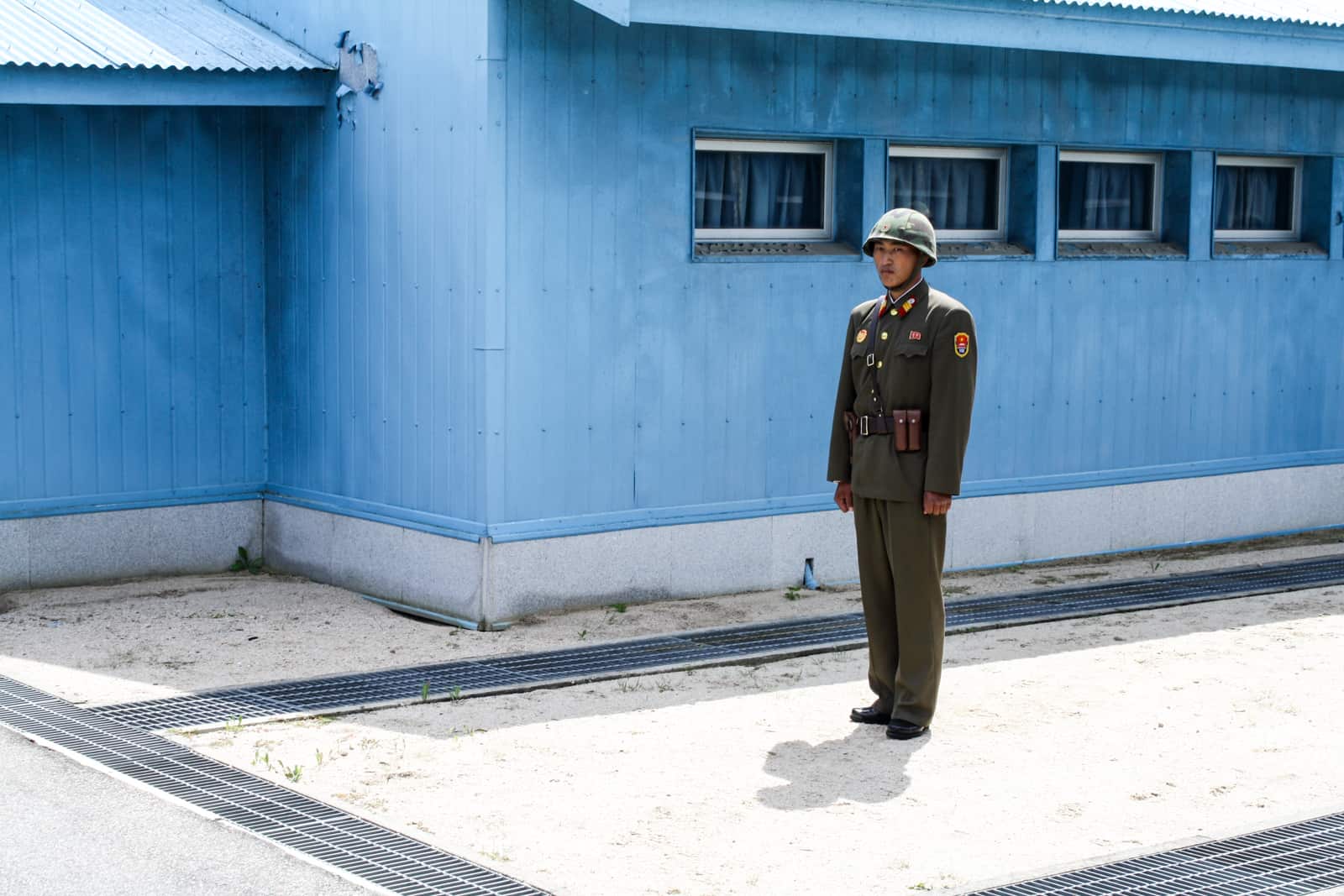
After 10 minutes or so, we were then taken into the blue hut – the Military Armistice Commission Conference Room that straddles the Demarcation Line. We were allowed to sit at the table (the ‘line’ cutting through the middle of the table) and, watched over by our guide, we all sat on either side of the table shaking hands across it, marking the peace we all wish for.
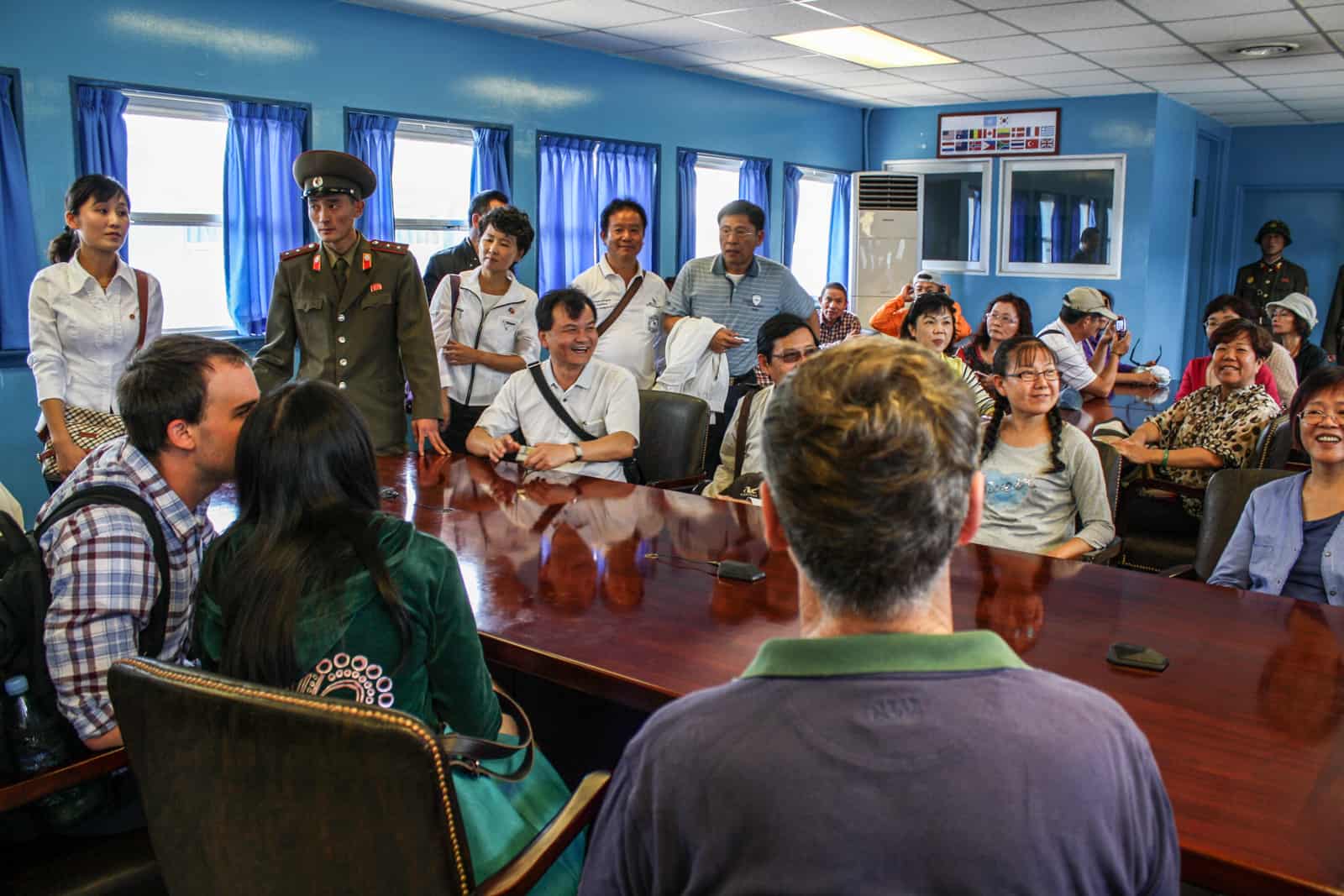
Visiting the DMZ Military Armistice Commission Conference Room
One North Korean guard stood staunchly guarding the door that leads to the South Korean side of the JSA, his fierce and set expression creating an atmosphere in the room that signalled this as very serious business. It was a day none of us could forget.
READ MORE: Travel to North Korea – Where Preconceptions and Reality Collide
In South Korea, DMZ tourism is a big business. Here, you can choose from a multitude of DMZ tours from Seoul, from full-day visits, JSA only tours to hikes and tours with North Korean defectors.
I decided on a full-day tour in order to see a series of historical sites and relics that can help formulate a better picture of the division between North and South Korea and setbacks to reunification.
The sites you see on this tour include:
The ‘Friendship Bridge’, a train station that links both countries via a single line, but whose full service is obviously not in use. However, some tours do allow you the opportunity to take a short journey on part of it, on the DMZ Peace Train from Imjingak to Dorosan Station, which you also visit.
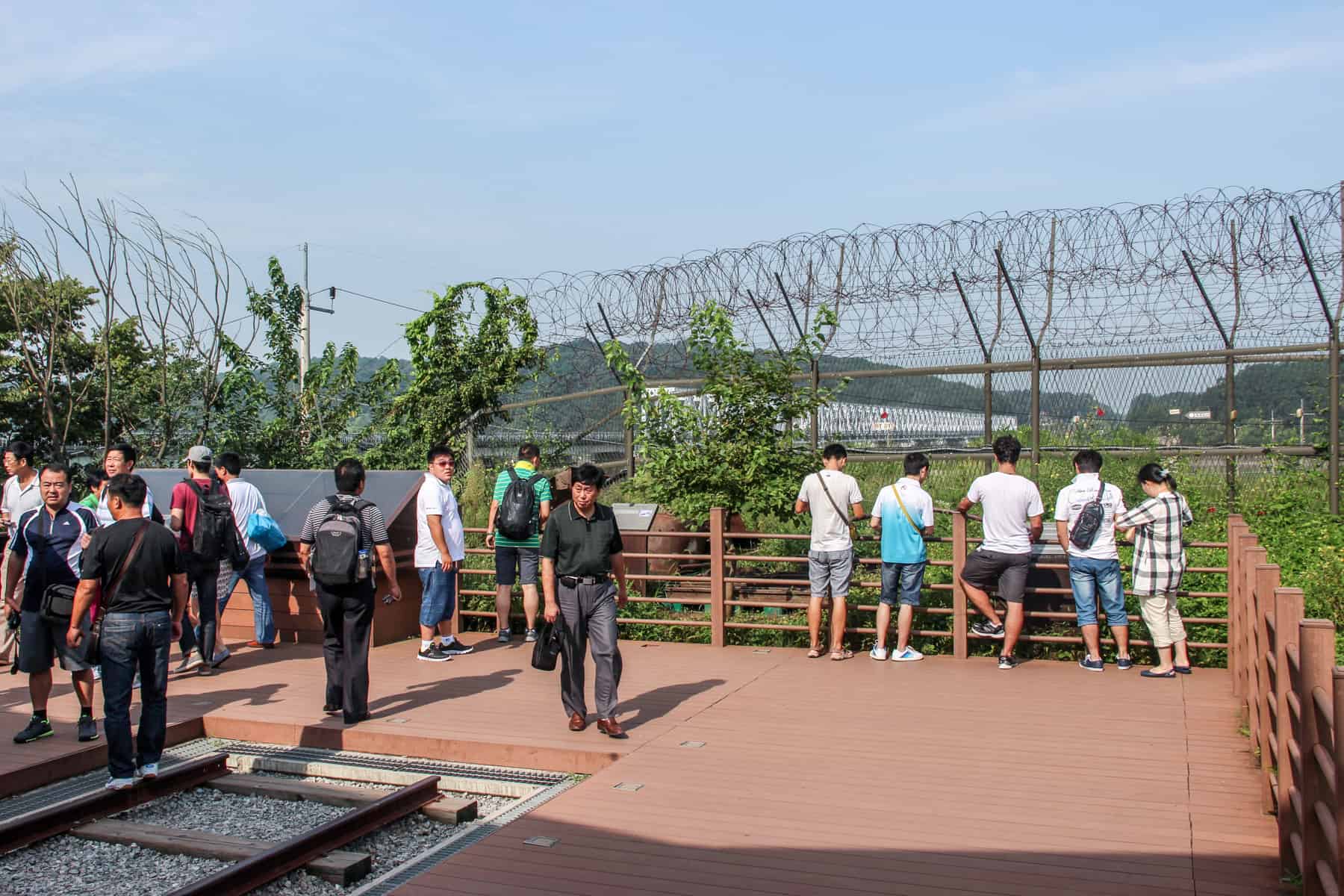
View to the Friendship bridge from unused sections of the railway line intended to connect South and North Korea.
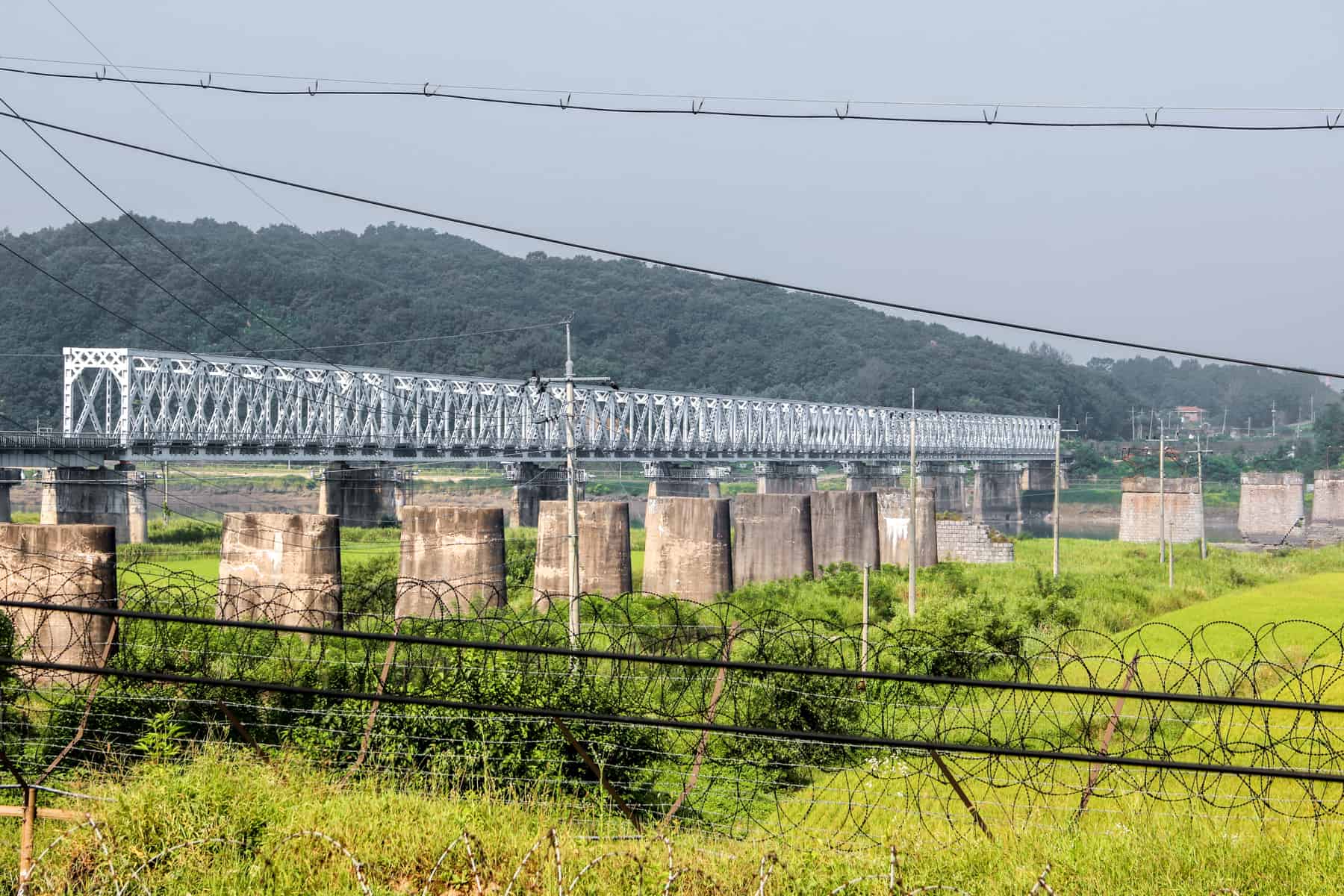
The Friendship Bridge – part of a railway intended to link both countries via a single line.
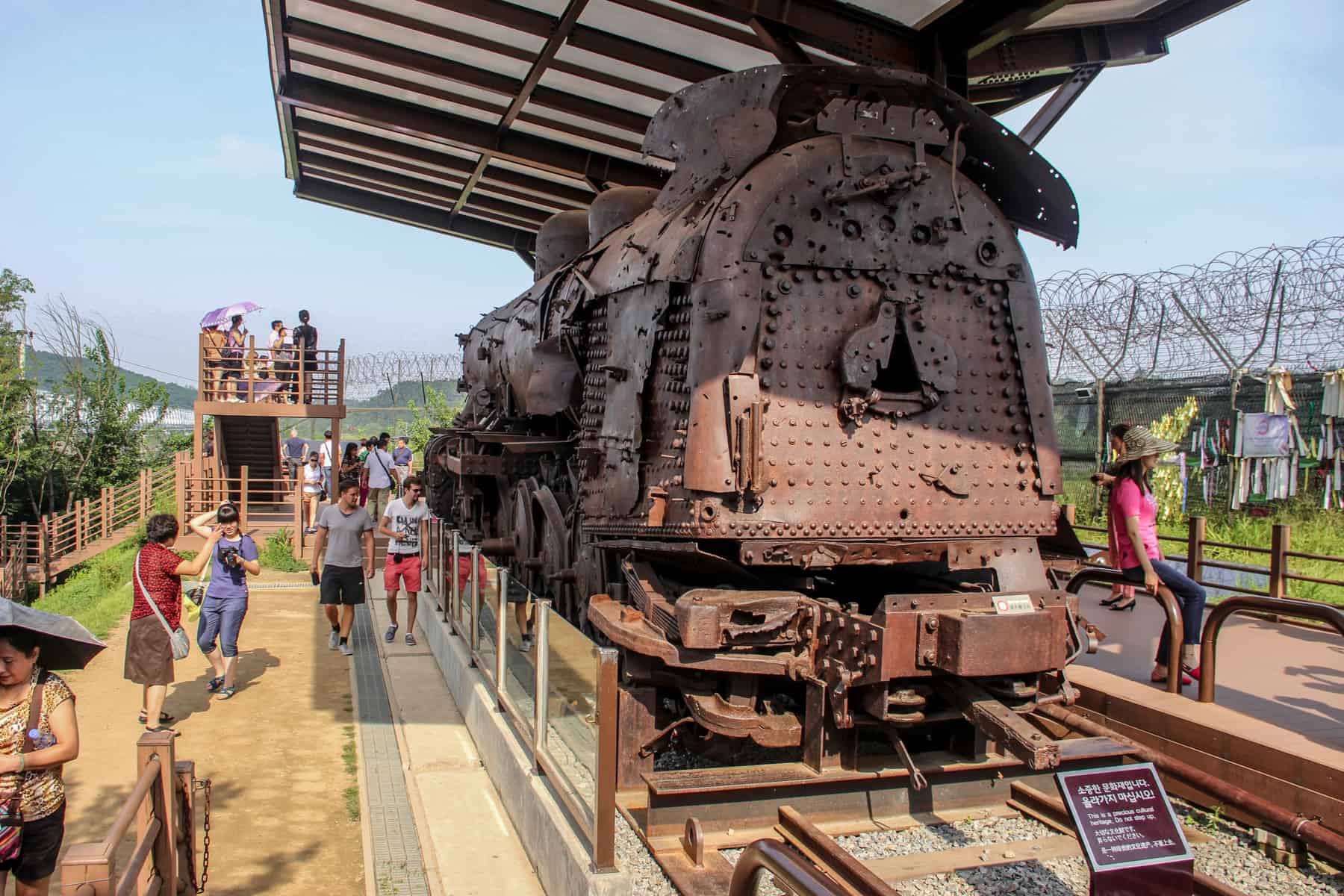
The metal relic of an old steam locomotive, derailed by bombs during the Korean War.
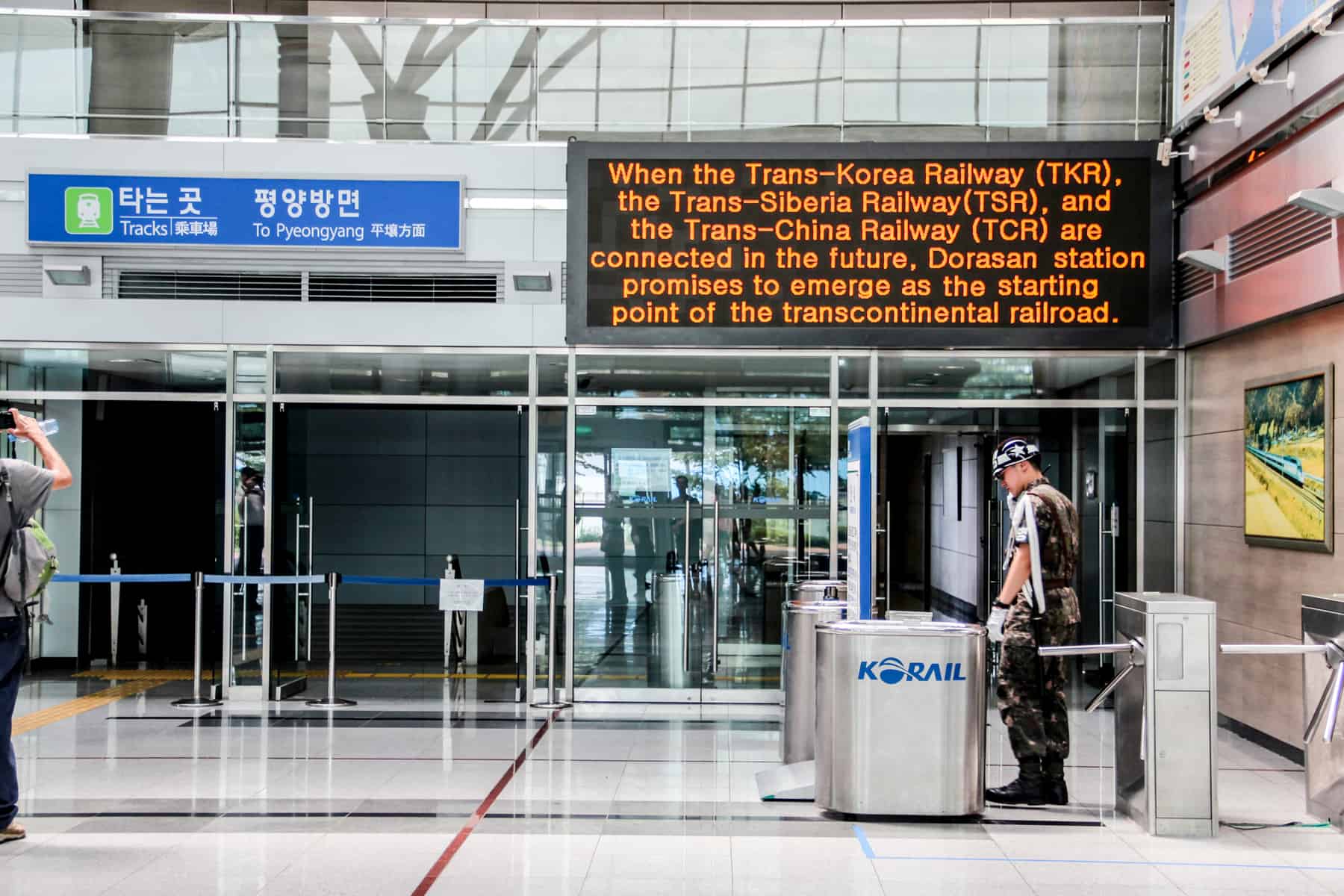
Inside Dorasan Train Station – part of the ‘Peace Train’ intended to connect to Pyeongyang, the capital of North Korea.
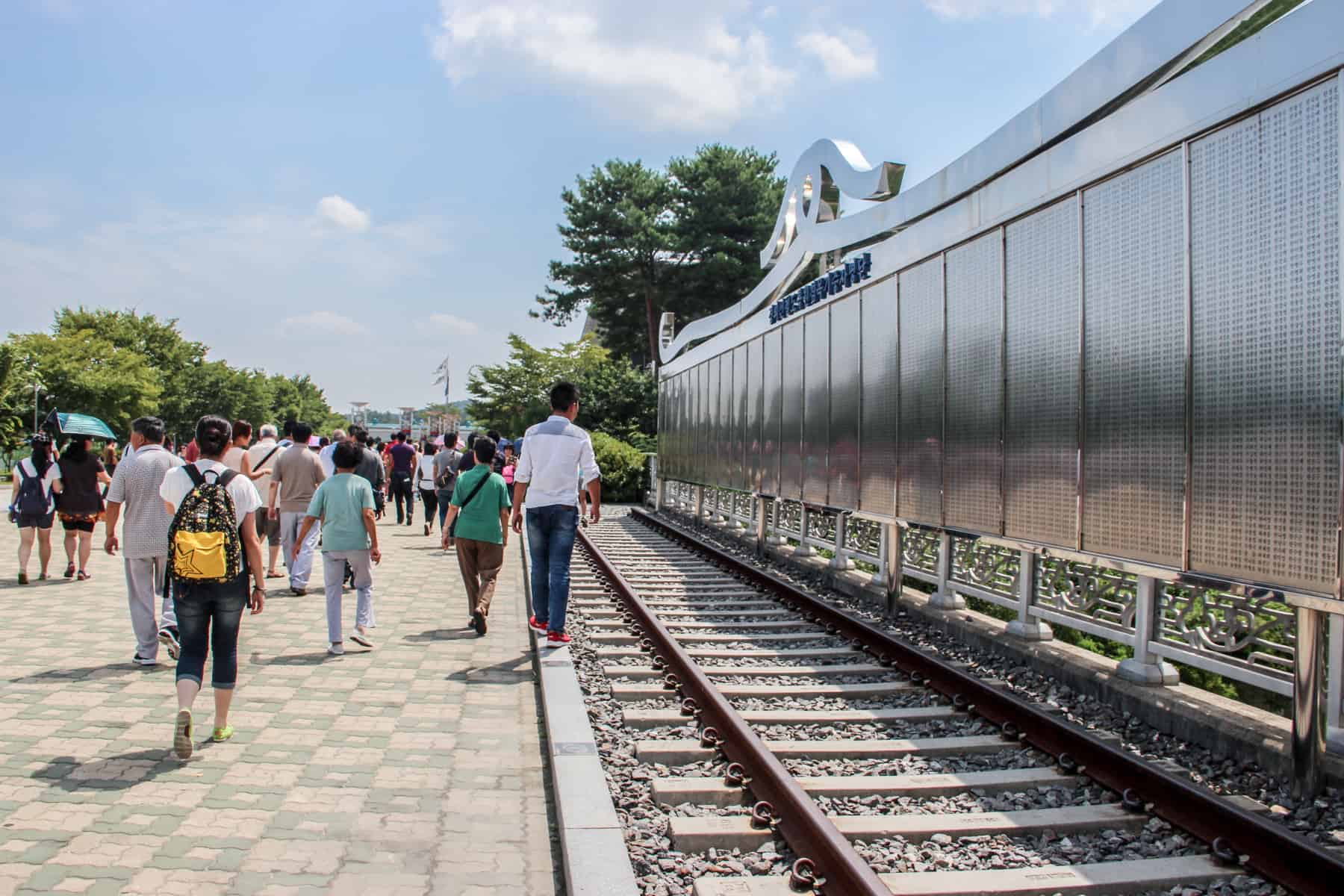
Dorasan Train Station Memorial.
The Dora Observatory where you can look out over North Korea. The most prominent lookout point is to the North Korean ‘Propaganda Village’.
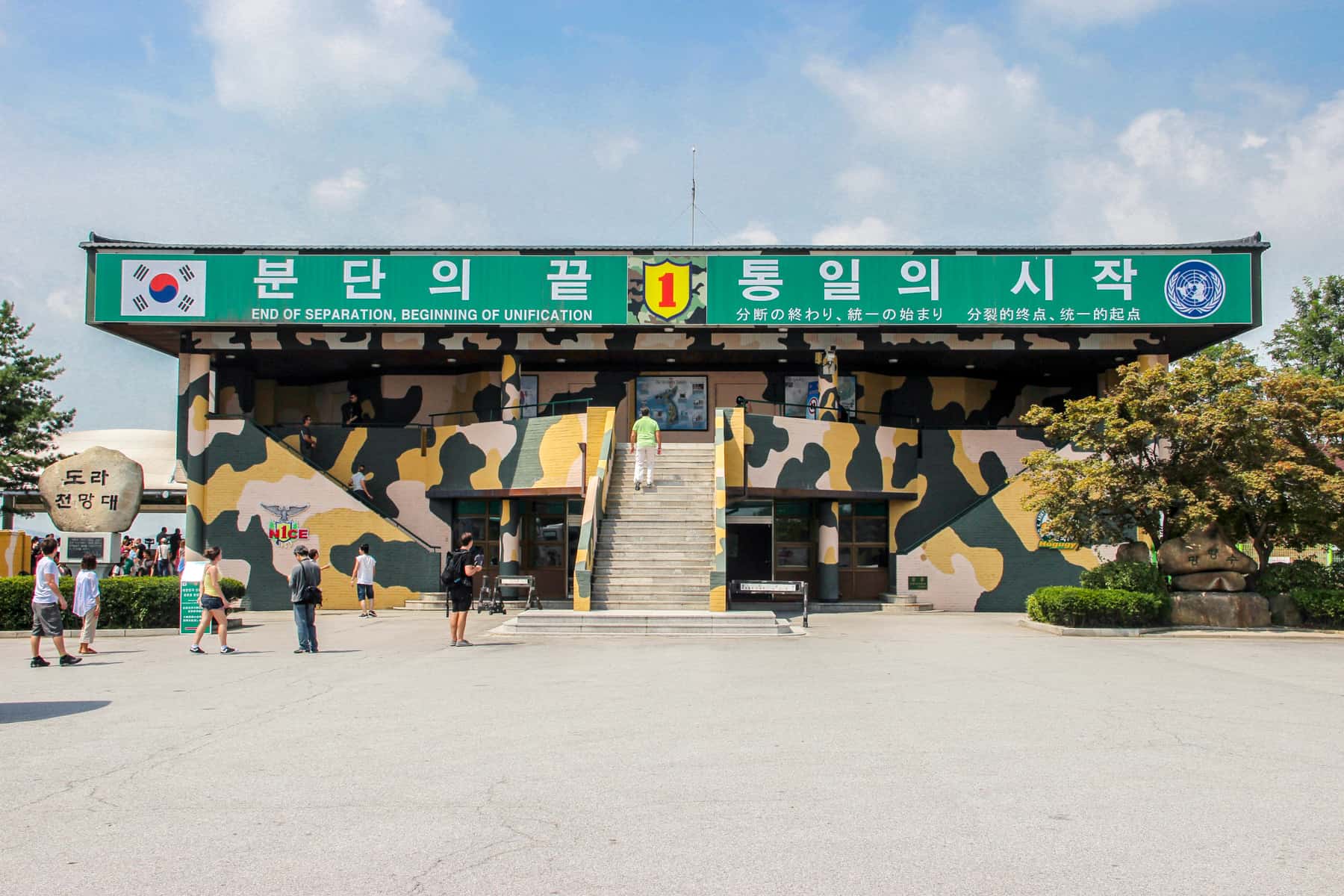
The Dora Observatory at the DMZ – the main lookout point facing North Korea.
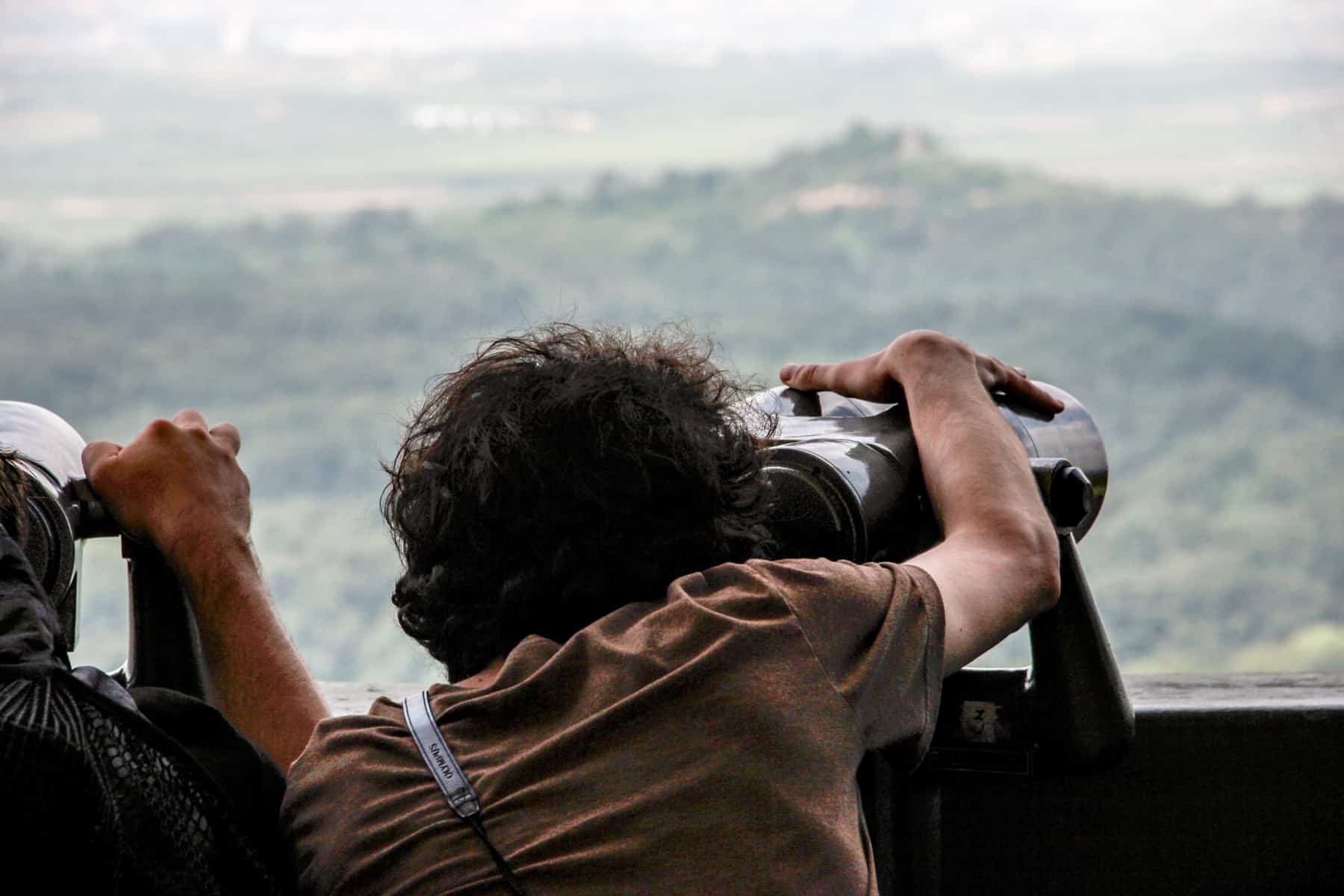
Binocular views to North Korea.
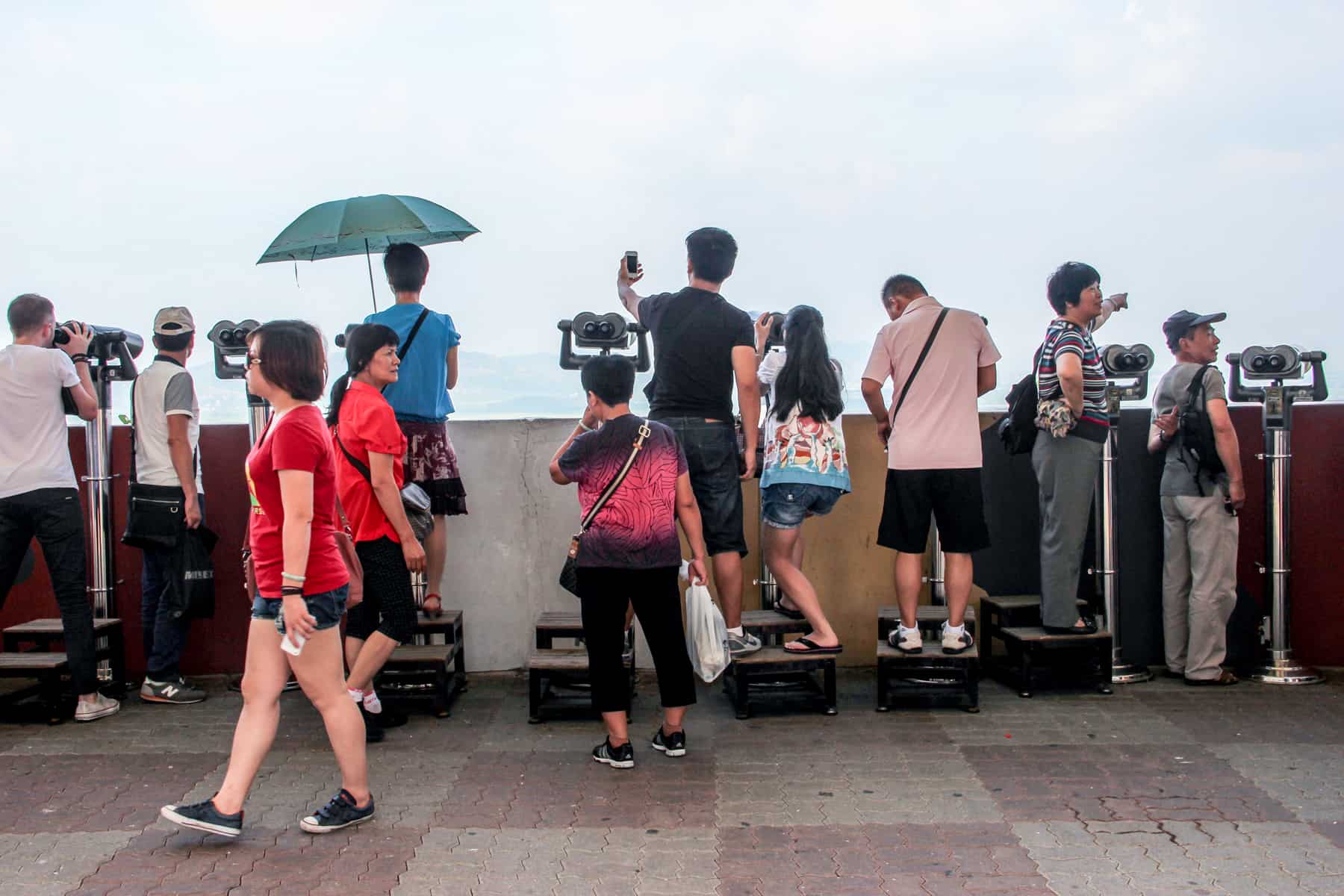
The Dora Observatory where visitors eagerly gaze into North Korea’s Propaganda Village.
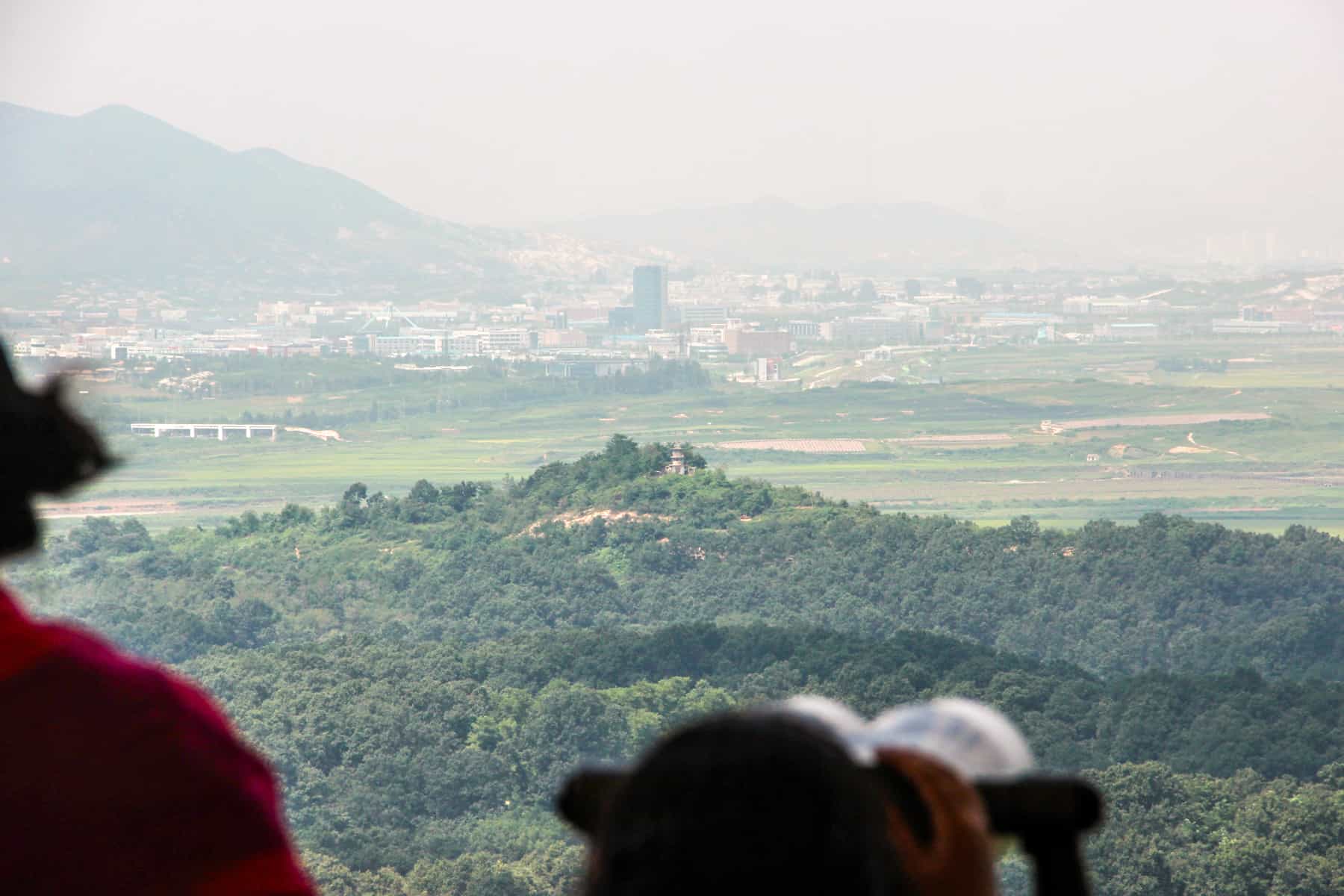
The North Korea Propaganda Village as seen on a DMZ tour.
The 3 rd Tunnel (Third Infiltration Tunnel) – a 1,632m tunnel dug by the North Koreans, from which they could pass through into Seoul within an hour and invade, alongside tourism documentation and video centres.
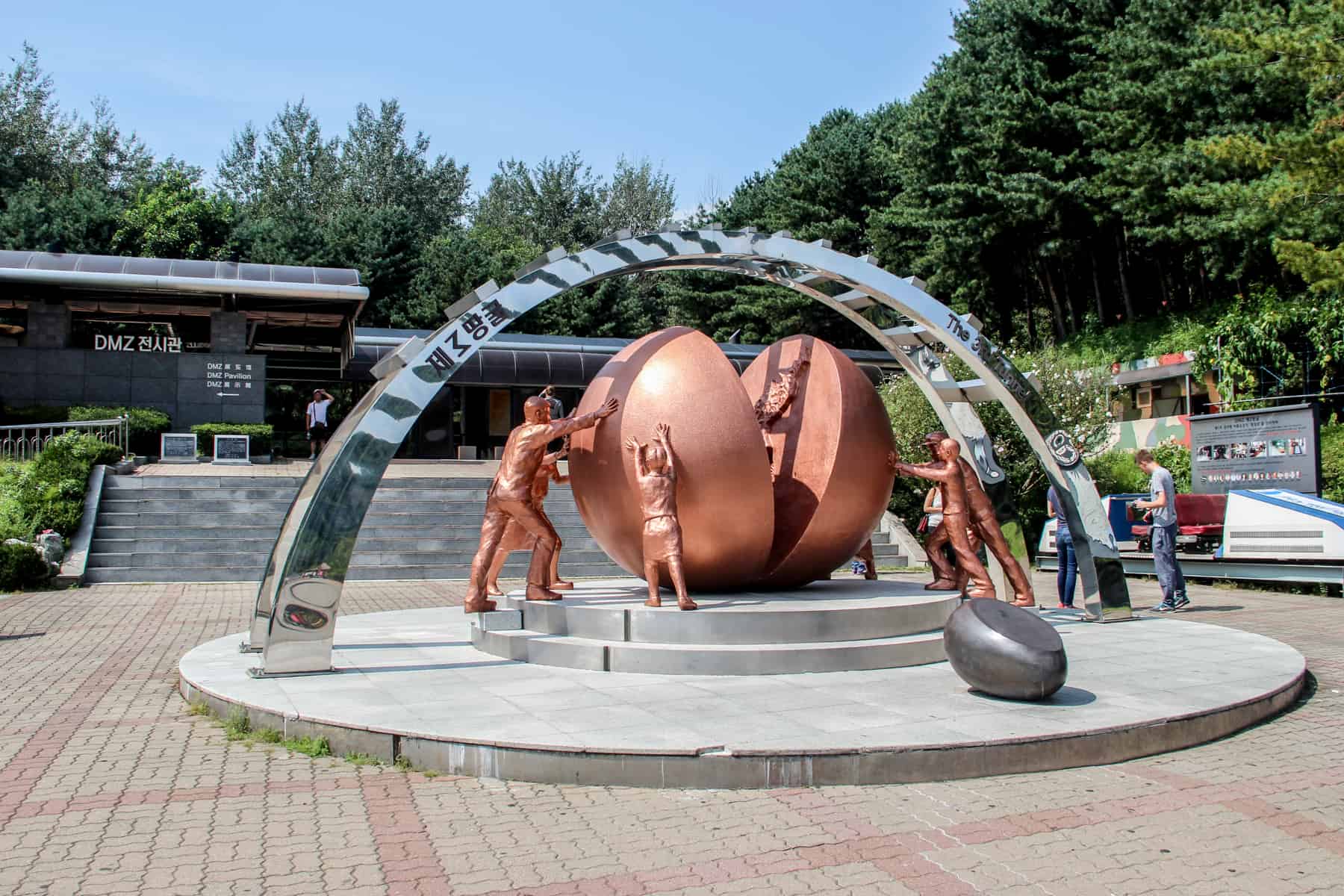
The artwork depicting reunification, marking the entrance site of the Third Infiltration Tunnel at the DMZ.
The last stop of the DMZ tour is the main site – the Joint Security Area (JSA) at Panmunjom. Here, you are shown a video and given a short introduction about South Korea’s version of events and how the US military operates here, before visiting the Military Armistice Commission Conference Room (one if the blue buildings). You are not allowed to sit down or touch anything in the Conference Room, contrary to the more relaxed visit when entering from the North Korean side.
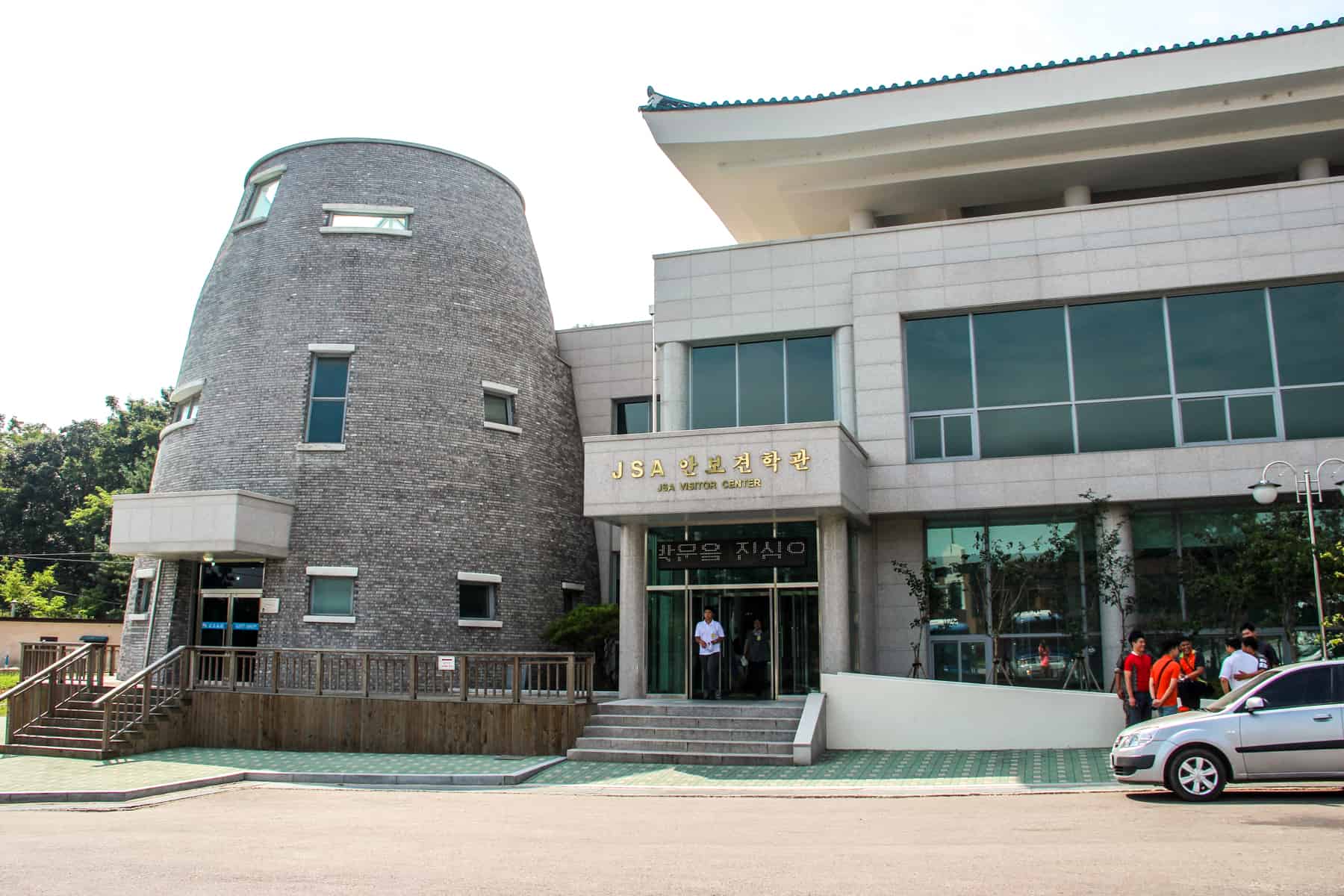
The most significant site when you tour the DMZ, is the Joint Security Area (JSA) Visitor Centre.
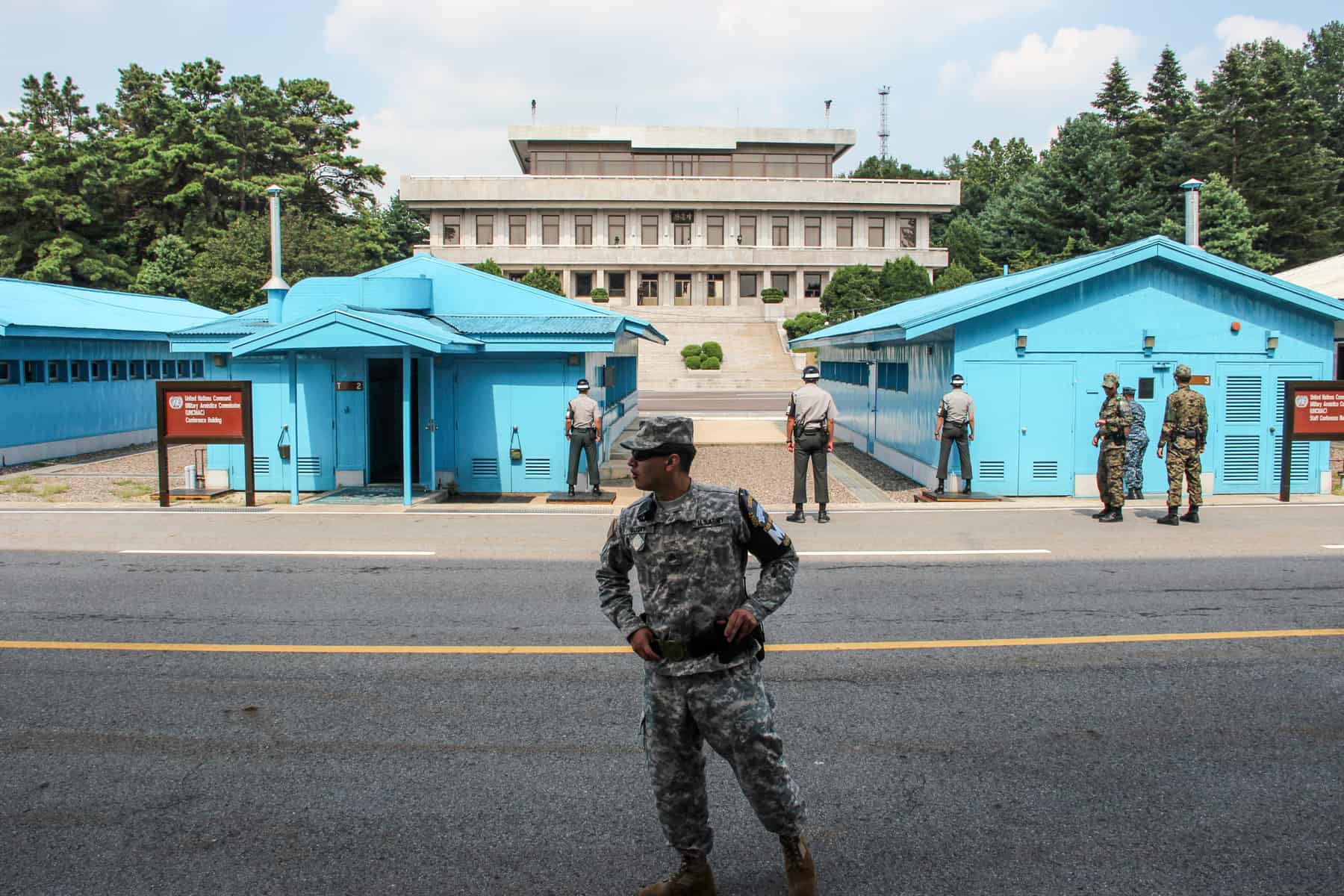
American military guides you throughout the JSA tour, seen here before entering the Conference Room.
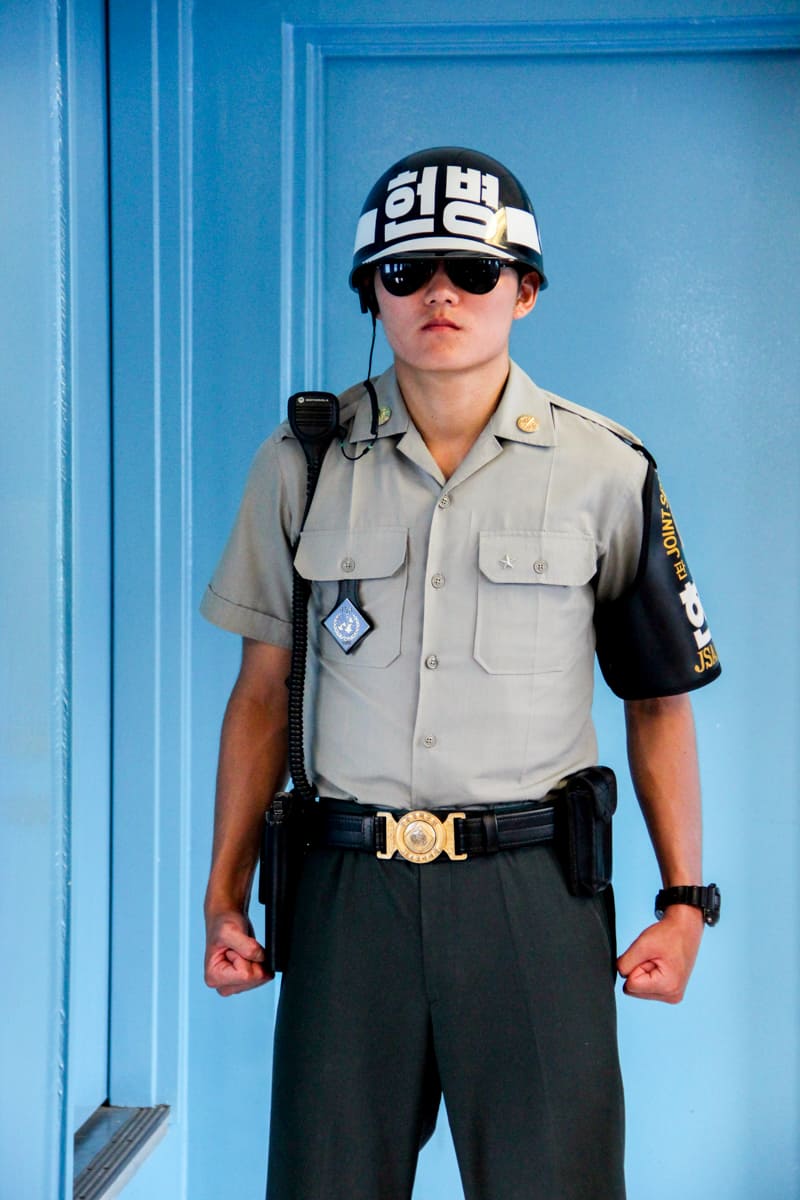
A South Korean guard in Taekwondo stance inside the Military Armistice Commission Conference Room.
As a tourist site, there are a few aspects of the DMZ tours that conflict with the seriousness of the situation.
For many of the tourists at the DMZ, I don’t think they really understood exactly where they were. At times, it felt like a day trip to Disneyland. This is at no fault of the tour company, which facilitates your transport between each of the sites and provides knowledgeable background and historical insights on the coach along the way, but the fault of who is behind the tourism surrounding this particular area. It could be the government, or whoever thought it was acceptable to build a fairground next to the area where the bridge is. Or those who thought it was acceptable to allow the Observation Deck to turn into a zoo-like atmosphere, surrounded by the screams of people looking through telescopes exclaiming, “Oh.My.God. I just saw an actual North Korean.” Yes, this really happened.
Never once did I feel the DMZ visit in South Korea was a serious issue or treated as a serious place. The US soldier, our guide, was young, knowledgeable and delivered a fantastic presentation that was factual and historically sound. Yet, for the most part, it’s treated as a bit of fun peering into the hermit kingdom. While people on the ground cannot change the ignorance and stupidity of some of the tourists who visit, there could be more educational markers put in place and the enforcement of more rules to encourage a little respect.
I felt that ‘reunification’ was nothing more than a throwaway term , later confounded by many South Koreans I met who said: “Many of us are not bothered by it”.
North Korean guards were present; they lurked in the shadows and behind the pillars of the beige building I had once stood at months before. We were informed of some rules to follow – we were not to take pictures of any North Korean guards that may appear in the building in the background, and not to make any faces or hand gestures that they can film and use as propaganda, or as a means of retaliation. Whilst I felt safe, the viewing point time felt unnerving, especially being around US soldiers who had a frivolous, laddish, macho attitude, and were themselves making gestures.
Time in the JSA conference room is more strict. Back in the blue building (the Military Armistice Commission Conference Room), we were once again told about the DMZ and the guard line, except we were not allowed to sit at the table, only stand around it. South Korean guards stood in their fierce Taekwondo stance – something of which they are famous for – yet tourists giggled and replicated the pose for photos.
That was something we would never have dreamt of doing on the North Korean side.
READ MORE: Travelling in South Korea – A Guide (But Glad I Gave it a Chance)
A visit to the DMZ is without a doubt an eye-opener and a must-see for those interested in history and current affairs. While a visit to North Korea is undoubtedly going to be fuelled by a more serious attitude, where you have to be guarded and ‘on your best behaviour’ at all times, I sadly think people miss the point when visiting on the South Korean side. A few people around me expressed disappointment with the way things were handled.
It’s a given that the majority of visitors will visit from South Korea, and so I would personally cut out the full-day tour and just stick with the specific JSA tour, yet be prepared for mixed signals regarding the seriousness of the current situation. However, for those with a deep interest in what is going on here, you will certainly take a lot more from the full-day visit of multiple sites.
As one South Korean woman said to me: “People have lost the meaning of what the DMZ is and what it’s there for. Like it’s a fun thing to do.” So when you visit the DMZ be sure to remember exactly what it stands for, why it exists and the people who have died protecting the border or trying to escape from it.
Book a DMZ Tour
I visited the DMZ on the North Korean side during my trip to the country with Koryo Tours. The JSA tour formed one afternoon as part of a seven-day trip to the country.
In South Korea, my visit to the DMZ was a day tour with VIP Travel, considered to be the best DMZ/JSR tour agency in Seoul.
The full-day ‘DMZ and Panmunjeom Tour’ (from 8 am until 5 pm) runs every day (except on Sundays, Mondays, National Holidays, and Military Training Days) and costs 135,000 Korean Won / around $120 US per person. You can read a full overview of the trip here.
The sites you see on this tour are: Imjingak Park → The Bridge of Freedom → The 3rd Infiltration Tunnel → DMZ Theater & Exhibition Hall → Dora Observatory → Dorasan Station → Pass by Unification Village → ID Check Point → Camp Bonifas → JSA (Freedom House, Conference Room)
Bookings need to be made at least 48 hours before the chosen day of the tour.
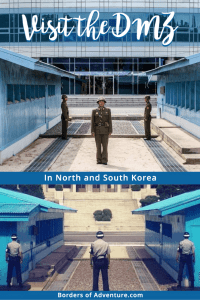
About Becki
Becki Enright is a British Travel Press Award-winning writer whose work focuses on changing perceptions about misunderstood aspects of destinations. Her writing combines storytelling with insight into the social, historical, political and economic factors that shape the country or place in relation to tourism. Becki has appeared live on Sky News and CNN and has contributed to high profile media including National Geographic, Time.com, Guardian online, New York Times, Grazia and Buzzfeed.
Arthur Hernandez says
16 March 2019 at 6:00 am
December 1967 thru January 1968. I was assigned as an Army medic to an infantry company with the 2nd Infantry Division that made patrols along the DMZ. We lived in tents in the JSA area. I remember that there was a chopper pad, a small hut that served as a PX where we bought Playboy, candy, writing stationery, tooth paste and other small items that were part of our infantry lives. Along the DMZ on our patrols there was not much of a fence and sometimes you would see holes that had been cut so that a person(s) could make their way through. We found a tunnel and the Captain lined up five infantry guys shoulder to shoulder with full packs to get an idea of how many troops could pass through. I remember Freedom Village, Freedom Bridge and the Imjin River. Most of all, I remember the grunts, the Infantry guys. I do not remember so much their names but their faces when it was bitter cold and it snowed or it rained sheets of rain and they did guard duty in foxholes manning the 50 caliber machine gun. During this time period, the Pueblo ship was seized and North Korean infiltrators came across to kill the South Korean President. On one of our patrols, we captured two of them and killed one of them who was about to throw a grenade. Second Infantry Division-Second to None! I salute the grunts who called me Doc and took care of me. I still remember.
- Article Archives
- Work with me
- Privacy Policy

The 5 Best DMZ Tours From Seoul [2024 Reviews]
It’s no secret that Seoul has become one of the hottest travel destinations in recent years, from the explosion of K-POP to the centuries-old temples and rich history. Of course, just like everywhere else in the world, South Korea also has its fair share of tourist traps.
One thing’s for sure, though, you won’t regret taking a DMZ tour! This journey into the heart of Asian history takes you to the edge of two very different worlds, with palpable tension and stories forever etched into the landscape.
Whether you’re a history buff or would simply like to explore the “path less traveled”, you’re going to be fascinated by these top tours of the DMZ from Seoul! Let’s jump right in!
Best DMZ Tours From Seoul
Quick answer: the 5 best rated dmz tours from seoul for 2024.
- Private DMZ the 3rd Tunnel Tour from Seoul (No Forced Shopping)
- DMZ Full day with Gloucester Memorial & Suspension Bridge Tour
- From Seoul: DMZ, 3rd Tunnel & Suspension Bridge Guided Tour
- Best DMZ 3rd Infiltration Tunnel Tour from Seoul (No Shopping)
- Free Style Private Tour(Seoul/DMZ)
DMZ Tour Reviews
1. private dmz the 3rd tunnel tour from seoul (no forced shopping).
- Duration: 8 hours
- Departure: Hotel pickup and drop-off available
- Departure Time: 7:30, 8:30, 9:30 AM
- Includes: Professional English-speaking guide, transportation, all taxes & fees
Let’s start things off on the right foot with one of the most unique tours one can take in South Korea!
The Private DMZ the 3rd Tunnel Tour from Seoul will lead you through this incredibly important historical site with an expert guide who will provide you with cultural context throughout your time with them.
If you have a full day available and would like to see the country in a different perspective, look no further than this excursion. The Korean Demilitarized Zone, more commonly-known as “the DMZ”, is the most heavily-fortified border on the planet.
It’s definitely not all fun and games, but this “real deal” experience will get you as close as possible to experiencing the tension, mysteries, and stories that have unfolded between these two divided nations.
Around 4km wide, this modern-day “No Man’s Land” doesn’t allow any military personnel, activities, and much less, civilians. The only exception to this rule is a place called the “Joint Security Area”, which is a neutral ground where soldiers from both sides come together for talks and negotiation.
Expand To See More See Less
One of the highlights of the tour was climbing the heights of the Dora Observatory, complete with high-powered binoculars for you to see the North’s propaganda village.
When the weather is clear, you may even be able to see the bronze statue of Kim Il-sung, casting a watchful eye over the divide.
Then, you’ll get to see the Third Tunnel subterranean passage discovered in the 1970s and stretching nearly 2,000 meters long. This secret conduit screams espionage and conspiracy, with North Korea having built it then denying it.
Oh boy, there are a ton of interesting stories surrounding it and your guide will fill you in on some of the most captivating.
Tour Information & Booking
100% refund for cancellations within 24 hours of tour experience, 2. dmz full day with gloucester memorial & suspension bridge tour.
- Duration: 9 hours
- Departure Time: 7:00 AM
- Includes: Full-day tour of the DMZ and suspension bridge, professional guide, all fees and taxes
Next up, we have a full-day tour that will take you for an immersive experience through some of the most iconic locations around South Korea.
The DMZ Full Day with Gloucester Memorial & Suspension Bridge Tour is full of thrills, intrigue, and incredible views to the unknown. With a guide to share historical accounts and plenty of personal stories with each location visit, you’re sure to view the country from a different viewpoint!
Starting off at 7:00 am, you’ll be picked up right from your hotel by your professional guide in a climate-controlled coach with plenty of legroom and big windows.
Upon arrival to Imjingak Park, you’ll get to see the Freedom Bridge and old steam trains, which was pretty cool by itself. The guide was there to teach us about the Korean War and the sacrifices that needed to be made, which only enriched the experience.
While I enjoyed the entire tour, the most memorable part for me was seeing the Gloucestershire Regiment “Gloster Hill”, which commemorates the actions of the regiment and C Troop, 17th Mortar Battery, Royal Artillery of the British Army during the Battle of the Imjin River.
Nearby is the incredible rope bridge known as the “Gloucester Heroes Bridge” which was a bloody battle field during the Korean War. Today, it stands as the longest suspension bridge in the country, sitting over 700 meters above sea level!
Finally, you’ll get to see the DMZ exhibition hall and learn about the old weapons, which was pretty cool! Next, make the walk over to the Third Tunnel which was made by North Korea, who actually claimed the South had constructed it with the intention of a guerilla attack!
The Dora Observatory was crazy to see, showing you a peek into North Korea’s propaganda village with the high-powered telescopes.
3. From Seoul: DMZ, 3rd Tunnel & Suspension Bridge Guided Tour
- Departure: 65-6 Chungmuro 2(i)-ga, Jung-gu, Seoul
- Departure Time: 7:00 AM
- Includes: Licensed professional guide, roundtrip transfer from Seoul, admission fees to DMZ, monotrail tour in 3rd tunnel or walking tour for shared tour option
This next tour is one of my favorites, seamlessly combining incredible nature views with the rich and varied history of South Korea. If you consider yourself an adventurous person who enjoys those “more unique” tourist sites, this one’s for you!
The DMZ, 3rd Tunnel & Suspension Bridge Guided Tour is one of the only ways you can actually see a glimpse of North Korea in person, offering a deep dive into the history of the area.
First things first, though: you’ll have to pick either the private or the shared tour option. For the private tour, you’ll travel with only your party and go on a monorail tour in the Third Tunnel.
For the shared tour option, you’ll obviously be traveling with strangers and will instead go on a walking tour in the Third Tunnel – either way, they’re great options!
After being picked up from your hotel, you’ll arrive and get to see the Freedom Bridge, Mangbaedan Altar, as well as an old steam locomotive that was destroyed during the Korean War.
Your guide will be there to tell you all about how the Korean War affected the country and landscape – particularly on the border. You’ll then visit 4 different locations at the DMZ, starting with the Third Infiltration Tunnel.
Whether you’re walking or monorailing in, you’re sure to get a bit of a creepy vibe as you enter this “lair”. After, check out the Dorasan Observatory, which allows you to see into North Korea from their superpowered binoculars!
You can also choose to explore some Unification Villages located in a buffer zone and is civilian controlled by the government. Then take a hike around 15 to 20 minutes and appreciate the Gamaksan Suspension Bridge, which has quite the intense history of its own.
If time allows, you’ll even get to see the Majang Suspension Bridge located right at a glass-like lake perfect for taking some photos.
4. Best DMZ 3rd Infiltration Tunnel Tour from Seoul (No Shopping)
- Duration: 7.5 hours
- Departure Time: Varies
- Includes: Professional English-speaking guide, all taxes and fees
You know what’s really annoying when you’re on a trip and trying to maximize your time by seeing as many interesting things as possible?
When your tour guide “forces” you and your group to go shopping at specific stores and markets. There’s none of that nonsense with this next tour – the Best DMZ 3rd Infiltration Tunnel Tour from Seoul is all about learning in a fun and interesting way!
This is another one of my top recommendations if you’re looking to escape the hustle and bustle of Seoul. You’ll get picked up in the morning by your guide and make the trip on a comfortable, air-conditioned coach with plenty of unobstructed views along the way.
Right from the get-go, I did notice that our guide did a fantastic job at providing detail and easy-to-digest historical accounts and personal anecdotes which made it that much more fascinating.
Upon arrival, you’ll get to see the Imjingak Pyeonghoa-Nuri park and learn about how it was constructed to house the refugees who left North Korea during the Korean War.
After that, check out the Bridge of Freedom which was also made to free almost 13,000 prisoners during the war. It’s not only incredibly moving to learn about, it’s set in one of the most beautiful natural settings ideal for photo ops!
After that, it’s time to head to the DMZ Theater where you’ll watch a short film about the war, and the South Korean perspective on it. You’ll learn how the DMZ came to be what it is today, as well as get time to walk through the creepy Third Infiltration Tunnel.
It definitely gives you a deeper understanding of just how serious this situation is, and the photos and artifacts only help.
5. Free Style Private Tour(Seoul/DMZ)
- Duration: 7 to 8 hours
- Includes: Air-conditioned vehicle, private transportation, English-speaking guide
One thing that many people may be turned off about tours, is that you’re obligated to go on one set schedule. The great thing, is that many tours offer the option of creating a custom itinerary designed around your specific interests!
The Free Style Private Tour (Seoul/DMZ) is one of my favorites, catering to your tastes to ensure you’ll see the things you’re most captivated by!
If you’re a history buff, or really into Korean culture or food, you can tell your guide and they’ll create a personalized agenda just for that. While the tours will never be exactly the same, there are plenty of options to choose from.
Start off with your guide picking you right up from your hotel in a private, air-conditioned vehicle made to transport only you and the rest of your party.
As you do get to choose, it’s quite possibly the best way to maximize your time in Korea – especially if it’s your first time there and/or you are there for only a couple of days.
While it’s not necessary, I definitely recommend going to the Gyungbokgung Palace, which is the most popular of the 5 in total in the city. You can then head up by car to the top of the mountain peak, whick offers some of the most breathtaking views of Seoul possible.
After that, head to a local eatery for a delicious, traditionally Korean lunch which has been reviewed by some of the top publications in the world. Follow it up with a trip up to the N-Seoul Tower by cable car, or head over to the DMZ, of course!
The DMZ, as you already know by now, is a must-see and is the one way to really gain insight into the tension between these two neighboring nations.
FAQs About the Korean DMZ
Q: what is the dmz in korea.
A: The DMZ or Demilitarized Zone, is a strip of land the is about 2.5 miles wide the runs across the Korean Peninsula near the 38th parallel north. It’s a buffer between North and South Korea, that are still technically at war because the war ended with an armistice and not a peace agreement.
Q: Do I have to take a tour to visit the DMZ?
A: Yes, you can only go to the DMZ on a guided tour. You can book them online or through travel agencies. You can take a half-day, full-day, or private tours, that show you different sites and activities in the DMZ. The most popular attraction is the Joint Security Area (JSA) which is where negotiations took place. The Third Tunnel of Aggression, was dug by North Korea to infiltrate South Korea and the Dora Observatory where you can see North Korea with a telescope.
Q: Is it safe to visit the DMZ?
A: You may be wondering if it’s safe to visit the DMZ. While the Korean DMZ is considered “the world’s most dangerous border”, there is no danger to visitors. Just make sure you follow the rules and instructions of the tour guides.
Tour Guides
The Private DMZ the 3rd Tunnel Tour from Seoul is our Editors Choice for the best DMZ tour from Seoul.
Richard Remick
Related articles, the 5 best taj majal tours from new delhi [2024 reviews], the 5 best halong bay cruises [2024 reviews], ▷ the 5 best hanoi city tours [2024 reviews], ▷ the 5 best mekong delta & cu chi tunnels tours [2024 reviews].
- Privacy Policy

- Disclosure Policy
- Travel Tips
- 109 Genius Travel Hacks
- Teach Abroad
- Work With Us
Asia Guides
Dmz tour review | everything you need to know.
A DMZ tour from Seoul is an experience you should not miss whilst you’re in South Korea. With this tour, you can take a glimpse into life in North Korea, whilst soaking up the tragic history of how a nation became divided. Read on to find our DMZ tour review. Find out how to book a tour, the different costs, and the day’s itinerary.
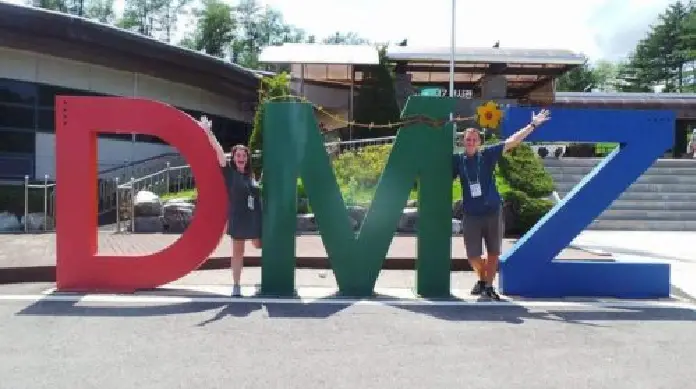
Disclosure: Untold Wanderlust contains affiliate links. If you click on these links and make a purchase, we will earn a small commission at no extra cost to you. You can find our full disclosure policy and privacy policy here.
Preparing for the DMZ tour from Seoul
The day had arrived, and we were very excited about our trip to the North Korean border. Stupidly, the first time we visited Seoul we didn’t realise that we needed to book the DMZ tour a few days in advance. So, when we called a tour agency 2-days before we were due to leave for Japan, we were more than gutted to be told that we can’t book a tour at such short notice. As the tour was something we really wanted to do, we decided to head back to Seoul after backpacking Japan.
DMZ tour types
There are two types of tours; the demilitarized zone tour (DMZ), and the demilitarized zone tour with joint security area (JSA). The difference? Not much, other than that the JSA is where you actually step foot into North Korean territory and get up close to North Korean soldiers.
DMZ tour from Seoul costs
Costs can vary massively, depending on which company you choose to take your tour with. We chose to do our tour with Koridoor Tours. MASSIVE MISTAKE! We will tell you more about that later in this DMZ tour review! At the time we took the tour, the prices were as follows:
DMZ tour only: $42
Tour of the DMZ with Joint security area: $92
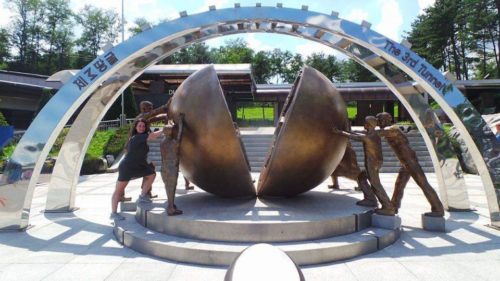
DMZ day tour itinerary
Departure and tunnels.
The DMZ tour from Seoul started with a gathering at the Koridoor Tour office. At the office, guides checked our IDs and clothing, as visitors must be dressed well. After everyone had arrived and signed in, a coach and a guide took us to the third tunnel (DMZ). Here we could walk through the tunnel and learn the history of the war between South and North Korea. The tunnel itself is not much to write home about, but it’s worth checking out.
After the third tunnel, we made a quick stop for a bite to eat at a nearby restaurant. We opted to munch on the sandwiches that we had bought before the tour began. However, the restaurant has plenty of local Korean food to choose from, but this is not included in the cost of the tour.
Dora Observatory
At the observatory, we could peek through the binoculars into a creepy fake North Korean town. Yes, FAKE! No one actually lives there. Our guide told us that North Koreans had built this colourful town and played loud music daily to show South Koreans, and visitors, that they are prosperous and doing well. This was a pretty cool part of the tour and the guide provided us with some very interesting information.
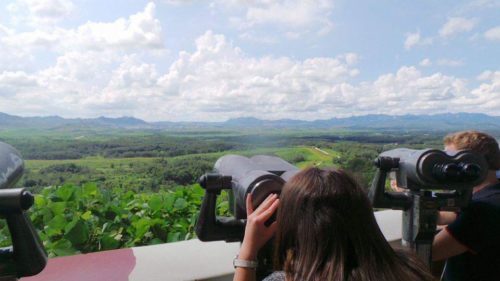
Dorasan Train Station
This part of the tour was very sad and emotional. We could really sense the desperation of South Korea to reunite with their Northern counterparts; so much so, a train station heading to Pyongyang has already been built and the train is sitting waiting to go. Another interesting item at the train station is the small piece of the Berlin Wall that had been donated to South Korea to show hopes of reunification.
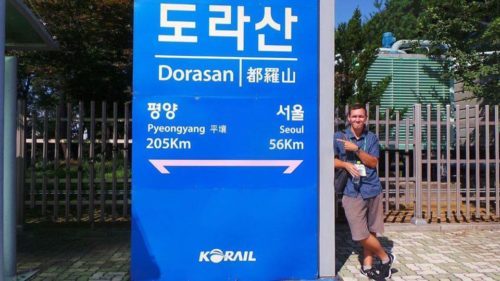
Joint security area
Next up was supposed to be the most exciting part of the trip that everyone had been waiting for; the part where we would step foot into North Korea. As we approached the JSA, our bus pulled over and an American soldier boarded the bus to give us what was supposed to be a briefing. Instead, he told us that the border was now closed to tourists due to an incident that had happened earlier in the day. At this point, we weren’t quite sure if this was a joke or not. But NOPE, unluckily for us, it was not a joke at all.
JSA section cancelled
Instead of going to the JSA, our guide opted to take us all to a nearby park. This was just to waste time, so we fulfilled the tour length. In all honesty, though, I don’t think anyone wanted to do this. At this point, everyone was quite pissed off. When we arrived back at Koridoor’s tour office, surprisingly everyone had already left the office! So, there was no one there to talk to about getting a refund for the JSA section part of the tour.
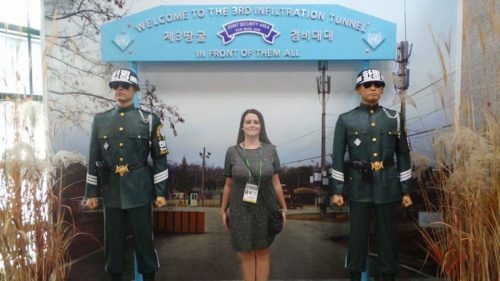
Trying to get a refund
The next day, we went back to the office to speak to the manager about receiving a refund for the part of the tour that was cancelled. Unfortunately, the staff were rude and no longer showed the same enthusiasm as they did when we were making a booking. After asking where $50 per person had been spent, and how it was justifiable for them to keep it, we got nowhere and sadly left feeling robbed.
DMZ tour review conclusion
To conclude this DMZ tour review, the first half of the DMZ tour from Seoul was great. We enjoyed learning the history of the war and how the nation became divided. However, if the JSA section of this tour is high a priority for you, avoid going with cheapskate companies like Koridoor. We completely understand that at such a high-tension border zone, incidents can occur; resulting in border closures at short notice. But to not receive a refund for this was totally unacceptable, particularly after hearing from other travellers that other companies were happy to give refunds. On top of that, the customer service after the tour was totally disappointing and the manager refused to answer some of our questions. All in all, we do recommend taking a tour to the border of North Korea, just make sure to research the tour companies thoroughly beforehand.
Where to stay in Seoul
Feeling luxurious: Royal Hotel Seoul – Has excellent reviews and boats spa and wellness services for you to end your trip in style.
Budget private room: Coups Hotel – Has great modern rooms. The hotel is located just a 10-minute walk away from Changgyeonggung Palace and has excellent metro links
Dorm life: Itaewon Inn – Basic, but super cheap and has good links to the metro system.
For more prices and deals on properties in Seoul, CLICK HERE.
Essential resources for travelling in South Korea
Travel Insurance – No matter where you’re travelling to, it’s a good idea to make sure you’re covered for any accidents or losses. We spent days and weeks searching for insurance, but most insurers would not allow us to take out a policy as we were already abroad. Our personal choice is Safteywing . You can opt for automatic monthly payments, just like a subscription. More importantly, it is available in 180 countries and can be purchased whilst already travelling. There is no cap on the duration of travel.
Visa – Before you travel to any country, make sure to check if you need a visa. iVisa is a fantastic website that is super easy and quick to use. Just type in where you are from. and where you are going. to check if you need a visa. If you do, you can quickly make an application online.
Accommodation – Booking.com is our go-to when looking to pre-book accommodation online. Booking.com tend to almost always have the best rates and a FREE cancellation policy for most properties.
Tours & Activities – If you want to book tours and activities online, make sure to check out Get Your Guide . Get Your Guide takes the stress out of booking activities abroad. You will also find a range of benefits, such as skip-the-line passes, lunch included in your tours, and so much more.
Travel tips ebook -Before you head off on your adventure, make sure to download our free ebook. It has a whopping 109 budget travel tips to help you make your hard-earned cash go further. Click here to download your FREE ebook.
Like this post? Pin it!
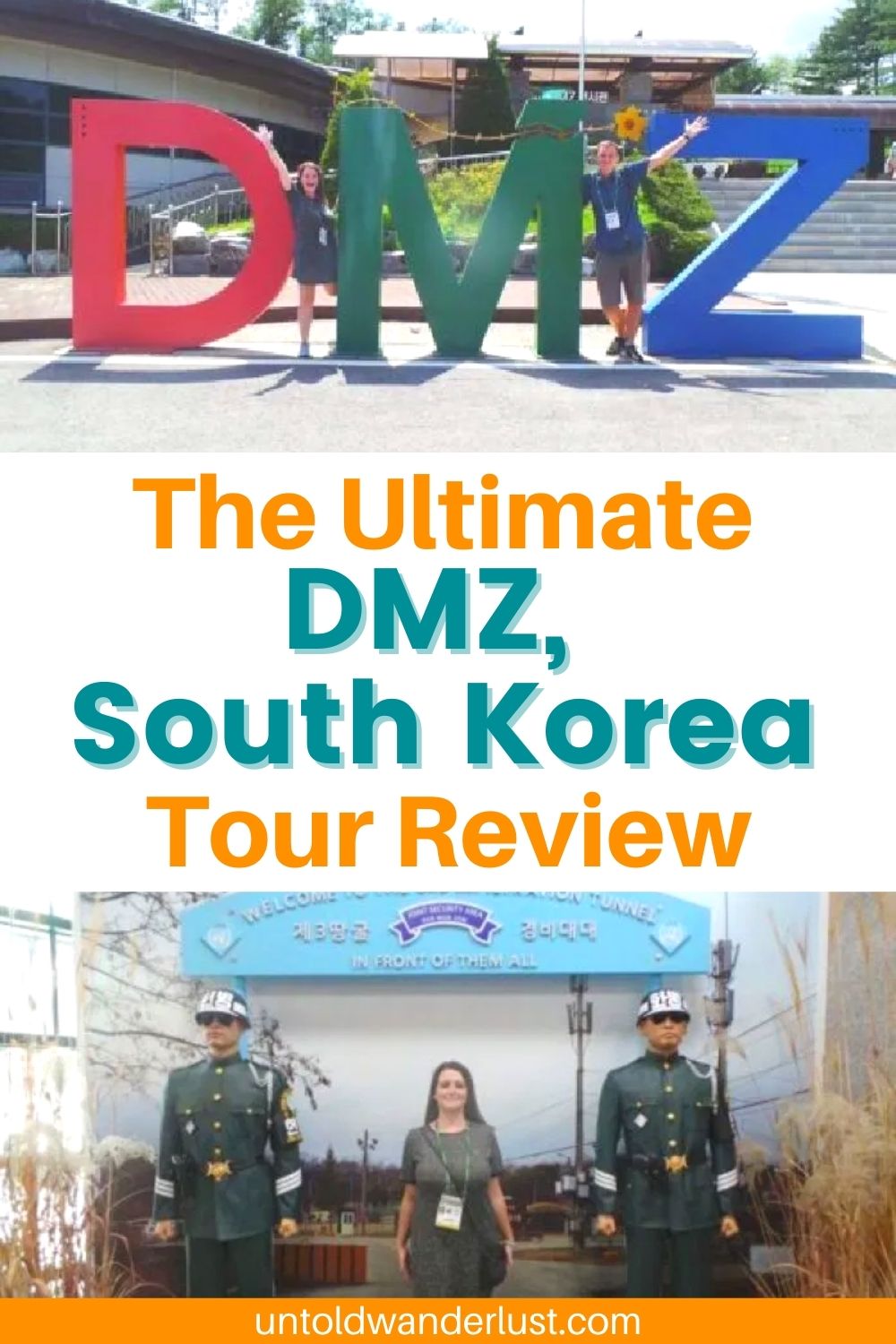
13 thoughts on “ DMZ Tour Review | Everything You Need to Know ”
Hey great pos guys… But mean spirited with the review for Koridoor. I guess having access to JSA revoked at the last minute is beyond anyone’s control and managing your expectations better when undertaking global travel might be required at times. Peace and love x
Hey, thanks for the comment 🙂 yeah we totally understand that with it being such a sensitive area, things like this could happen. The frustrating part was the handling of it afterwards. Especially when other companies that day were issuing. All the best, K & J
Great article! Would love to visit the DMZ since it is such a historically relevant place, thanks for sharing!
Thanks for your comment. The DMZ is definitely interesting and worth the visit.
Hm… very i teresting read. I had no idea about this tours. It was quite an experience for you two.
Thanks for the comment, yes it was a very interesting trip and if you ever go to Seoul, it’s something you should definitely look into doing if you ate interested in the divide between North and South Korea.
i’ve done dmz tour in vietnam, but i’m sure it would be a totally different experience doing it in korea with the north korea situation and all that. i’m so sorry that your tour ended up disappointed by the end of the day, but i could tell you had a great experience beforehand. 🙂
anyway, i’ve also got north korea on my bucket list but i heard to join the tour there is quite expensive. i’m so obsessed to see what’s up with north korean that i am volunteering for asian games in jakarta next year just to see whether i could meet anyone from north korea. 😀
btw, since you mentioned that to do this tour you must dress well, can you tell me what kind of outfit that is recommended or what to avoid if i want to join this tour one day? thank you! 🙂
Yes it was very interesting and even without the JSA part of the tour, it is still totally worth doing.
That’s so cool that you are going to an event in Jakarta, I hope you have the opportunity to speak to someone from North Korea. Apart from actually being there and emmersing yourself into another country, there is no better way to learn about culture and life in another country than to speak to someone who is from there first hand.
As for the dress code, they require you to dress smart/ casual. For example, shoes and not flip-flops. No short shorts/ skirts and no strappy t-shirts and no tracksuits. A nice pair of jeans or a knee length skirt with shoes and you are good to go.
North Korea!!! Oh wow!! Looks amazing. So much culture to experience
Love how you go into detail about each stop…makes me feel like I was there with you! 🙂
Glad you enjoyed the post and felt as though you were apart of the experience:)
Wow, this is so interesting! Of course I have heard of the North Korean government setting up fake businesses and things like that, but I had no idea they built whole fake towns! That is so interesting! And so cool that you got to see that! That is crazy that they didn’t give you a refund for the second half being cut short though! But atleast you still had fun. Now I know we will definitely visit the dmz when we go to South Korea!
Glad we have inspired you to take a trip here. It is certainly very educational and an eye opener to the divide of the two countries. Would love to hear your thoughts on it when you go 🙂
Leave a Reply Cancel reply
You must be logged in to post a comment.
This site uses Akismet to reduce spam. Learn how your comment data is processed .

I visited the DMZ between North and South Korea. The peaceful tour was a stark contrast to the grim reality of the divided peninsula.
- Last month I went on the DMZ Peace Tour in Paju, South Korea.
- Despite being a "demilitarized zone," the DMZ is the most heavily fortified border in the world.
- The peaceful tour was a stark contrast to the grim reality of the divided peninsula.

On June 25, I visited the Demilitarized Zone, or DMZ, between North and South Korea. The day of my visit marked exactly 73 years since the Korean War began in 1950, and the spot I stood at wasn't far from the site where, a couple weeks later, a US soldier would shock the world by darting across the border and defecting into North Korea.
Spanning the 160-mile width of the Korean peninsula, the DMZ is one of the most heavily fortified borders in the world. It was established in 1953 as part of the Korean Armistice Agreement to end the Korean War.
My trip to South Korea was a graduation trip with my five close friends from college. From the start, we knew we wanted to visit Lotte World — a popular theme park — and the BTS bus stop . At one point during our research for the 18-day trip, one of my friends suggested booking a day tour to the DMZ.
In an effort to avoid spending two weeks only focused on shopping and eating, we booked the DMZ Peace Tour on Klook for about $53 USD.
We boarded the tour bus heading for Paju, a city 23 miles northwest of Seoul.
A series of bad decisions the night before — endless shopping and staying up for late-night street snacks — left us feeling sleep-deprived in the morning. After less than three hours on the pillow, we rushed to board the tour bus at 8:30 in the morning.
On the bus, our tour guide Emily Lee began educating us on the history of the Korean War and the DMZ. She spoke in fluent English to our group of about 20 people — ages ranging from early 20s to late 50s — from various parts of the world. She would occasionally slip in a joke or two that would make all of us crack up, shaking off the morning drowsiness.
About 45 minutes later, as we were nearing Imjingak Park, Lee collected our passports — which were needed in order to buy tickets to the DMZ Peace Tour — while passing us a "Team Emily" name-tag to hang around our necks and help prevent us from getting lost.
"Only 40 tour buses are allowed in the DMZ every day," Lee said, adding that since the tickets are issued by arrival, the time at which our DMZ tour starts can only be confirmed at the ticketing office.
Over six million Korean and foreign tourists visit Imjingak Park every year.
Built in 1972 as a consolation to separated families and with hopes of reunification, Imjingak Park is a popular tourist attraction for not only foreigners but also South Koreans.
"Many people come here to bike, or to have a picnic," Lee said.
We had two hours before our designated time for the DMZ tour, so Lee guided us around the war memorials and statues. It was about half past nine in the morning and we followed her along in the sweltering sun.
The first monument we stopped at was one dedicated to a song named "30 Years Lost ."
It was the theme song for "Finding Dispersed Families," a series of special live broadcasts depicting the reunions of war-dispersed families in 1983. Archives of the series were registered as part of the UNESCO "Memory of the World" collection in 2015.
"Would it be tomorrow or the day after tomorrow, 30 years of waiting with tears," a line of the song read.
"The theme song became very popular in North Korea as well," Lee said.
We walked onto the Freedom Bridge next.
The Freedom Bridge was built in 1953 for the sole purpose of allowing 12,773 prisoners of the Korean War to cross over to South Korea. At the end of the bridge stood a barbed wire fence densely covered with prayer-ribbons.
Lee then directed our attention across us to another bridge — the Dokgae Bridge — which used to be a railway bridge that took trains northwards across the Imjin River to the end of North Korea.
"The bridge pier has a lot of bullet marks, which are traces of the Korean war," Lee explained, pointing towards the now-destroyed bridge. Tickets to the bridge pier cost an additional 2,000 Korean won, about $1.60.
Our tour group fell silent whenever Lee explained the gravity of each monument to us. It felt peaceful walking in Imjingak Park, but there was a solemn undertone that followed.
Security at the entrance to the DMZ felt similar to airport immigration customs.
A pair of South Korean soldiers boarded the bus while we had our passports ready in hand. The soldiers verified each and every one of our identities against a names list our tour guide had submitted beforehand.
Taking photos or videos while on the bus ride within the DMZ is also strictly prohibited, so we just enjoyed the scenery while Lee told us the history of our next stop — the 3rd Infiltration Tunnel.
The incomplete 3rd Infiltration Tunnel runs a mile long.
The 3rd Infiltration Tunnel was discovered in 1978 following the detection of an underground explosion. Though incomplete, it's the largest among the four infiltration tunnels that have been discovered in South Korea.
Running a mile long, at 6.5-foot tall and wide, the tunnel is large enough for 30,000 fully-armed North Korean soldiers to pass through within an hour, Lee explained.
We weren't allowed to take any photos inside the tunnel, so we kept our phones in the lockers, popped on safety helmets, and embarked on our descent 240 feet below the ground.
Walking through the cold but well-lit tunnel felt like a weird fever dream. We were stuck in a single file, and for 10 minutes straight we were shuffling forward while crouching — the 6.5-foot height of the tunnel was actually 5 feet due to structural bars on the tunnel ceiling.
Our next stop was the Dora Observatory, where we had an unobstructed view of North Korea.
The Dora Observatory was as close as we could get to North Korea. Just a little over 10 miles north of where we stood was Kaesong, one of three major cities in the country, said Lee.
We headed up to the observation deck where there were several telescopes that visitors could use to observe the nearest part of North Korea in detail.
Having only heard and read about the elusive state, it felt bizarre peering through the telescope.
I saw buildings, vehicles, and roads littering the heavily guarded territory — but it was eerily quiet, not a single person in sight.
North Korea was just miles ahead of us.
On the second level of the observatory, there was an auditorium with floor-to-ceiling glass panels that gave a clear view of the scenic area.
We sat in silence for a while as we took it all in, still feeling surreal about the fact that North Korea was just a few miles ahead of us.
For the last leg of the tour, our bus passed through the Unification Village.
The Unification Village, located 2.7 miles south of the Military Demarcation Line, is home to around 160 families and a total of about 460 residents. It's the biggest of the three villages within the Civilian Control Line, Lee said.
Our bus drove through the quiet, peaceful village, before concluding the tour at the village's souvenir shop and restaurant, where local specialties like sundubu — soft tofu — and seasoned mountain herbs were sold.
As we headed back to Seoul, I felt a mixture of emotions well up inside me.
I had fun on the tour — and at some points it felt reasonably commercialized — yet there was a strong tinge of sorrow in each step of the journey.
Every part of the tour was a silent but grim reminder of the heart-wrenching reality of the divided peninsula, the millions of people who were — and still are — deeply hurt by the Korean War.
"After the Korean War, millions were separated from their families. Randomly, they became North and South Korea," said Lee, "it wasn't their choice, but they haven't met for 70 years."
- Main content
North Korea: what are the DMZ and JSA and what happens on border tours?
- Medium Text
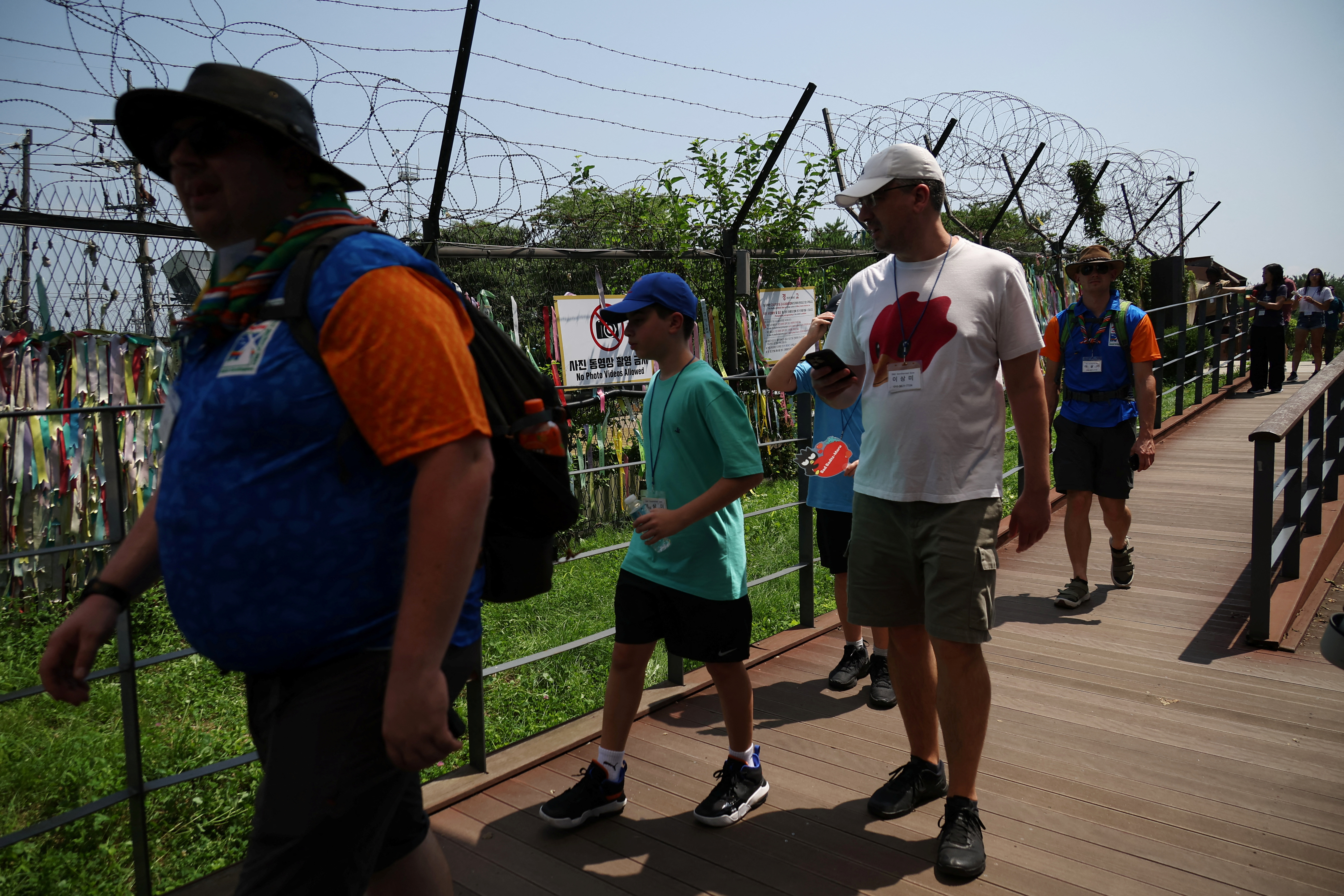
Coming soon: Get the latest news and expert analysis about the state of the global economy with Reuters Econ World. Sign up here.
Reporting by Soo-hyang Choi, Ju-min Park and Minwoo Park in Seoul, Do Gyun Kim and Hongji Kim in Paju; Editing by Ed Davies and Sharon Singleton
Our Standards: The Thomson Reuters Trust Principles. New Tab , opens new tab

World Chevron
Australia pm calls musk 'arrogant billionaire' after court orders x to hide church stabbing posts.
An Australian court has ordered X to hide some posts commenting on the stabbing of a bishop in Sydney, deepening a war of words between the social media platform's owner Elon Musk and Australian Prime Minister Anthony Albanese.
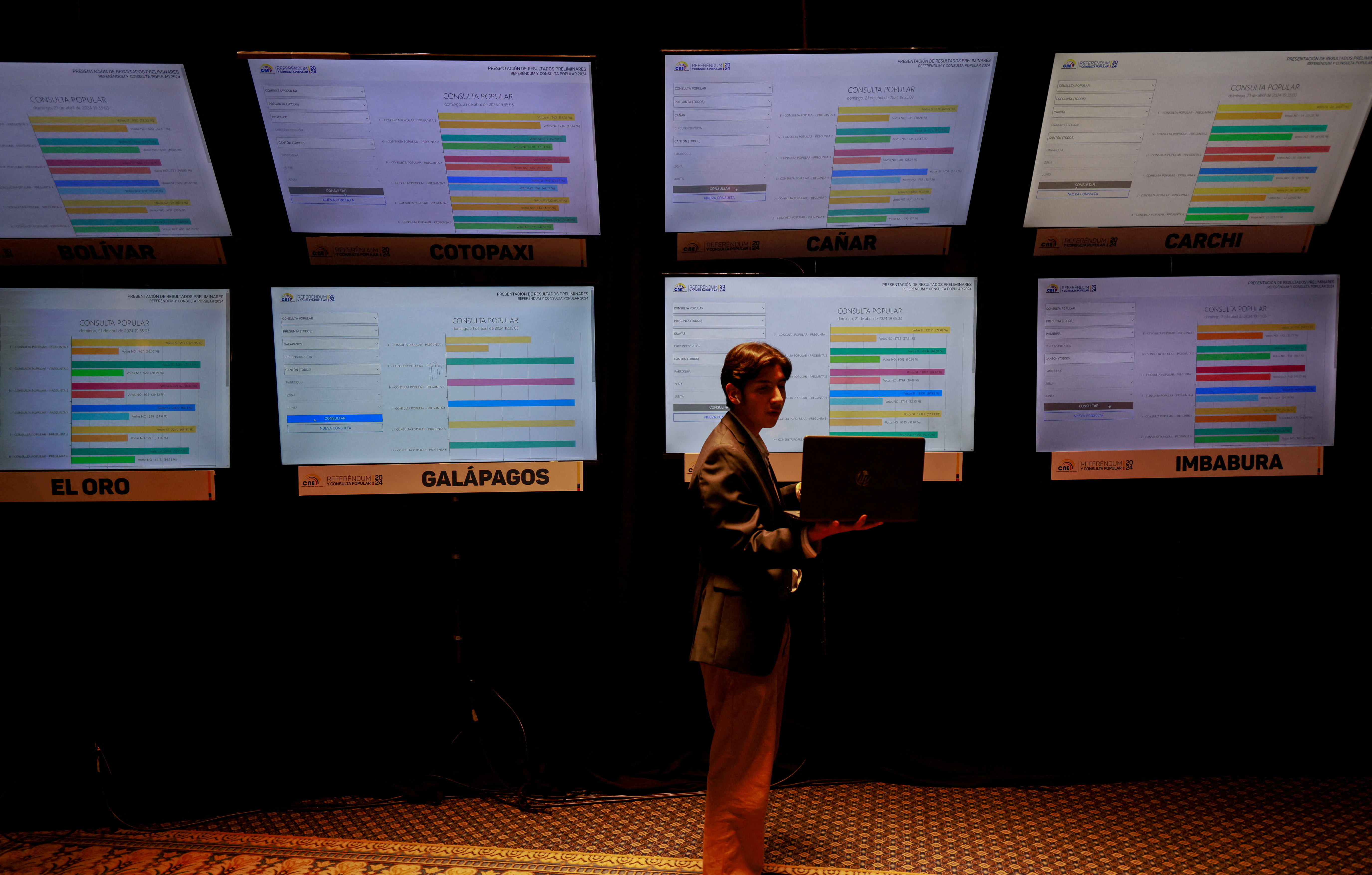
Mexican soldiers arrested Abraham Oseguera, the brother of Nemesio "El Mencho" Oseguera who leads the hyper-violent Jalisco New Generation Cartel (CJNG), officials said on Monday, touting the capture as a major blow to organized crime.

The Budget Savvy Travelers
BREAKING FREE WITHOUT BREAKING THE BUDGET
Home » Experience the Best DMZ Tour to Visit North Korea From Seoul
Experience the Best DMZ Tour to Visit North Korea From Seoul

If you’re planning a trip to South Korea, an unmissable experience is taking a DMZ tour to North Korea. The Demilitarized Zone (DMZ) along the border offers a unique opportunity to step foot into the reclusive nation, learn about the Korean War, and witness the tensions between the two Koreas firsthand.
When traveling to Korea, so much of the history, current events, museums, politics, etc., are related to the sights and locations that are visited on a DMZ tour. Some may say that it would be completely insane not to visit this unique area of the world.
Can we really say we visited North Korea? – The American soldier confidently replied, “Yes.
Best DMZ Tour to Visit North Korea
As an American, visiting the Joint Security Area (JSA) located in Panmunjom is the easiest and safest way to officially say you went to North Korea. We reached out to a popular tour guide in Seoul to help us organize our DMZ tour.

Based on their guidance and our research, this Panmunjom DMZ Tour easily stood out from the competition. Their reviews online are 5 stars and it’s ranked number one on TripAdvisor for things to do.
⚔️ 👨🏻✈️ Panmunjom DMZ Tour > Check Availability
If you’re looking for a private guided tour of the DMZ then you may be interested in the Private DMZ Peace Tour: Korea 3rd Invasion Tunnel and Suspension Bridge tour. Moreover, below are a few other fantastic tours to consider while in Seoul include:
- Full-Day Essential Seoul Tour
- Korean Cooking Class with Full-Course Meal & Local Market Tour
- Drinking and Eating through the Alleys of Seoul
- Pocheon Private Day Tour from Seoul Including Lunch
Visiting North Korea has long been a far-fetched travel idea for many. However, when you’re in South Korea, taking a DMZ tour is an amazing opportunity you don’t want to miss. Here’s why:
- Officially cross the border into North Korean territory at the Joint Security Area (JSA).
- Gain insights into the complex history and current events surrounding the Korean peninsula.
- Witness the stark contrast between the two Koreas up close.
- Learn about daily life in North Korea from a defector’s first-hand account.
- Explore key sites and museums related to the Korean War.

To get an idea of what a tour to the DMZ and JSA is like, we invite you to watch our VLOG below, “We went to North Korea and this is what about happened….” The video will help guide you to the sights and activities that seem the most interesting to you. It’s located at the end of the article.
What Are the DMZ Tour Options?
Depending on the goal of your visit, there are a few different options for tours available. You can check out the VIP Travel website to see what works best for you. Some visitors may want to say they crossed over the border into North Korea, so they sign up for the Best Half Day DMZ Tour from Seoul which includes a visit to the JSA.
Another option is to learn more about the history of the Korean War and visit key sites. In this case, the MDL[Military Demarcation Line] Special Tour may be the best option.

Which Tour Do You Recommend?
We participated in two tours on two different days. After our experience, we agreed that each experience had its highlights and together made up two great days of exploring. If you are short on time, then the Half Day DMZ Tour from Seoul may be a good option as it has all of the main locations in one half-day experience.
Are You Really Technically Visiting North Korea?
When we first shared the news of our visit, a few people on social media claimed that we didn’t actually visit North Korea. We had a feeling someone would try to dispute our claim and try to bring down our bragging rights!
So while on the JSA (Joint Security Area) Tour, we made a point to ask our American military escort, “Can we really say we visited North Korea?” The American soldier confidently replied, “Yes.” (He probably was thinking in his head, “What does she think we’re doing over here? Playing dress-up?!)
Again, you are crossing over the border from the DMZ into North Korean territory. If anyone tries to dispute the claim, tell them that they can take it up with the American military.

Tour With North Korean Defector
There are currently four companies that offer tours out to the JSA and DMZ. However, Cosmojin Tour Consulting is the only company that has a North Korean Defector as part of their tours. One of the unique highlights of our experience was the opportunity to learn, first-hand, about daily life in North Korea and hear about the defector’s actual escape.
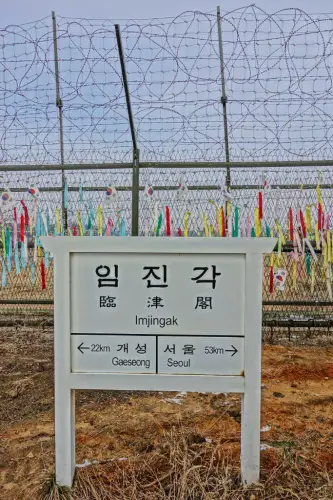
Throughout the day, guests are free to ask the defector questions. This will allow you to gain a personal perspective from someone who still has family separated between the two Koreas. To be in the presence of an actual North Korean defector was an enlightening, yet humbling experience.
Another positive aspect of our tour with the Panmunjom Travel Center was our guide was phenomenal. She was high-energy, very informative, and had a great sense of humor. Also, while at the JSA, she had a great way of making our group feel relaxed. Her enthusiasm and insight provided many directions in the demilitarized zones.

Important Things to Know
- There is a dress code for the day. The following are not allowed: sleeveless shirts, tank tops, jeans with holes, any leather or military patterned clothing, shorts, revealing or skanky clothing, flip flops, or sandals. The T-shirts must be collared.
- There may be times when photo and video opportunities are prohibited as this is a military zone.
- Your tour may be canceled or modified in the event of an unexpected or unsafe condition.
- Contact Panmunjom Travel Center as soon as possible. You need at least 3 days advance notice to be sure to secure your tour.
- You must bring your passport to participate in the tour.
- Bring snacks and water. Lunch comes with the tour but drinks are an extra charge. Water is available at the restaurant for free.
We now have the ultimate bragging rights for our 56th country visited. The Budget Savvy Travelers have officially visited NORTH KOREA! Thank you to Panmunjom Travel Center for getting us there.

Have you taken a DMZ tour to visit North Korea? If so, please share your experience or questions in the comments section below. Feel free to contact us or reach out to Panmunjom Travel Center at [email protected] if you have any questions about taking a tour.

We Need Your Help
Did you find this article helpful? If so, bookmark it and when you’re planning your next vacation click on any of the links below before finalizing reservations. You’ll get the best price, we’ll earn a small commission, and you’ll help support future articles.
BEST TRAVEL SEARCH ENGINES
🏘️ Book Your Accommodation
We use Tripadvisor and Priceline’s Express Deals to compare prices and reviews in advance and check availability
✈️ Book Your Flight in Advance
To find the cheapest flight options, you can use WayAway and Skyscanner to find the most suitable choice for you
🚗 Reserve Your Rental Car
Use DiscoverCars and Skyscanner to compare prices and view the largest selection of vehicles
Share this:
- Click to share on Twitter (Opens in new window)
- Click to share on Facebook (Opens in new window)
- Click to share on Pinterest (Opens in new window)
- Click to share on Telegram (Opens in new window)
- ← Bohol and Panglao Islands – Chocolate Hills, Beautiful Beaches, and More!
- 6 Free and Fascinating Day Trips From Split, Croatia →
Similar Posts

7 Must-Do Things to Do at Chaco Canyon

A time for acknowledgements. Special thanks to…

7 Easy Ways To Save Money on Your Next Vacation Accommodation
7 thoughts on “ experience the best dmz tour to visit north korea from seoul ”.
Very interesting blog. I thought that people do not travel in North Korea. Thanks for sharing! I’m glad I read your story.
Nice entry – I have not visited from the South side but rather from the North …. lots on NK in my own blog (with a few more locations to add yet). Just completed Panmunjom and the DMZ. Actually visiting NK via Pyongyang is not difficult, the biggest issue for most being that it is not cheap.
Thanks for stopping by. For us, money wasn’t the biggest issue…..it was our American passport. We had learned that American and Korean passports are not allowed into North Korea (very easily). I’d like to read more about your deeper travels into North Korea. Can you supply us a link?
Hi – Having an American passport has not been a problem for many years now. About 1/3 of our group of 20 were US citizens and that is about average. There are a small number of restrictions the most notable of which is that US citizens must fly into and out of Pyongyang. You are not permitted to take the train in or out of the country. Off course things are a bit tense at present between US and NK and you might want to consider that. Once you are accepted onto a tour you see and hear the exact same as anyone else on the tour. I make various references to US visitors in my blog. While the anti American rhetoric is relentless all the US citizens on our tour thoroughly enjoyed it. If you enter my blog using this link and go down to North Korea … and follow links from there you can read reviews in a logical order …
https://ramblingwombat.wordpress.com/travel-loops/
Be warned there are a lot of them .. I should add that they are based on what I saw and heard there so, yes, they are totally one sided …I have tried to add a bit of levity here and there …. Any questions you have, just ask .. I keep up to date with NK news..
Above all, enjoy my take on NK and GO!!!!!!!
Thank you for this information! It is helpful to get a first hand account from someone who actually made it in and observed what a typical tour was like. Great information for anyone coming across this tread. I’m sure travelers would seek you out for more Information if considering a tour. After traveling for so long, we’re used to the anti-American rhetoric. It just rolls off our “typical American fat rolls!” Ha ha! Too much? I’ll definitely flag those articles to read. Thanks for sending them. Are you from Australia? Kind regards. -A
I am originally from Northern Ireland which I left in 1989. Apart from just over two years in PNG and three in Fiji I have lived in Australia (now home) since then.
The anti US rhetoric in NK is beyond the imaginable and we all (including those from the US) couldn’t wait to hear what would come next.
Lets hope things always stay calm!
Leave a Reply Cancel reply
- TRAVEL ARTICLES
- BOSNIA AND HERZEGOVINA
- GREAT BRITAIN
- MASSACHUSETTS
- NORTH CAROLINA
- PENNSYLVANIA
- SOUTH CAROLINA
- PHILIPPINES
- SAUDI ARABIA
- UNITED ARAB EMIRATES
- REPUBLIC OF THE CONGO
- SOUTH AFRICA
- AMERICAN SAMOA
- COOK ISLANDS
- NEW ZEALAND
- DOMINICAN REPUBLIC
- PUERTO RICO
- TIPS, TRICKS, AND BUDGET-SAVVINESS
- FIRST 6 MONTHS
- MONTHS 7-10
- MONTHS 11-15
- MONTHS 16-18
- MONTHS 19-24
- PROJECTED ROUTE
- LATEST VLOGS
- EPISODE 1-5: BUENOS AIRES, ARGENTINA
- EPISODE 6: URUGUAY
- EPISODE 7: ANTARCTICA
- EPISODE 8: PATAGONIA
- EPISODE 9: SOUTH AMERICAN WINE COUNTRY
- EPISODE 10: THE COOK ISLANDS
- EPISODE 11: NEW ZEALAND AND AUSTRALIA
- EPISODE 12: INDIA
- EPISODE 13: BORNEO
- EPISODE 14: THAILAND
- SPONSORED CONTENT
- WHY DID WE QUIT OUR JOBS TO TRAVEL?
- OUR PAST TRAVELS

- Destinations
- Travel Checklist
- Travel By Sea (Ferries)
Panmunjom Tour – The North Korean Demilitarized Zone (DMZ)
Table of Contents
About the DMZ
The Demilitarized Zone (DMZ) at Panmunjom is a heavily fortified buffer zone that separates North Korea and South Korea. The 4km wide DMZ stretches 250km (160miles) across the Korean peninsula and was created in 1953 during the armistice after the Korean War. Here I will recount my Panmunjom tour in December 2018.
The DMZ has been the scene of many tense stand-offs between the North and South with soldiers eyeballing each other across the demarcation line. Thankfully, in recent years the situation has improved drastically as tensions have eased between the two Koreas. The Panmunjom DMZ is considered one of the most iconic landmarks in Asia .

I had first read about the Demilitarized Zone in an old copy of National Geographic almost 20 years ago and remember studying the maps and infographics with interest. Little did I imagine that one day I would actually visit the famed 38th Parallel, and from the North Korean side!
Fast forward to winter of 2018 and I was keen to avoid another disappointing Christmas in China . I decided to book onto Young Pioneer Tours’ Christmas tour of the DPRK.
Having visited North Korea once before for a day trip, I was keen to explore the country further. The tour would include a train ride across the country to the capital Pyongyang, the DMZ and the town of Kaesong.
This is my guide to visiting the DMZ from the north side, but there are also many popular tours for visiting the DMZ from South Korea too.
Reunification Arch
After an action-packed few days in Pyongyan g , we left the Ryangang Hotel early for the 3-hour drive south to the border. We made a quick pit-stop at the “Monument to the Three-Point Charter to Reunification” otherwise known as the Reunification Arch.
The arch sits across the reunification highway that leads from Pyongyang to Kaesong. It stretches 55m (180ft) tall and is constructed of grey concrete blocks so beloved of communist dictatorships the world over.

The sun was just rising behind the fields outside Pyongyang and there was no other traffic on the roads lending an eerie, post-apocalyptic feel to the place.
After a ten-minute stop, we were soon on our way again. It was fascinating to get a real glimpse of rural North Korea as we passed through farmland and small villages.
Motorway Services – North Korean Style
It was also impossible to miss the fortifications put in place to halt an advance of enemy troops (South Korean or American) from the south. It reminded me of what our guide told us about the army checkpoints on every bridge we saw on the train.
Every bridge and tunnel is wired with explosives and in the event of an invasion, they would be blown up to prevent the enemy from reaching the capital.
Consequently, every time we passed through a tunnel or over a bridge, I hoped that the soldiers inside their little booths didn’t have itchy trigger fingers!
About halfway into the journey, we stopped at possibly the strangest motorway service station I had ever been in. South Mimms on the M25 it was not! The concrete structure spanning the road looked normal enough, but the very fact that I was in a motorway service station in the DPRK amused me no end.
Inside the building was pretty barren but there was a toilet and stand selling snacks, coffee and commemorative plates featuring the Kim dynasty.
I walked around the car park and snuck past a hedge into a field to snap some photographs but did an about-turn as I saw someone on a ridge looking down. Possibly a farmer, possibly not. Best to take no chances!
After 30 minutes we hit the road again and continued our journey south. As we neared the border the city of Kaesong came into view.
The skyline looked nothing like the utilitarian “workers’ paradise” of Pyongyang and looked a lot more “Korean” with wooden buildings and the distinctive east-Asian rooftops.
Arriving at Panmunjom DMZ
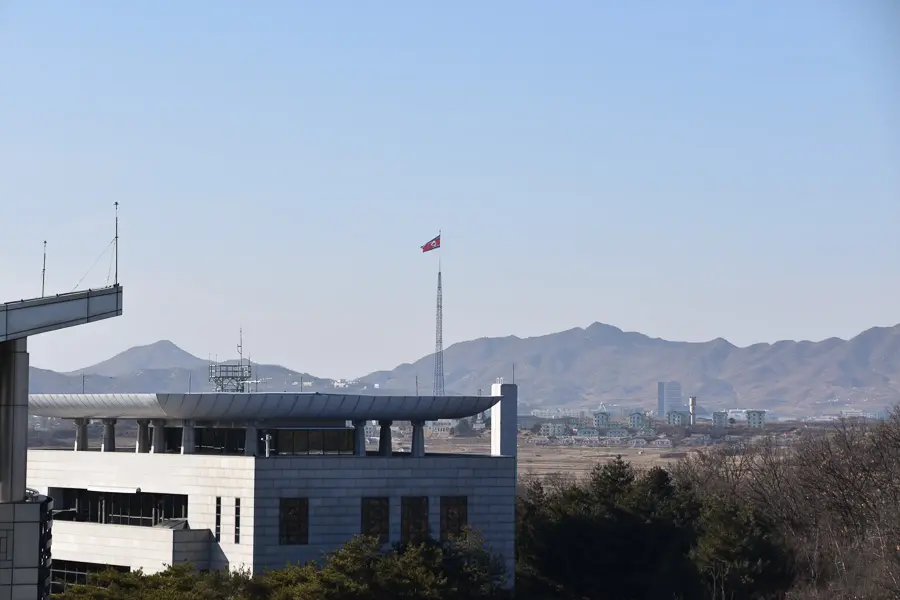
We arrived at the first checkpoint where the bus pulled over and we all got out. There was a stone obelisk with propaganda murals displaying the North’s commitment to reunification.
A solemn finger reached skywards over the top of the Korean peninsula and on the other side two smiling children amidst a sea of flowers.
In front of us was a large gate and high barbed-wire fence. Soldiers strutted around in their new winter uniforms which looked a lot more modern than the old great-coats and Russian-style hats of a few years ago.
I felt a little conspicuous in my combat trousers and British army boots and one of my fellow tourists pointed this out with a grin.
We were led into a building that housed a souvenir shop selling the usual tourist trinkets and Korean alcohol. On sale were also original propaganda posters (hand-painted, not prints) and watercolours of the Korean landscape.
Here we waited for our new guide; an army Major of the Korean People’s Army. He greeted our own Aussie tour guide with genuine warmth and it was strange to see them both joking with each other (under normal circumstances, nothing out of the ordinary, but it’s not really the image of the North Korean military that most people have).
Tour of Panmunjom DMZ
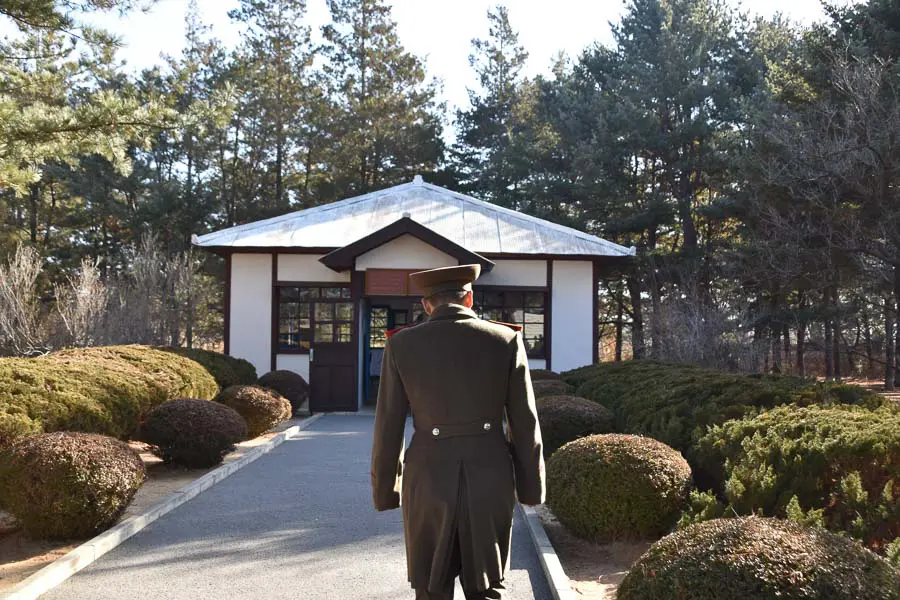
We re-boarded the bus along with the Major and crossed the first of many checkpoints. In the distance, the flag of the DPRK fluttered in the breeze atop its 160m (525ft) flagpole, the fourth highest in the world.
In a strange twist of fate, I’ve also seen the third and fifth highest flags in Azerbaijan and Turkmenistan! I looked out of the window and could see trenches with mannequins dressed in army fatigues holding wooden guns. We soon stopped at a series of whitewashed wooden buildings.
There were watch-towers and radio masts all over and I made sure to ask every time I took a photograph. Our hosts were surprisingly receptive and we had a lot more freedom than I expected (just as in Pyongyang in the days previous).
We followed the army Major and his entourage into the grounds of the huts where he explained their significance in brokering the armistice between the South and America.
As we entered one of the huts there were two flags encased in cabinets; a flag of the DPRK and a tattered “stars and stripes”.
There were fits of suppressed giggles as the translator explained the Major’s words: “If the imperialist USA try to invade again, we will surely crush them”. I laughed not so much at the sentiment, but more so for the hyperbolic language.
The Joint Security Area (JSA) at Panmunjom
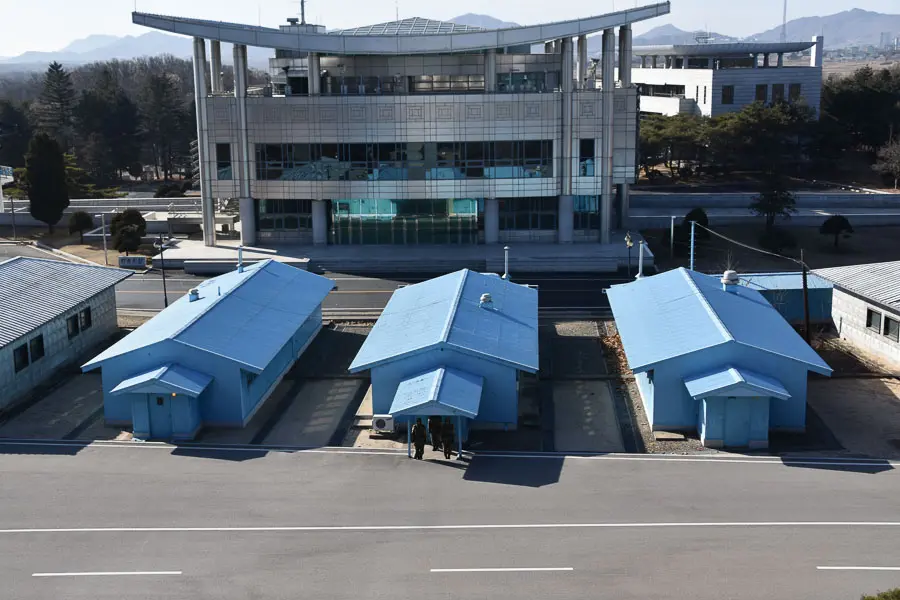
After a tour of the huts, we were back on the bus and crossed another checkpoint before arriving at the Joint Security Area (JSA) also known as Panmunjom.
This area with its bright blue huts is where North and South Korean soldiers have stood in a tense face-off for years. Now though, the South Korean’s have withdrawn troops in an effort to stabilize relations with the North.
We were taken up to the roof of a modern-looking office building from where we could look down to the soldiers marching in step below. Gone are the old soviet-style greatcoats which have been replaced with more modern-looking uniforms. In the distance, the flag of South Korea fluttered in the wind.
We were allowed to snap away at the soldiers and buildings which was surprising, and I even managed to get a picture with the Major which was a real coup!
After 10 minutes or so we boarded the bus and left the area through the same checkpoints to spend a pleasant afternoon in the North Korean city of Kaesong.
About the DMZ Tour

In the past, the situation has been very tense at the DMZ, with propaganda being blared across in both directions via large loudspeakers. Defections from the North and other ‘border incidents’ have done little to ease tensions.
However, things at the DMZ are changing rapidly. Where you could once enter the blue JSA huts and stand astride both Koreas, the South Koreans have locked the doors and left in a gesture of goodwill.
In October 2018, North and South Korean guard posts as well as numerous landmines were destroyed in another act of reconciliation.
With the above in mind, if you wish to take a DMZ tour as it still is in its heavily fortified incarnation, then, now would be the time to visit!
Young Pioneer Tours can arrange group and bespoke tours to the DMZ, so visit while you still can! What’s more, quote TRIPYPT20 and get a free exclusive t-shirt when booking!

About the author: Steve Rohan is a writer from Essex, England. He has traveled to over 60 countries, lived in Armenia, China and Hong Kong, and is now living the digital nomad life on the road.
Steve prefers “slow travel” and has covered much of the world by train, bus and boat. He has been interviewed multiple times by the BBC and recently featured in the documentary Scariest Places in the World . See the About page for more info.
Where I am now: Yerevan, Armenia 🇦🇲
Leave a Reply Cancel reply
Your email address will not be published. Required fields are marked *
STARS AND STRIPES
- Middle East
- Asia-Pacific
- Map Of Memorials
- Entertainment
- - Video Games
- Europe Travel
- - Quick Trips
- - After Hours
- Pacific Travel
- The Meat and Potatoes of Life
- U.S. Travel
- Storm Tracker
- Rewards for readers
- Get Stripes
- Stripes Lite
- Archives/Library
- Special Publications
- Mobile Apps
- Email Newsletters
- Digital Access
- Home Delivery
- Marine Corps
- Coast Guard
- Space Force
- Archive Photo Of The Day
- - Military Matters
- - Force For Hire
- Out of Uniform
- Communities
- Stripes Europe
- Stripes Guam
- Stripes Japan
- Stripes Korea
- Stripes Okinawa
- Our Other Websites
- In Memoriam
- Month of the Military Child
- Best of Germany
- Best of the Pacific
- Letters to Santa
8 tips for enjoying your trip in South Korea

Image: HeungSoon via Pixabay ()
South Korea is a great place to travel. It has a vibrant culture, a welcoming culture, and plenty to see and do.
However, these are the 8 things you should know about traveling in South Korea before you book your flights.
If a Korean person offers you food, it is rude to say no. This is a common custom in South Korea. You should at least try a bite. Here’s what you should know first, though.
The food in Korea is AMAZING!
The food in Korea can be spicy [and doesn’t always agree with foreign stomachs].
Korean friends may invite you to eat with them when you go out drinking. You can’t really refuse.
If you’re invited to the home of a Korean person, bring fruit or dessert as part of your gift.
Many foreigners can enter without a visa This is true for most Western countries, but not all. The United States, Canada, New Zealand, and Australia are just some countries that require a visa to visit South Korea. That said, many people can enter without any issue, including citizens of Japan and Singapore.
A visit to the DMZ is not recommended The demilitarized zone that separates North and South Korea is one of the most highly militarized borders in the world. Many people tour it, but this isn’t something that travel companies recommend doing unless you’re a soldier or have cause to be there for other reasons. It’s not safe.
The internet connection is outstanding South Korea has a truly great internet connection for a country. It’s one of the best in the world. The downside? It’s also very expensive and not always available to use as freely as you would like. At least you can play poker online and FaceTime with your friends and family from anywhere.
Pressing a button for service South Korea can sometimes feel like a Disneyland for adults with so many conveniences. You’ve never lived until you press your floor number on an elevator, have your food brought to your table at a restaurant by pressing a button, or go shopping in a store where you don’t have to pick up your own items (and get out your credit card yourself). Hurray for the future!
Tipping is frowned upon The Korean custom is not to do so at restaurants and for services provided by companies (and most other places). The minimum wage in South Korea is pretty generous, which makes the option of tipping a less socially accepted thing.
Download local apps for directions Google maps are great for most places all over the world, but you won’t be able to access them in South Korea. Instead, download Kakao Maps or Naver Map for directions around South Korea.
Get used to calling people by their English names This is not an insult; Koreans love it when you try to speak Korean with them. However, there are a lot of sounds in the Korean language that simply doesn’t exist in other languages. Many times, foreigners mishear Korean words and call someone the wrong name as a result.
If you meet a Korean person through an introduction, it is perfectly acceptable to call them by their English name from the get-go. It’s actually encouraged! Just try not to forget it later on. You can always ask how to say a name again if you forget after knowing a new friend after a few weeks.
previous coverage
- Popular hotspots around Busan in spring
related stories
- 10 helpful phrases for traveling around Korea
The best stories from the Pacific, in your inbox
Sign up for our weekly newsletter of articles from Japan, Korea, Guam, and Okinawa with travel tips, restaurant reviews, recipes, community and event news, and more.
Sign Up Now
- Foreign Affairs
- Multicultural Community
- Environment & Animals
- Law & Crime
- Health & Science
- Cryptocurrency
- Thoughts of the Times
- Today in History
- Tribune Service
- Blondie & Garfield
- Letter to the Editor
- Travel & Food
- People & Events
- Around Town
- Fortune Telling
- Shows & Dramas
- Theater & Others
- Korean Storytellers

U.S. Ambassador to the United Nations Linda Thomas-Greenfield addresses the United Nations General Assembly during a meeting ahead of the 2nd anniversary of the Russian invasion of Ukraine, at the U.N. headquarters in New York, Feb. 23. Reuters-Yonhap
North Korea on Friday denounced the recent visit to South Korea and Japan by the top U.S. envoy to the United Nations, calling it an "aid-begging" trip to invigorate the "weakened illegal" sanctions against Pyongyang.
Late last month, the U.N. Security Council failed to extend the mandate of the panel of experts monitoring the enforcement of sanctions against the North's nuclear and missile programs due to Russia's veto. The operation of the panel is set to expire on April 30.
Ambassador Linda Thomas-Greenfield made a four-day trip to South Korea before traveling to Japan on Thursday in an apparent move to seek an alternative to the U.N. monitoring panel.
Kim Son-gyong, North Korea's vice foreign minister in charge of international organizations, said Thomas-Greenfield is making the last-ditch effort to continue to "beat the drum of pressure by sewing up a ripped sanctions drum" but will only meet with cold treatment and derision from the international community.
Her trip is "no more than an aid-begging trip of a loser to enliven the weakened illegal sanctions and pressure on the DPRK with the help of inferior allies," Kim said in a statement carried by the North's official Korean Central News Agency, referring to North Korea's official name, the Democratic People's Republic of Korea.
North Korea has been under tightened U.N. sanctions due to its nuclear and missile programs, which call for, among other things, a ban on the country's exports of coal and other mineral resources to cut off its access to hard currency.
During a visit to the Demilitarized Zone (DMZ) separating the two Koreas on Tuesday, Thomas-Greenfield said the U.S. is looking at "out of the box" options with South Korea and others to continue the sanctions monitoring on North Korea.
South Korea's unification ministry said it is not new for North Korea to show a "sensitive" reaction toward the international community's move to handle Pyongyang's reckless nuclear and missile development.
"North Korea should first reflect on itself, surrounded by international condemnation and sanctions, before commenting on issues of other countries," Kim In-ae, deputy spokesperson at the ministry, told a press briefing. (Yonhap)

World Water Day 2024
Busan World Team Table Tennis Championships Finals
Super Bowl 2024
Welcoming Lunar New Year around world
Daily life in Afghanistan under Taliban rule


(LEAD) N. Korea slams U.S. envoy's Asian tour as 'aid-begging' trip to enliven sanctions
(LEAD) N Korea-US envoy
SEOUL, April 19 (Yonhap) -- North Korea on Friday denounced the recent visit to South Korea and Japan by the top U.S. envoy to the United Nations, calling it an "aid-begging" trip to invigorate the "weakened illegal" sanctions against Pyongyang.
Late last month, the U.N. Security Council failed to extend the mandate of the panel of experts monitoring the enforcement of sanctions against the North's nuclear and missile programs due to Russia's veto. The operation of the panel is set to expire on April 30.
Ambassador Linda Thomas-Greenfield made a four-day trip to South Korea before traveling to Japan on Thursday in an apparent move to seek an alternative to the U.N. monitoring panel.
Kim Son-gyong, North Korea's vice foreign minister in charge of international organizations, said Thomas-Greenfield is making the last-ditch effort to continue to "beat the drum of pressure by sewing up a ripped sanctions drum" but will only meet with cold treatment and derision from the international community.
Her trip is "no more than an aid-begging trip of a loser to enliven the weakened illegal sanctions and pressure on the DPRK with the help of inferior allies," Kim said in a statement carried by the North's official Korean Central News Agency, referring to North Korea's official name, the Democratic People's Republic of Korea.
North Korea has been under tightened U.N. sanctions due to its nuclear and missile programs, which call for, among other things, a ban on the country's exports of coal and other mineral resources to cut off its access to hard currency.
During a visit to the Demilitarized Zone (DMZ) separating the two Koreas on Tuesday, Thomas-Greenfield said the U.S. is looking at "out of the box" options with South Korea and others to continue the sanctions monitoring on North Korea.
South Korea's unification ministry said it is not new for North Korea to show a "sensitive" reaction toward the international community's move to handle Pyongyang's reckless nuclear and missile development.
"North Korea should first reflect on itself, surrounded by international condemnation and sanctions, before commenting on issues of other countries," Kim In-ae, deputy spokesperson at the ministry, told a press briefing.


IMAGES
VIDEO
COMMENTS
How DMZ Tours Work. The main DMZ location that you can visit from Seoul is near the city of Paju, which is a one-hour drive north of Seoul. When considering the various Korean DMZ tour options, a key point to understand is that the section from Imjingak Park, which includes a visit to the Third Tunnel and Dora Observatory, is a military-run tour.
Panmunjeom Travel Center Website: www.panmunjomtour.com Telephone: +82-2-771-5593 (Korean, English, Japanese) Price: 80,000-77,000 won (~$60-$77 USD).All tours include lunch. Note: Tours offered in Korean, English, and Japanese.This is the only company that allows you to meet a North Korean defector/refugee, ask them questions, and better understand the human rights issues of North Korea.
Gallery. US$ 36.95US$ 37.25. Select options. Learn more about the history of the Korean War and the Cold War on this educational guided DMZ tour. Places such as Imjingak Park, the Freedom Bridge, the Third Infiltration Tunnel, and the DMZ Exhibition Hall will be visited. Have a bird's eye view of North Korea through the binoculars located on ...
DMZ Tour with Optional North Korean Defector; If you are traveling with a larger family or a group, you could consider a private tour with a guide; JSA Tours: After 2 years of being closed, the JSA is finally reopening. Note that JSA Tours are very popular and are quickly booked up. If you want to visit the JSA you should book your tour as soon ...
Korean Demilitarized Zone (DMZ) and Joint Security Area (JSA) tour from Seoul. See the demarcation of North Korea and South Korea at the infamous border with an expert guide. Visit Imjingak Park, the Freedom Bridge, the 3rd Infiltration Tunnel and the DMZ exhibition hall. Stop by the JSA's Freedom House and learn about Bridge of No Return ...
North Korean Defector Interview: Exclusive chance to make interview with North Korean defector who escaped north korea. Klook's exclusive interview paper is included; DMZ guided tour: Modern Korean War place. Trace modern history. 3rd Infiltration Tunnel: You can enter tunnel,which was made with purpose of Invation to S.Korea at 1978 Dora Observatory: The Northernmost observatory where you ...
Get a complete picture of the DMZ through the eyes of a defector who escaped North Korea on this full-day tour. With a guide, listen to enlightening commentary while exploring highlights, the Dora Observatory for a view of North Korea, the Third Infiltration Tunnel, Imjingak Park, and more. Comprehensive tour of the Korean demilitarized zone.
On this guided tour from Seoul, you'll not only gain access to key sights in the DMZ—including Imjingak Park, the 3rd Infiltration Tunnel, and Dora Observatory—but you also meet a North Korean defector and historic witness to ask questions. Explore the DMZ, an area only accessible as part of guided tours. Visit the 3rd Infiltration Tunnel ...
Overall. Koryo Tours' annual Mega Tour every September is the ultimate journey to North Korea, and our longest and most comprehensive tour to North Korea. We'll travel from Pyongyang, Panmunjom and the DMZ to stunning Mt Paektu, Mt Chilbo, and Mt Kumgang as well as the rarely-visited industrial cities of Chongjin, Hamhung, and Wonsan, plus much ...
Stops include the Third Tunnel, through which North Korea attempted an invasion in 1978, an observation deck that allows you to see across the DMZ and into North Korea. You then stop for lunch before going on to the Red Supension Bridge. Emily was a fantastic tour guide - warm and knowledgeable and made the whole trip very enjoyable.
Gallery. US$ 36.50. Select options. Please make sure to bring the passport with you to enter the DMZ. Having a DMZ Experience while in Korea is the ultimate way to learn about both the North and South. Don't miss the opportunity to visit the historic and mysterious Demilitarized Zone between North and South Korea on our DMZ Half Day tour from ...
The Korean DMZ Peace Train is a tourist train that leaves Seoul and goes to the DMZ. KORAIL runs this train route. There are three routes that the train takes: the Dorasan Security Tour, the Yeoncheon Dreaming Tour, and the Cheorwon Security Tour. Each tour package is a one-day tour that goes both ways.
In South Korea, my visit to the DMZ was a day tour with VIP Travel, considered to be the best DMZ/JSR tour agency in Seoul. The full-day 'DMZ and Panmunjeom Tour' (from 8 am until 5 pm) runs every day (except on Sundays, Mondays, National Holidays, and Military Training Days) and costs 135,000 Korean Won / around $120 US per person.
1. Private DMZ the 3rd Tunnel Tour from Seoul (No Forced Shopping) Tour Highlights: Duration: 8 hours. Departure: Hotel pickup and drop-off available. Departure Time: 7:30, 8:30, 9:30 AM. Includes: Professional English-speaking guide, transportation, all taxes & fees.
Preparing for the DMZ tour from Seoul. The day had arrived, and we were very excited about our trip to the North Korean border. Stupidly, the first time we visited Seoul we didn't realise that we needed to book the DMZ tour a few days in advance. So, when we called a tour agency 2-days before we were due to leave for Japan, we were more than gutted to be told that we can't book a tour at ...
If you'll be visiting South Korea, a tour from Seoul to the DMZ should definitely be on your radar. On a half-day tour in the Demilitarized Zone (DMZ), you can see North Korea from the Dora Observatory rooftop and explore a secret infiltration tunnel built by North Korea, while gaining insight into the history and legacy of the Korean War.
Advertisement. On June 25, I visited the Demilitarized Zone, or DMZ, between North and South Korea. The day of my visit marked exactly 73 years since the Korean War began in 1950, and the spot I ...
Item 1 of 3 Foreign tourists participating in DMZ tour walk past a military fence near the demilitarized zone separating the two Koreas, in Paju, South Korea July 19, 2023.
Best DMZ Tour Korea from Seoul (Red Suspension Bridge Optional) 16,574. See the highlights of the DMZ stress-free on a half-day sightseeing tour from Seoul. After comfortable transfer from convenient pickup locations, your group will visit Imjingak Pyeonghwa-Nuri Park and the Bridge of Freedom.
As an American, visiting the Joint Security Area (JSA) located in Panmunjom is the easiest and safest way to officially say you went to North Korea. We reached out to a popular tour guide in Seoul to help us organize our DMZ tour. The Joint Security Area (JSA) is located at Panmunjom. Based on their guidance and our research, this Panmunjom DMZ ...
DMZ TOUR with Exclusive North Korean Defector Meet-Up . 257. Historical Tours. from . $53.00. per adult. Half Day Korea DMZ Tour (hotel pick up) / opt: suspension bridge. 6. Historical Tours. from . $55.00. per adult. Free style private Tour(Essence of Seoul city or DMZ) 42. Historical Tours. from . $195.00.
The Demilitarized Zone (DMZ) at Panmunjom is a heavily fortified buffer zone that separates North Korea and South Korea. The 4km wide DMZ stretches 250km (160miles) across the Korean peninsula and was created in 1953 during the armistice after the Korean War. Here I will recount my Panmunjom tour in December 2018.
#korea #cycling #dmzHello everyone! In this video I make it back to the Pyeonghwa Nuri Bike Path (평화누리자전거길) which follows the DMZ (Demilitarized Zone) betwee...
A visit to the DMZ is not recommended The demilitarized zone that separates North and South Korea is one of the most highly militarized borders in the world. Many people tour it, but this isn't something that travel companies recommend doing unless you're a soldier or have cause to be there for other reasons. It's not safe.
North Korea on Friday denounced the recent visit to South Korea and Japan by the top U.S. envoy to the United Nations, calling it an 'aid-begging' trip to invigorate the 'weakened illegal ...
SEOUL, April 19 (Yonhap) -- North Korea on Friday denounced the recent visit to South Korea and Japan by the top U.S. envoy to the United Nations, calling it an "aid-begging" trip to invigorate ...